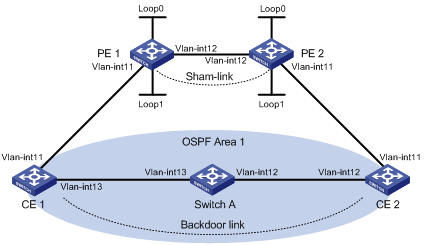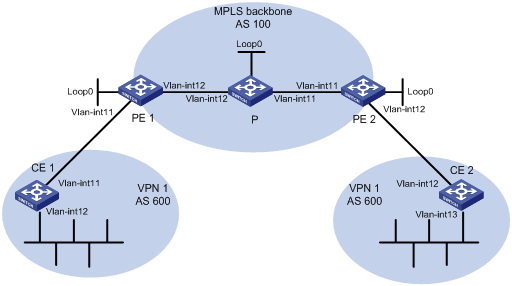- Table of Contents
-
- 08-MPLS Configuration Guide
- 00-Preface
- 01-Basic MPLS configuration
- 02-Static LSP configuration
- 03-LDP configuration
- 04-MPLS TE configuration
- 05-Static CRLSP configuration
- 06-RSVP configuration
- 07-Tunnel policy configuration
- 08-MPLS L3VPN configuration
- 09-MPLS L2VPN configuration
- 10-VPLS configuration
- 11-MPLS OAM configuration
- 12-MCE configuration
- Related Documents
-
| Title | Size | Download |
|---|---|---|
| 08-MPLS L3VPN configuration | 1011.44 KB |
MPLS L3VPN route advertisement
BGP AS number substitution and SoO attribute
Restrictions and guidelines for MPLS L3VPN
MPLS L3VPN configuration task list
Configuring routing between a PE and a CE
Configuring routing between PEs
Configuring BGP VPNv4 route control
Configuring a loopback interface
Redistributing the loopback interface address
Specifying the VPN label processing mode on the egress PE
Configuring BGP AS number substitution and SoO attribute
Configuring the BGP additional path feature
Enabling ECMP VPN route redistribution
About ECMP VPN route redistribution
Enabling SNMP notifications for MPLS L3VPN
Enabling prioritized withdrawal of specific routes
Enabling logging for BGP route flapping
Displaying and maintaining MPLS L3VPN
MPLS L3VPN configuration examples
Configuring a hub-spoke network
Configuring MPLS L3VPN inter-AS option A
Configuring MPLS L3VPN inter-AS option B
Configuring MPLS L3VPN inter-AS option C
Configuring BGP AS number substitution
Configuring BGP AS number substitution and SoO attribute
Configuring MPLS L3VPN FRR through VPNv4 route backup for a VPNv4 route
Configuring MPLS L3VPN FRR through VPNv4 route backup for an IPv4 route
Configuring MPLS L3VPN FRR through IPv4 route backup for a VPNv4 route
Configuring MPLS L3VPN
Overview
MPLS L3VPN is a L3VPN technology used to interconnect geographically dispersed VPN sites. MPLS L3VPN uses BGP to advertise VPN routes and uses MPLS to forward VPN packets over a service provider backbone.
MPLS L3VPN provides flexible networking modes, excellent scalability, and convenient support for MPLS QoS and MPLS TE.
Basic MPLS L3VPN architecture
Figure 1 Basic MPLS L3VPN architecture
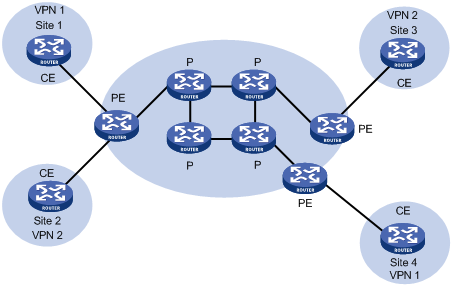
A basic MPLS L3VPN architecture has the following types of devices:
· Customer edge device—A CE device resides on a customer network and has one or more interfaces directly connected to a service provider network. It does not support MPLS.
· Provider edge device—A PE device resides at the edge of a service provider network and is connected to one or more CEs. All MPLS VPN services are processed on PEs.
· Provider device—A P device is a core device on a service provider network. It is not directly connected to any CEs. A P device has only basic MPLS forwarding capability and does not handle VPN routing information.
MPLS L3VPN concepts
Site
A site has the following features:
· A site is a group of IP systems with IP connectivity that does not rely on any service provider networks.
· The classification of a site depends on the topology relationship of the devices, rather than the geographical positions. However, the devices at a site are, in most cases, adjacent to each other geographically.
· The devices at a site can belong to multiple VPNs, which means that a site can belong to multiple VPNs.
· A site is connected to a provider network through one or more CEs. A site can contain multiple CEs, but a CE can belong to only one site.
Sites connected to the same provider network can be classified into different sets by policies. Only the sites in the same set can access each other through the provider network. Such a set is called a VPN.
VPN instance
VPN instances implement route isolation, data independence, and data security for VPNs.
A VPN instance has the following components:
· A separate Label Forwarding Information Base (LFIB).
· An IP routing table.
· Interfaces bound to the VPN instance.
· VPN instance administration information, including route distinguishers (RDs), route targets (RTs), and route filtering policies.
To associate a site with a VPN instance, bind the VPN instance to the PE's interface connected to the site. A site can be associated with only one VPN instance, and different sites can be associated with the same VPN instance. A VPN instance contains the VPN membership and routing rules of associated sites.
VPN-IPv4 address
Each VPN independently manages its address space. The address spaces of VPNs might overlap. For example, if both VPN 1 and VPN 2 use the addresses on subnet 10.110.10.0/24, address space overlapping occurs.
BGP cannot process overlapping VPN address spaces. For example, if both VPN 1 and VPN 2 use the subnet 10.110.10.0/24 and each advertise a route destined for the subnet, BGP selects only one of them. This results in the loss of the other route.
Multiprotocol BGP (MP-BGP) can solve this problem by advertising VPN-IPv4 addresses (also called VPNv4 addresses).
Figure 2 VPN-IPv4 address structure

As shown in Figure 2, a VPN-IPv4 address consists of 12 bytes. The first eight bytes represent the RD, followed by a four-byte IPv4 prefix. The RD and the IPv4 prefix form a unique VPN-IPv4 prefix.
An RD can be in one of the following formats:
· When the Type field is 0, the Administrator subfield occupies two bytes, the Assigned number subfield occupies four bytes, and the RD format is 16-bit AS number:32-bit user-defined number. For example, 100:1.
· When the Type field is 1, the Administrator subfield occupies four bytes, the Assigned number subfield occupies two bytes, and the RD format is 32-bit IPv4 address:16-bit user-defined number. For example, 172.1.1.1:1.
· When the Type field is 2, the Administrator subfield occupies four bytes, the Assigned number subfield occupies two bytes, and the RD format is 32-bit AS number:16-bit user-defined number, where the minimum value of the AS number is 65536. For example, 65536:1.
To guarantee global uniqueness for a VPN-IPv4 address, do not set the Administrator subfield to any private AS number or private IP address.
Route target attribute
MPLS L3VPN uses route target community attributes to control the advertisement of VPN routing information. A VPN instance on a PE supports the following types of route target attributes:
· Export target attribute—A PE sets the export target attribute for VPN-IPv4 routes learned from directly connected sites before advertising them to other PEs.
· Import target attribute—A PE checks the export target attribute of VPN-IPv4 routes received from other PEs. If the export target attribute matches the import target attribute of a VPN instance, the PE adds the routes to the routing table of the VPN instance.
Route target attributes define which sites can receive VPN-IPv4 routes, and from which sites a PE can receive routes.
Like RDs, route target attributes can be one of the following formats:
· 16-bit AS number:32-bit user-defined number. For example, 100:1.
· 32-bit IPv4 address:16-bit user-defined number. For example, 172.1.1.1:1.
· 32-bit AS number:16-bit user-defined number, where the minimum value of the AS number is 65536. For example, 65536:1.
MP-BGP
MP-BGP supports multiple address families, including IPv4 multicast, IPv6 unicast, IPv6 multicast, and VPN-IPv4 address families.
In MPLS L3VPN, MP-BGP advertises VPN-IPv4 routes for VPN sites between PEs.
MPLS L3VPN route advertisement
In a basic MPLS L3VPN, CEs and PEs are responsible for advertising VPN routing information. P routers maintain only the routes within the backbone. A PE maintains only routing information for directly connected VPNs, rather than for all VPNs.
VPN routing information is advertised from the local CE to the remote CE by using the following process:
1. From the local CE to the ingress PE:
The CE advertises standard IPv4 routing information to the ingress PE over a static route, RIP route, OSPF route, IS-IS route, EBGP route, or IBGP route.
2. From the ingress PE to the egress PE:
The ingress PE performs the following operations:
a. Adds RDs and route target attributes to these standard IPv4 routes to create VPN-IPv4 routes.
b. Saves the VPN-IPv4 routes to the routing table of the VPN instance created for the CE.
c. Advertises the VPN-IPv4 routes to the egress PE through MP-BGP.
3. From the egress PE to the remote CE:
After receiving the VPN-IPv4 routes, the egress PE performs the following operations:
a. Compares the routes' export target attributes with the local import target attributes.
b. Adds the routes to the routing table of the VPN instance if the export and local import target attributes match each other.
c. Restores the VPN-IPv4 routes to the original IPv4 routes.
d. Advertises those routes to the connected CE over a static route, RIP route, OSPF route, IS-IS route, EBGP route, or IBGP route.
MPLS L3VPN packet forwarding
In a basic MPLS L3VPN (within a single AS), a PE adds the following information into VPN packets:
· Outer tag—Identifies the public tunnel from the local PE to the remote PE. The public tunnel can be an LSP or an MPLS TE tunnel. Based on the outer tag, a VPN packet can be forwarded along the public tunnel to the remote PE. For an LSP or MPLS TE tunnel, the outer tag is an MPLS label.
· Inner label—Identifies the remote VPN site. The remote PE uses the inner label to forward packets to the target VPN site. MP-BGP advertises inner labels for VPN-IPv4 routes among PEs.
Figure 3 VPN packet forwarding
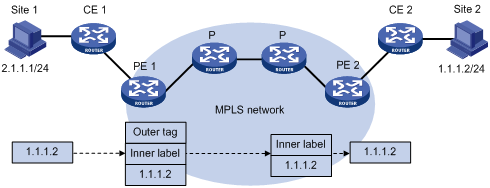
As shown in Figure 3, a VPN packet is forwarded from Site 1 to Site 2 by using the following process:
1. Site 1 sends an IP packet with the destination address 1.1.1.2. CE 1 transmits the packet to PE 1.
2. PE 1 performs the following operations:
a. Finds the matching VPN route based on the inbound interface and destination address of the packet.
b. Labels the packet with both the inner label and the outer tag.
c. Forwards the packet to the public tunnel.
3. P devices forward the packet to PE 2 by the outer tag.
The MPLS label is removed from the packet at the penultimate hop.
4. PE 2 performs the following operations:
a. Uses the inner label to find the matching VPN instance to which the destination address of the packet belongs.
b. Looks up the routing table of the VPN instance for the output interface.
c. Removes the inner label and forwards the packet out of the interface to CE 2.
5. CE 2 transmits the packet to the destination through IP forwarding.
When two sites of a VPN are connected to the same PE, the PE directly forwards packets between the two sites through the VPN routing table without adding any tag or label.
MPLS L3VPN networking schemes
In MPLS L3VPNs, route target attributes are used to control the advertisement and reception of VPN routes between sites. They work independently and can be configured with multiple values to support flexible VPN access control and implement multiple types of VPN networking schemes.
Basic VPN networking scheme
In the simplest case, all users in a VPN form a closed user group. They can forward traffic to each other but cannot communicate with any user outside the VPN.
For the basic VPN networking scheme, you must assign a route target to each VPN for identifying the export target attribute and import target attribute of the VPN. Moreover, this route target cannot be used by any other VPNs.
Figure 4 Network diagram for basic VPN networking scheme
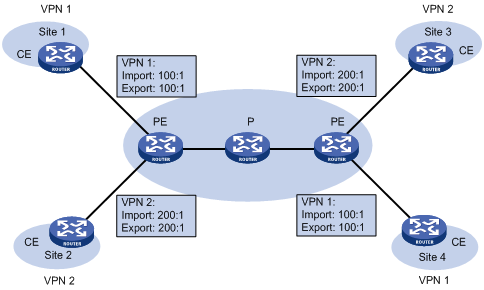
As shown in Figure 4, the route target for VPN 1 is 100:1, while that for VPN 2 is 200:1. The two VPN 1 sites can communicate with each other, and the two VPN 2 sites can communicate with each other. However, the VPN 1 sites cannot communicate with the VPN 2 sites.
Hub and spoke networking scheme
The hub and spoke networking scheme is suitable for a VPN where all users must communicate with each other through an access control device.
In a hub and spoke network as shown in Figure 5, configure route targets as follows:
· On spoke PEs (PEs connected to spoke sites), set the export target to Spoke and the import target to Hub.
· On the hub PE (PE connected to the hub site), use two interfaces that each belong to a different VPN instance to connect the hub CE. One VPN instance receives routes from spoke PEs and has the import target set to Spoke. The other VPN instance advertises routes to spoke PEs and has the export target set to Hub.
These route targets rules produce the following results:
· The hub PE can receive all VPN-IPv4 routes from spoke PEs.
· All spoke PEs can receive VPN-IPv4 routes advertised by the hub PE.
· The hub PE advertises the routes learned from a spoke PE to the other spoke PEs so the spoke sites can communicate with each other through the hub site.
· The import target attribute of a spoke PE is different from the export target attribute of any other spoke PE. Any two spoke PEs do not directly advertise VPN-IPv4 routes to each other. Therefore, they cannot directly access each other.
Figure 5 Network diagram for hub and spoke network
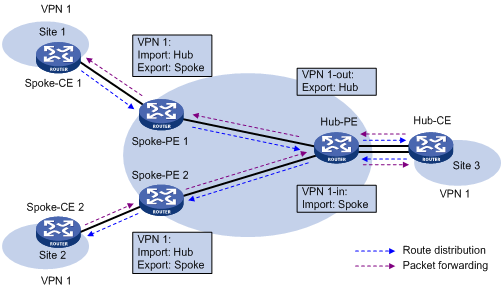
A route in Site 1 is advertised to Site 2 by using the following process:
1. Spoke-CE 1 advertises a route in Site 1 to Spoke-PE 1.
2. Spoke-PE 1 changes the route to a VPN-IPv4 route and advertises the VPN-IPv4 route to Hub-PE through MP-BGP.
3. Hub-PE adds the VPN-IPv4 route into the routing table of VPN 1-in, changes it to the original IPv4 route, and advertises the IPv4 route to Hub-CE.
4. Hub-CE advertises the IPv4 route back to Hub-PE.
5. Hub-PE adds the IPv4 route to the routing table of VPN 1-out, changes it to a VPN-IPv4 route, and advertises the VPN-IPv4 route to Spoke-PE 2 through MP-BGP.
6. Spoke-PE 2 changes the VPN-IPv4 route to the original IPv4 route, and advertises the IPv4 route to Site 2.
After spoke sites exchange routes through the hub site, they can communicate with each other through the hub site.
Extranet networking scheme
The extranet networking scheme allows specific resources in a VPN to be accessed by users not in the VPN.
In this networking scheme, if a VPN instance needs to access a shared site, the export target attribute and the import target attribute of the VPN instance must be contained in the import target attribute and the export target attribute of the VPN instance of the shared site, respectively.
Figure 6 Network diagram for extranet networking scheme
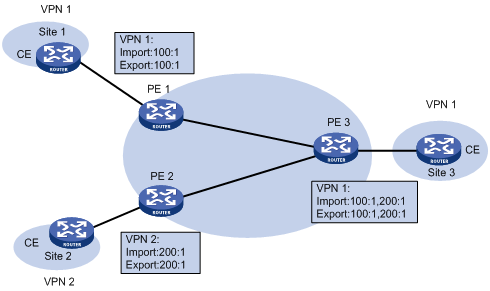
As shown in Figure 6, route targets configured on PEs produce the following results:
· PE 3 can receive VPN-IPv4 routes from PE 1 and PE 2.
· PE 1 and PE 2 can receive VPN-IPv4 routes advertised by PE 3.
· Site 1 and Site 3 of VPN 1 can communicate with each other, and Site 2 of VPN 2 and Site 3 of VPN 1 can communicate with each other.
· PE 3 advertises neither the VPN-IPv4 routes received from PE 1 to PE 2 nor the VPN-IPv4 routes received from PE 2 to PE 1 (routes learned from an IBGP neighbor are not advertised to any other IBGP neighbor). Therefore, Site 1 of VPN 1 and Site 2 of VPN 2 cannot communicate with each other.
Inter-AS VPN
In an inter-AS VPN networking scenario, multiple sites of a VPN are connected to multiple ISPs in different ASs, or to multiple ASs of an ISP.
Inter AS-VPN provides the following solutions:
· VRF-to-VRF connections between ASBRs—This solution is also called inter-AS option A.
· EBGP redistribution of labeled VPN-IPv4 routes between ASBRs—ASBRs advertise VPN-IPv4 routes to each other through MP-EBGP. This solution is also called inter-AS option B.
· Multihop EBGP redistribution of labeled VPN-IPv4 routes between PE routers—PEs advertise VPN-IPv4 routes to each other through MP-EBGP. This solution is also called inter-AS option C.
Inter-AS option A
In this solution, PEs of two ASs are directly connected, and each PE is also the ASBR of its AS. Each PE treats the other as a CE and advertises unlabeled IPv4 unicast routes through EBGP. The PEs associate a VPN instance with a minimum of one interface.
Figure 7 Network diagram for inter-AS option A
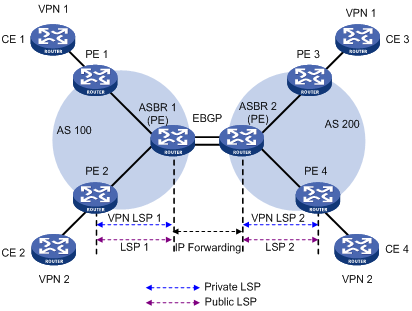
As shown in Figure 7, in VPN 1, routes are advertised from CE 1 to CE 3 by using the following process:
1. PE 1 advertises the VPN routes learned from CE 1 to ASBR 1 through MP-IBGP.
2. ASBR 1 performs the following operations:
a. Adds the routes to the routing table of the VPN instance whose import target attribute matches the export target attribute of the routes.
b. Advertises the routes as IPv4 unicast routes to its CE (ASBR 2) through EBGP.
3. ASBR 2 adds the IPv4 unicast routes to the routing table of the VPN instance that is bound to the receiving interface, and advertises the routes to PE 3 through MP-IBGP.
4. PE 3 advertises the received routes to CE 3.
Packets forwarded within an AS are VPN packets that carry two labels. Packets forwarded between ASBRs are common IP packets.
Inter-AS option A is easy to carry out because no special configuration is required on the PEs acting as the ASBRs.
However, it has limited scalability because the PEs acting as the ASBRs must manage all the VPN routes and create VPN instances on a per-VPN basis. This leads to excessive VPN-IPv4 routes on the PEs. Associating a separate interface with each VPN also requires additional system resources.
Inter-AS option B
In this solution, two ASBRs use MP-EBGP to exchange VPN-IPv4 routes that they obtain from the PEs in their respective ASs.
Figure 8 Network diagram for inter-AS option B
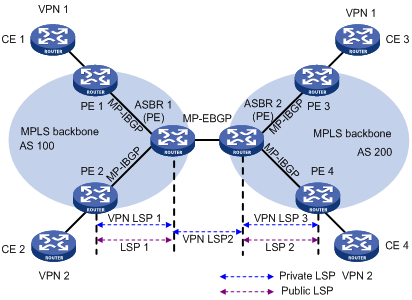
As shown in Figure 8, in VPN 1, routes are advertised from CE 1 to CE 3 by using the following process:
1. PE 1 advertises the VPN routes learned from CE 1 to ASBR 1 through MP-IBGP.
Assume that the inner label assigned by PE 1 for the routes is L1.
2. ASBR 1 advertises the VPN-IPv4 routes to ASBR 2 through MP-EBGP.
Before advertising the routes, ASBR 1 modifies the next hop as its own address, assigns a new inner label (L2) to the routes, and associates L1 with L2.
3. ASBR 2 advertises the VPN-IPv4 routes to PE 3 through MP-IBGP.
Before advertising the routes, ASBR 2 modifies the next hop as its own address, assigns a new inner label (L3) to the routes, and associates L2 with L3.
4. PE 3 advertises the received routes to CE 3.
A packet is forwarded from CE 3 to CE 1 by using the following process:
1. PE 3 encapsulates the received packet with two labels, and forwards the encapsulated packet to ASBR 2.
One of the labels is L3, and the other is the outer tag for the public tunnel from PE 3 to ASBR 2.
2. ASBR 2 removes the outer tag, replaces L3 with L2, and forwards the packet to ASBR 1.
Packets between ASBR 1 and ASBR 2 carry only one inner label.
3. ASBR 1 replaces L2 with L1, adds the outer tag of the public tunnel from ASBR 1 to PE 1, and forwards the packet to PE 1.
4. PE 1 removes the inner label and outer tag and forwards the packet to CE 1.
In this solution, ASBRs must receive all inter-AS VPN routes. Therefore, ASBRs cannot filter incoming VPN-IPv4 routes by route targets.
Inter-AS option B has better scalability than option A. However, it requires that ASBRs maintain and advertise VPN routes.
Inter-AS option C
The Inter-AS option A and option B solutions require that the ASBRs maintain and advertise VPN-IPv4 routes. When every AS needs to exchange a great amount of VPN routes, the ASBRs might become bottlenecks, which hinders network extension. Inter-AS option C has better scalability because it makes PEs directly exchange VPN-IPv4 routes.
In this solution, PEs exchange VPN-IPv4 routes over a multihop MP-EBGP session. Each PE must have a route to the peer PE and a label for the route so that the inter-AS public tunnel between the PEs can be set up. Inter-AS option C sets up a public tunnel by using the following methods:
· A label distribution protocol within the AS, for example, LDP.
· Labeled IPv4 unicast route advertisement by ASBRs through BGP.
Labeled IPv4 unicast route advertisement refers to the process of assigning MPLS labels to IPv4 unicast routes and advertising IPv4 unicast routes and their labels.
Figure 9 Network diagram for inter-AS option C
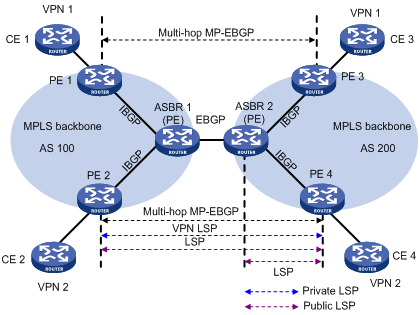
As shown in Figure 9, in VPN 1, routes are advertised from CE 1 to CE 3 by using the following process:
1. PE 1 advertises the VPN routes learned from CE 1 as VPN-IPv4 routes to PE 3 through multihop MP-EBGP.
Assume that the inner label assigned by PE 1 for the routes is Lx.
2. PE 3 advertises the received routes to CE 3.
Setting up an inter-AS public tunnel is difficult in this solution. A public tunnel, for example, the one from PE 3 to PE 1, is set up by using the following process:
1. Within AS 100, the public tunnel from ASBR 1 to PE 1 is set up by using a label distribution protocol, for example, LDP.
Assume that the outgoing label for the public tunnel on ASBR 1 is L1.
2. ASBR 1 advertises labeled IPv4 unicast routes to ASBR 2 through EBGP.
The route destined for PE 1 and the label (L2) assigned by ASBR 1 for the route are advertised from ASBR 1 to ASBR 2. The next hop of the route is ASBR 1. The public tunnel from ASBR 2 to ASBR 1 is set up. The incoming label for the public tunnel on ASBR 1 is L2.
3. ASBR 2 advertises labeled IPv4 unicast routes to PE 3 through IBGP.
The route destined for PE 1 and the label (L3) assigned by ASBR 2 for the route are advertised from ASBR 2 to PE 3. The next hop for the route is ASBR 2. The public tunnel from PE 3 to ASBR 2 is set up. The incoming label for the public tunnel on ASBR 2 is L3, and the outgoing label is L2.
4. MPLS packets cannot be forwarded directly from PE 3 to ASBR 2. Within AS 200, the public tunnel from PE 3 to ASBR 2 is required to be set up hop by hop through a label distribution protocol, for example, LDP.
Assume that the outgoing label for the public tunnel on PE 3 is Lv.
After route advertisement and public tunnel setup, a packet is forwarded from CE 3 to CE 1 by using the following process:
1. PE 3 performs the following routing table lookups for the packet:
a. Finds a matching route with next hop PE 1 and inner label Lx, and encapsulates the packet with label Lx.
b. Finds the route to PE 1 with next hop ASBR 2 and label L3, and encapsulates the packet with label L3 as the outer label.
c. Finds the route to ASBR 2 with outgoing label Lv, and encapsulates the packet with label Lv as the outmost label.
2. AS 200 transmits the packet to ASBR 2 by the outmost label.
3. ASBR 2 removes the outmost label, replaces L3 with L2, and forwards the packet to ASBR 1.
4. ASBR 1 replaces L2 with L1, and forwards the packet.
5. AS 100 transmits the packet to PE 1 by the outer label.
6. PE 1 removes the outer label, and forwards the packet to CE 1 according to the inner label Lx.
As shown in Figure 10, to improve scalability, you can specify a route reflector (RR) in each AS to exchange VPN-IPv4 routes with PEs in the same AS. The RR in each AS maintains all VPN-IPv4 routes. The RRs in two ASs establish a multihop MP-EBGP session to advertise VPN-IPv4 routes.
Figure 10 Network diagram for inter-AS option C using RRs
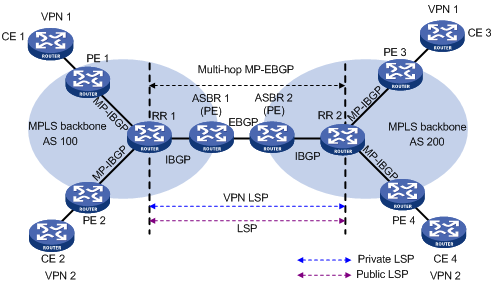
OSPF VPN extension
This section describes the OSPF VPN extension. For more information about OSPF, see Layer 3—IP Routing Configuration Guide.
OSPF for VPNs on a PE
If OSPF runs between a CE and a PE to exchange VPN routes, the PE must support multiple OSPF instances to create independent routing tables for VPN instances. Each OSPF process is bound to a VPN instance. Routes learned by an OSPF process are added into the routing table of the bound VPN instance.
OSPF area configuration between a PE and a CE
The OSPF area between a PE and a CE can be either a non-backbone area or a backbone area.
In the OSPF VPN extension application, the MPLS VPN backbone is considered the backbone area (area 0). The area 0 of each site must be connected to the MPLS VPN backbone (physically connected or logically connected through a virtual link) because OSPF requires that the backbone area be contiguous.
BGP/OSPF interaction
If OSPF runs between PEs and CEs, each PE redistributes BGP routes to OSPF and advertises the routes to CEs through OSPF. OSPF considers the routes redistributed from BGP as external routes but the OSPF routes actually belong to the same OSPF domain. This problem can be resolved by configuring the same domain ID for sites in an OSPF domain.
Figure 11 Network diagram for BGP/OSPF interaction
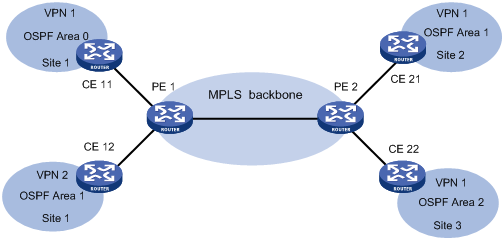
As shown in Figure 11, CE 11, CE 21, and CE 22 belong to the same VPN and the same OSPF domain.
Before domain ID configuration, VPN 1 routes are advertised from CE 11 to CE 21 and CE 22 by using the following process:
1. PE 1 redistributes OSPF routes from CE 11 into BGP, and advertises the VPN routes to PE 2 through BGP.
2. PE 2 redistributes the BGP routes to OSPF, and advertises them to CE 21 and CE 22 in AS External LSAs (Type 5) or NSSA External LSAs (Type 7).
After domain ID configuration, VPN 1 routes are advertised from CE 11 to CE 21 and CE 22 by using the following process:
1. PE 1 redistributes OSPF routes into BGP, adds the domain ID to the redistributed BGP VPNv4 routes as a BGP extended community attribute, and advertises the routes to PE 2.
2. PE 2 compares the domain ID in the received routes with the locally configured domain ID. If they are the same and the received routes are intra-area or inter-area routes, OSPF advertises these routes in Network Summary LSAs (Type 3). Otherwise, OSPF advertises these routes in AS External LSAs (Type 5) or NSSA External LSAs (Type 7).
Routing loop avoidance
Figure 12 Network diagram for routing loop avoidance
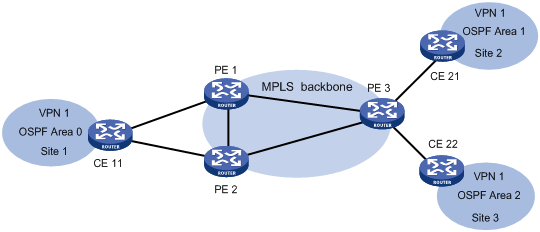
As shown in Figure 12, Site 1 is connected to two PEs. When a PE advertises VPN routes learned from MP-BGP to Site 1 through OSPF, the routes might be received by the other PE. This results in a routing loop.
OSPF VPN extension uses the following tags to avoid routing loops:
· DN bit (for Type 3 LSAs)—When a PE redistributes BGP routes into OSPF and creates Type 3 LSAs, it sets the DN bit for the LSAs. When receiving the Type 3 LSAs advertised by CE 11, the other PE ignores the LSAs whose DN bit is set to avoid routing loops.
· Route tag (for Type 5 or 7 LSAs)—The two PEs use the same route tag. When a PE redistributes BGP routes into OSPF and creates Type 5 or 7 LSAs, it adds the route tag to the LSAs. When receiving the Type 5 or 7 LSAs advertised by CE 11, the other PE compares the route tag in the LSAs against the local route tag. If they are the same, the PE ignores the LSAs to avoid routing loops.
OSPF sham link
As shown in Figure 13, two routes exist between Site 1 and Site 2 of VPN 1:
· A route over MPLS backbone—It is an inter-area route if PE 1 and PE 2 have the same domain ID, or is an external route if PE 1 and PE 2 are configured with no domain ID or with different domain IDs.
· A direct route between CEs—It is an intra-area route that is called a backdoor link.
VPN traffic is always forwarded through the backdoor link because it has a higher priority than the inter-area route. To forward VPN traffic over the inter-area route, you can establish a sham link between the two PEs to change the inter-area route to an intra-area route.
Figure 13 Network diagram for sham link
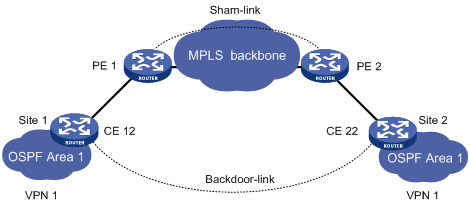
A sham link is considered a virtual point-to-point link within a VPN and is advertised in a Type 1 LSA. It is identified by the source IP address and destination IP address that are the local PE address and the remote PE address in the VPN address space. Typically, the source and destination addresses are loopback interface addresses with a 32-bit mask.
To add a route to the destination IP address of a sham link to a VPN instance, the remote PE must advertise the source IP address of the sham link as a VPN-IPv4 address through MP-BGP. To avoid routing loops, a PE does not advertise the sham link's destination address.
BGP AS number substitution and SoO attribute
BGP detects routing loops by examining AS numbers. If EBGP runs between PE and CE, you must assign different AS numbers to geographically different sites or configure the BGP AS number substitution feature to ensure correct transmission of routing information.
The BGP AS number substitution feature allows geographically different CEs to use the same AS number. If the AS_PATH of a route contains the AS number of a CE, the PE replaces the AS number with its own AS number before advertising the route to that CE.
After you enable the BGP AS number substitution feature, the PE performs BGP AS number substitution for all routes and re-advertises them to connected CEs in the peer group.
Figure 14 Application of BGP AS number substitution and SoO attribute
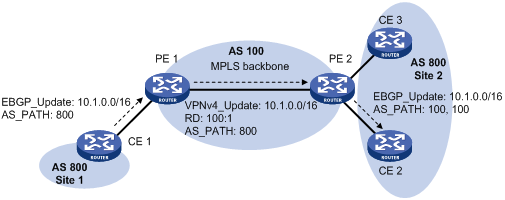
As shown in Figure 14, both Site 1 and Site 2 use the AS number 800. AS number substitution is enabled on PE 2 for CE 2. Before advertising updates received from CE 1 to CE 2, PE 2 substitutes its own AS number 100 for the AS number 800. In this way, CE 2 can correctly receive the routing information from CE 1.
However, the AS number substitution feature also introduces a routing loop in Site 2 because route updates originated from CE 3 can be advertised back to Site 2 through PE 2 and CE 2. To remove the routing loop, you can configure the same SoO attribute on PE 2 for CE 2 and CE 3. PE 2 adds the SoO attribute to route updates received from CE 2 or CE 3, and checks the SoO attribute of route updates to be advertised to CE 2 or CE 3. The SoO attribute of the route updates from CE 3 is the same as the SoO attribute for CE 2, and PE 2 does not advertise route updates to CE 2.
For more information about the SoO attribute, see Layer 3—IP Routing Configuration Guide.
MPLS L3VPN FRR
MPLS L3VPN Fast Reroute (FRR) is applicable to a dual-homed scenario, as shown in Figure 15. By using BFD to detect the primary link, FRR enables a PE to use the backup link when the primary link fails. The PE then selects a new optimal route, and uses the new optimal route to forward traffic.
MPLS L3VPN FRR supports the following types of backup:
· VPNv4 route backup for a VPNv4 route.
· VPNv4 route backup for an IPv4 route.
· IPv4 route backup for a VPNv4 route.
VPNv4 route backup for a VPNv4 route
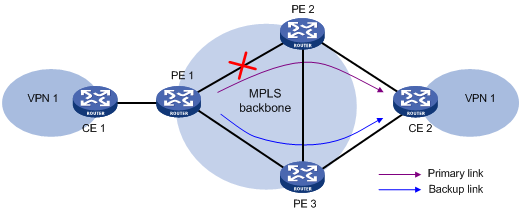
As shown in Figure 15, configure FRR on the ingress node PE 1, and specify the backup next hop for VPN 1 as PE 3. When PE 1 receives a VPNv4 route to CE 2 from both PE 2 and PE 3, it uses the route from PE 2 as the primary link, and the route from PE 3 as the backup link.
Configure BFD for LSPs or MPLS TE tunnels on PE 1 to detect the connectivity of the public tunnel from PE 1 to PE 2. When the tunnel PE 1—PE 2 operates correctly, traffic from CE 1 to CE 2 goes through the path CE 1—PE 1—PE 2—CE 2. When the tunnel fails, the traffic goes through the path CE 1—PE 1—PE 3—CE 2.
In this scenario, PE 1 is responsible for primary link detection and traffic switchover.
For more information about BFD for LSPs or MPLS TE tunnels, see "Configuring MPLS OAM."
VPNv4 route backup for an IPv4 route
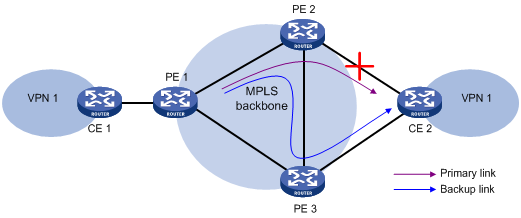
As shown in Figure 16, configure FRR on the egress node PE 2, and specify the backup next hop for VPN 1 as PE 3. When PE 2 receives an IPv4 route from CE 2 and a VPNv4 route from PE 3 (both routes are destined for VPN 1 connected to CE 2), PE 2 uses the IPv4 route as the primary link, and the VPNv4 route as the backup link.
PE 2 uses ARP or echo-mode BFD to detect the connectivity of the link from PE 2 to CE 2. When the link operates correctly, traffic from CE 1 to CE 2 goes through the path CE 1—PE 1—PE 2—CE 2. When the link fails, PE 2 switches traffic to the link PE 2—PE 3—CE 2, and traffic from CE 1 to CE 2 goes through the path CE 1—PE 1—PE 2—PE 3—CE 2. This avoids traffic interruption before route convergence completes (switching to the link CE 1—PE 1—PE 3—CE 2).
In this scenario, PE 2 is responsible for primary link detection and traffic switchover.
IPv4 route backup for a VPNv4 route
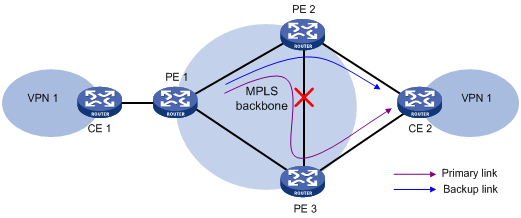
As shown in Figure 17, configure FRR on the egress node PE 2, and specify the backup next hop for VPN 1 as CE 2. When PE 2 receives an IPv4 route from CE 2 and a VPNv4 route from PE 3 (both routes are destined for VPN 1 connected to CE 2), PE 2 uses the VPNv4 route as the primary link, and the IPv4 route as the backup link.
Configure BFD for LSPs or MPLS TE tunnels on PE 2 to detect the connectivity of the public tunnel from PE 2 to PE 3. When the tunnel operates correctly, traffic from CE 1 to CE 2 goes through the path CE 1—PE 1—PE 2—PE 3—CE 2. When the tunnel fails, the traffic goes through the path CE 1—PE 1—PE 2—CE 2.
In this scenario, PE 2 is responsible for primary link detection and traffic switchover.
ECMP VPN route redistribution
This feature enables a VPN instance to redistribute all routes that have the same prefix and RD into its routing table. Based on the ECMP routes, the device can perform load sharing (as configured by the balance command) or MPLS L3VPN FRR. For more information about the balance command, see BGP in Layer 3—IP Routing Command Reference.
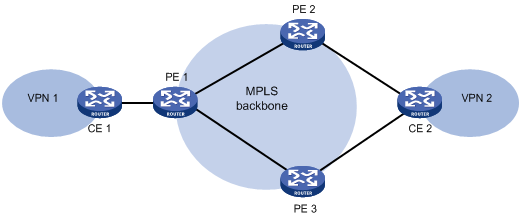
As shown in Figure 18, CE 1 accesses the backbone network through VPN instance VPN1 created on PE 1. The RD of VPN instance VPN1 is 1:1. CE 2 accesses the backbone network through VPN instances created on PE 2 and PE 3. The VPN instances created on PE 2 and PE 3 have the same name VPN2 and the same RD 1:2. VPN instances VPN1 and VPN2 can communicate with each other.
Both PE 2 and PE 3 can advertise routes from CE 2 to PE 1, and the advertised routes have the same RD 1:2. By default, BGP redistributes only the optimal route into the routing table of VPN instance VPN1. After you enable this feature on VPN instance VPN1, BGP redistributes routes from both PE 2 and PE 3 to the routing table of VPN instance VPN1.
Protocols and standards
· RFC 3107, Carrying Label Information in BGP-4
· RFC 4360, BGP Extended Communities Attribute
· RFC 4364, BGP/MPLS IP Virtual Private Networks (VPNs)
· RFC 4577, OSPF as the Provider/Customer Edge Protocol for BGP/MPLS IP Virtual Private Networks (VPNs)
Restrictions and guidelines for MPLS L3VPN
MPLS L3VPN is mutually exclusive with EVI and VXLAN. For more information about EVI and VXLAN, see EVI Configuration Guide and VXLAN Configuration Guide.
A VPN instance cannot be used if the system reports insufficient VPN resources for creating the VPN instance. Delete the VPN instance, and then create the VPN instance when the VPN resources are sufficient.
A PE cannot connect to a P device through a Layer 3 Ethernet subinterface or Layer 3 aggregate subinterface.
MPLS L3VPN configuration task list
|
Tasks at a glance |
|
(Required.) Configuring basic MPLS L3VPN |
|
(Optional.) Configuring inter-AS VPN |
|
(Optional.) Configuring an OSPF sham link |
|
(Optional.) Specifying the VPN label processing mode on the egress PE |
|
(Optional.) Configuring BGP AS number substitution and SoO attribute |
|
(Optional.) Configuring MPLS L3VPN FRR |
|
(Optional.) Configuring BGP RT filtering |
|
(Optional.) Configuring the BGP additional path feature |
|
(Optional.) Configuring route replication |
|
(Optional.) Enabling ECMP VPN route redistribution |
|
(Optional.) Enabling SNMP notifications for MPLS L3VPN |
|
(Optional.) Enabling prioritized withdrawal of specific routes |
|
(Optional.) Enabling logging for BGP route flapping |
Configuring basic MPLS L3VPN
|
Tasks at a glance |
|
|
(Required.) Creating a VPN instance (Required.) Associating a VPN instance with a Layer 3 interface (Optional.) Configuring route related attributes for a VPN instance |
|
|
(Required.) Configuring routing between a PE and a CE |
|
|
(Required.) Configuring routing between PEs |
|
|
(Optional.) Configuring BGP VPNv4 route control |
Configuration prerequisites
Before you configure basic MPLS L3VPN, perform the following tasks:
1. Configure an IGP on the PEs and P devices to ensure IP connectivity within the MPLS backbone.
2. Configure basic MPLS for the MPLS backbone.
3. Configure MPLS LDP on the PEs and P devices to establish LDP LSPs.
Configuring VPN instances
VPN instances isolate VPN routes from public network routes and routes among VPNs. This feature allows VPN instances to be used in network scenarios in addition to MPLS L3VPNs.
All VPN instance configurations are performed on PEs or MCEs.
Creating a VPN instance
A VPN instance is a collection of the VPN membership and routing rules of its associated site. A VPN instance might correspond to more than one VPN.
To create and configure a VPN instance:
|
Step |
Command |
Remarks |
|
1. Enter system view. |
system-view |
N/A |
|
2. Create a VPN instance and enter VPN instance view. |
ip vpn-instance vpn-instance-name |
By default, no VPN instances exist. |
|
3. Configure an RD for the VPN instance. |
route-distinguisher route-distinguisher |
By default, no RD is configured for a VPN instance. |
|
4. (Optional.) Configure a description for the VPN instance. |
description text |
By default, no description is configured for a VPN instance. |
|
5. (Optional.) Configure a VPN ID for the VPN instance. |
vpn-id vpn-id |
By default, no VPN ID is configured for a VPN instance. |
|
6. (Optional.) Configure an SNMP context for the VPN instance. |
snmp context-name context-name |
By default, no SNMP context is configured. |
Associating a VPN instance with a Layer 3 interface
After creating and configuring a VPN instance, associate the VPN instance with the interface connected to the CE.
To associate a VPN instance with an interface:
|
Step |
Command |
Remarks |
|
1. Enter system view. |
system-view |
N/A |
|
2. Enter interface view. |
interface interface-type interface-number |
N/A |
|
3. Associate a VPN instance with the interface. |
ip binding vpn-instance vpn-instance-name |
By default, an interface is not associated with a VPN instance and belongs to the public network. The ip binding vpn-instance command deletes the IP address of the current interface. You must reconfigure an IP address for the interface after configuring the command. |
Configuring route related attributes for a VPN instance
|
Step |
Command |
Remarks |
|
1. Enter system view. |
system-view |
N/A |
|
2. Enter VPN instance view or VPN instance IPv4 VPN view |
· Enter VPN instance view: · Enter VPN instance IPv4 VPN view: a. ip vpn-instance vpn-instance-name b. address-family ipv4 |
IPv4 VPN prefers the configurations in VPN instance IPv4 VPN view over the configurations in VPN instance view. |
|
3. Configure route targets. |
vpn-target vpn-target&<1-8> [ both | export-extcommunity | import-extcommunity ] |
By default, no route targets are configured. |
|
4. Set the maximum number of active routes. |
routing-table limit number { warn-threshold | simply-alert } |
By default, the number of active routes is not limited. Setting the maximum number of active routes for a VPN instance can prevent the PE from learning too many routes. |
|
5. Apply an import routing policy. |
import route-policy route-policy |
By default, all routes matching the import target attribute are accepted. The specified routing policy must have been created. For information about routing policies, see Layer 3—IP Routing Configuration Guide. |
|
6. Apply an export routing policy. |
export route-policy route-policy |
By default, routes to be advertised are not filtered. The specified routing policy must have been created. For information about routing policies, see Layer 3—IP Routing Configuration Guide. |
|
7. Apply a tunnel policy to the VPN instance. |
tnl-policy tunnel-policy-name |
By default, only one tunnel is selected (no load balancing). The LSP tunnel takes precedence over the CR-LSP tunnel. The specified tunnel policy must have been created. For information about tunnel policies, see "Configuring tunnel policies." |
Configuring routing between a PE and a CE
You can configure static routing, RIP, OSPF, IS-IS, EBGP, or IBGP between a PE and a CE.
Configuring static routing between a PE and a CE
|
Step |
Command |
Remarks |
|
1. Enter system view. |
system-view |
N/A |
|
2. Configure a static route for a VPN instance. |
ip route-static vpn-instance s-vpn-instance-name dest-address { mask-length | mask } { interface-type interface-number [ next-hop-address ] |next-hop-address [ public ] | vpn-instance d-vpn-instance-name next-hop-address } |
By default, no static route is configured for a VPN instance. Perform this configuration on the PE. On the CE, configure a common static route. For more information about static routing, see Layer 3—IP Routing Configuration Guide. |
Configuring RIP between a PE and a CE
A RIP process belongs to the public network or a single VPN instance. If you create a RIP process without binding it to a VPN instance, the process belongs to the public network.
To configure RIP between a PE and a CE:
|
Step |
Command |
Remarks |
|
1. Enter system view. |
system-view |
N/A |
|
2. Create a RIP process for a VPN instance and enter RIP view. |
rip [ process-id ] vpn-instance vpn-instance-name |
Perform this configuration on the PE. On the CE, create a common RIP process. |
|
3. Enable RIP on the interface attached to the specified network. |
network network-address [ wildcard-mask ] |
By default, RIP is disabled on an interface. |
Configuring OSPF between a PE and a CE
An OSPF process that is bound to a VPN instance does not use the public network router ID configured in system view. Therefore, you must specify a router ID when creating a process or configure an IP address for a minimum of one interface in the VPN instance.
An OSPF process belongs to the public network or a single VPN instance. If you create an OSPF process without binding it to a VPN instance, the process belongs to the public network.
To configure OSPF between a PE and a CE:
|
Step |
Command |
Remarks |
|
1. Enter system view. |
system-view |
N/A |
|
2. Create an OSPF process for a VPN instance and enter the OSPF view. |
ospf [ process-id | router-id router-id | vpn-instance vpn-instance-name ] * |
Perform this configuration on the PE. On the CE, create a common OSPF process. Deleting a VPN instance also deletes all related OSPF processes. |
|
3. Redistribute BGP routes. |
import-route bgp [ as-number ] [ allow-ibgp ] [ cost cost-value | nssa-only | route-policy route-policy-name | tag tag | type type ] * |
By default, OSPF does not redistribute routes from other routing protocols. If the vpn-instance-capability simple command is not configured for the OSPF process, the allow-ibgp keyword is optional to redistribute VPNv4 routes learned from MP-IBGP peers. In any other cases, if you do not specify the allow-ibgp keyword, the OSPF process does not redistribute VPNv4 routes learned from MP-IBGP peers. |
|
4. (Optional.) Set an OSPF domain ID. |
domain-id domain-id [ secondary ] |
The default domain ID is 0. Perform this configuration on the PE. The domain ID is carried in the routes of the OSPF process. When redistributing routes from the OSPF process, BGP adds the domain ID as an extended community attribute into BGP routes. An OSPF process can be configured with only one primary domain ID. Domain IDs of different OSPF processes can be the same. All OSPF processes of a VPN must be configured with the same domain ID. |
|
5. Configure the type codes of OSPF extended community attributes. |
ext-community-type { domain-id type-code1 | router-id type-code2 | route-type type-code3 } |
The defaults are as follows: · 0x0005 for Domain ID. · 0x0107 for Router ID. · 0x0306 for Route Type. Perform this configuration on the PE. |
|
6. Create an OSPF area and enter area view. |
area area-id |
By default, no OSPF areas exist. |
|
7. Enable OSPF on the interface attached to the specified network in the area. |
network ip-address wildcard-mask |
By default, an interface neither belongs to any area nor runs OSPF. |
Configuring IS-IS between a PE and a CE
An IS-IS process belongs to the public network or a single VPN instance. If you create an IS-IS process without binding it to a VPN instance, the process belongs to the public network.
To configure IS-IS between a PE and a CE:
|
Step |
Command |
Remarks |
|
1. Enter system view. |
system-view |
N/A |
|
2. Create an IS-IS process for a VPN instance and enter IS-IS view. |
isis [ process-id ] vpn-instance vpn-instance-name |
Perform this configuration on the PE. On the CE, configure common IS-IS. |
|
3. Configure a network entity title for the IS-IS process. |
network-entity net |
By default, no NET is configured. |
|
4. Return to system view. |
quit |
N/A |
|
5. Enter interface view. |
interface interface-type interface-number |
N/A |
|
6. Enable the IS-IS process on the interface. |
isis enable [ process-id ] |
By default, no IS-IS process is enabled on the interface. |
Configuring EBGP between a PE and a CE
1. Configure the PE:
|
Step |
Command |
Remarks |
|
1. Enter system view. |
system-view |
N/A |
|
2. Enter BGP instance view. |
bgp as-number [ instance instance-name ] |
N/A |
|
3. Enter BGP-VPN instance view. |
ip vpn-instance vpn-instance-name |
Configuration commands in BGP-VPN instance view are the same as those in BGP instance view. For more information, see Layer 3—IP Routing Configuration Guide. |
|
4. Configure the CE as the VPN EBGP peer. |
peer { group-name | ip-address [ mask-length ] } as-number as-number |
By default, no BGP peers exist. For more information about BGP peers and peer groups, see Layer 3—IP Routing Configuration Guide. |
|
5. Create the BGP-VPN IPv4 unicast family and enter its view. |
address-family ipv4 [ unicast ] |
By default, the BGP-VPN IPv4 unicast family is not created. |
|
6. Enable IPv4 unicast route exchange with the specified peer or peer group. |
peer { group-name | ip-address [ mask-length ] } enable |
By default, BGP does not exchange IPv4 unicast routes with any peer. |
|
7. Redistribute the routes of the local CE. |
import-route protocol [ { process-id | all-processes } [ allow-direct | med med-value | route-policy route-policy-name ] * ] |
A PE must redistribute the routes of the local CE into its VPN routing table so it can advertise them to the peer PE. |
|
8. (Optional.) Allow the local AS number to appear in the AS_PATH attribute of a received route, and set the maximum number of repetitions. |
peer { group-name | ip-address [ mask-length ] } allow-as-loop [ number ] |
By default, BGP discards incoming route updates that contain the local AS number. BGP detects routing loops by examining AS numbers. In a hub-spoke network where EBGP is running between a PE and a CE, the routing information the PE advertises to a CE carries the AS number of the PE. Therefore, the route updates that the PE receives from the CE also include the AS number of the PE. This causes the PE to be unable to receive the route updates. In this case, you must configure this command to allow routing loops. |
2. Configure the CE:
|
Step |
Command |
Remarks |
|
1. Enter system view. |
system-view |
N/A |
|
2. Enter BGP instance view. |
bgp as-number [ instance instance-name ] |
N/A |
|
3. Configure the PE as a BGP peer. |
peer { group-name | ip-address [ mask-length ] } as-number as-number |
By default, no BGP peers exist. |
|
4. Create the BGP IPv4 unicast family and enter its view. |
address-family ipv4 [ unicast ] |
By default, the BGP IPv4 unicast family is not created. |
|
5. Enable IPv4 unicast route exchange with the specified peer or peer group. |
peer { group-name | ip-address [ mask-length ] } enable |
By default, BGP does not exchange IPv4 unicast routes with any peer. |
|
6. (Optional.) Configure route redistribution. |
import-route protocol [ { process-id | all-processes } [ allow-direct | med med-value | route-policy route-policy-name ] * ] |
A CE must redistribute its routes to the PE so the PE can advertise them to the peer CE. |
Configuring IBGP between a PE and a CE
Use IBGP between PE and CE only in a basic MPLS L3VPN network. In networks such as Hub&Spoke, Extranet, and inter-AS VPN, you cannot use IBGP between PE and CE.
1. Configure the PE:
|
Step |
Command |
Remarks |
|
1. Enter system view. |
system-view |
N/A |
|
2. Enter BGP instance view. |
bgp as-number [ instance instance-name ] |
N/A |
|
3. Enter BGP-VPN instance view. |
ip vpn-instance vpn-instance-name |
Configuration commands in BGP-VPN instance view are the same as those in BGP instance view. For more information, see Layer 3—IP Routing Configuration Guide. |
|
4. Configure the CE as the VPN IBGP peer. |
peer { group-name | ip-address [ mask-length ] } as-number as-number |
By default, no BGP peers exist. |
|
5. Create the BGP-VPN IPv4 unicast family and enter its view. |
address-family ipv4 [ unicast ] |
By default, the BGP-VPN IPv4 unicast family is not created. |
|
6. Enable IPv4 unicast route exchange with the specified peer. |
peer { group-name | ip-address [ mask-length ] } enable |
By default, BGP does not exchange IPv4 unicast routes with any peer. |
|
7. Configure the CE as a client of the RR. |
peer { group-name | ip-address [ mask-length ] } reflect-client |
By default, no RR or RR client is configured, and the PE does not advertise routes learned from the IBGP peer CE to other IBGP peers, including VPNv4 IBGP peers. The PE advertises routes learned from the CE to other IBGP peers only when you configure the IBGP peer CE as a client of the RR. Configuring an RR does not change the next hop of a route. To change the next hop of a route, configure an inbound policy on the receiving side. |
|
8. (Optional.) Enable route reflection between clients. |
reflect between-clients |
Route reflection between clients is enabled by default. |
|
9. (Optional.) Configure the cluster ID for the RR. |
reflector cluster-id { cluster-id | ip-address } |
By default, the RR uses its own router ID as the cluster ID. If multiple RRs exist in a cluster, use this command to configure the same cluster ID for all RRs in the cluster to avoid routing loops. |
2. Configure the CE:
|
Step |
Command |
Remarks |
|
1. Enter system view. |
system-view |
N/A |
|
2. Enter BGP instance view. |
bgp as-number [ instance instance-name ] |
N/A |
|
3. Configure the PE as an IBGP peer. |
peer { group-name | ip-address [ mask-length ] } as-number as-number |
By default, no BGP peers exist. |
|
4. Create the BGP IPv4 unicast family and enter its view. |
address-family ipv4 [ unicast ] |
By default, the BGP IPv4 unicast family is not created. |
|
5. Enable IPv4 unicast route exchange with the specified peer or peer group. |
peer { group-name | ip-address [ mask-length ] } enable |
By default, BGP does not exchange IPv4 unicast routes with any peer. |
|
6. (Optional.) Configure route redistribution. |
import-route protocol [ { process-id | all-processes } [ allow-direct | med med-value | route-policy route-policy-name ] * ] |
A CE must redistribute its routes to the PE so the PE can advertise them to the peer CE. |
Configuring routing between PEs
|
Step |
Command |
Remarks |
|
1. Enter system view. |
system-view |
N/A |
|
2. Enter BGP instance view. |
bgp as-number [ instance instance-name ] |
N/A |
|
3. Configure the remote PE as a BGP peer. |
peer { group-name | ip-address [ mask-length ] } as-number as-number |
By default, no BGP peers exist. |
|
4. Specify the source interface for route updates. |
peer { group-name | ip-address [ mask-length ] } connect-interface interface-type interface-number |
By default, BGP uses the output interface of the optimal route destined for the peer as the source interface. |
|
5. Create the BGP VPNv4 address family and enter its view. |
address-family vpnv4 |
By default, the BGP VPNv4 address family is not created. |
|
6. Enable BGP VPNv4 route exchange with the specified peer. |
peer { group-name | ip-address [ mask-length ] } enable |
By default, BGP does not exchange BGP VPNv4 routes with any peer. |
Configuring BGP VPNv4 route control
BGP VPNv4 route control is configured similarly with BGP route control, except that it is configured in BGP VPNv4 address family view. For more information about BGP route control, see Layer 3—IP Routing Configuration Guide.
To configure BGP VPNv4 route control:
|
Step |
Command |
Remarks |
|
1. Enter system view. |
system-view |
N/A |
|
2. Enter BGP instance view. |
bgp as-number [ instance instance-name ] |
N/A |
|
3. Enter BGP VPNv4 address family view. |
address-family vpnv4 |
N/A |
|
4. Configure filtering of advertised routes. |
filter-policy { ipv4-acl-number | name ipv4-acl-name | prefix-list prefix-list-name } export [ direct | { isis | ospf | rip } process-id | static ] |
By default, BGP does not filter advertised routes. |
|
5. Configure filtering of received routes. |
filter-policy { ipv4-acl-number | name ipv4-acl-name | prefix-list prefix-list-name } import |
By default, BGP does not filter received routes. |
|
6. Advertise the COMMUNITY attribute to a peer or peer group. |
peer { group-name | ipv4-address [ mask-length ] } advertise-community |
By default, BGP does not advertise the COMMUNITY attribute to any peers or peer groups. |
|
7. Allow the local AS number to appear in the AS_PATH attribute of routes received from the peer, and set the maximum number of repetitions. |
peer { group-name | ipv4-address [ mask-length ] } allow-as-loop [ number ] |
By default, BGP discards route updates that contain the local AS number. |
|
8. Filter routes received from or advertised to a peer or peer group based on an AS_PATH list. |
peer { group-name | ipv4-address [ mask-length ] } as-path-acl as-path-acl-number { export | import } |
By default, no AS filtering list is applied to a peer or peer group. |
|
9. Advertise a default VPN route to a peer or peer group. |
peer { group-name | ipv4-address [ mask-length ] } default-route-advertise vpn-instance vpn-instance-name |
By default, no default VPN route is advertised to a peer or peer group. |
|
10. Apply an ACL to filter routes received from or advertised to a peer or peer group. |
peer { group-name | ipv4-address [ mask-length ] } filter-policy { ipv4-acl-number | name ipv4-acl-name } { export | import } |
By default, no ACL-based filtering is configured. |
|
11. Save all route updates from a peer or peer group. |
peer { group-name | ip-address [ mask-length ] } keep-all-routes |
By default, BGP does not save route updates from any peer. |
|
12. Specify the device as the next hop of routes sent to a peer or peer group. |
peer { group-name | ipv4-address [ mask-length ] } next-hop-local |
By default, the device sets itself as the next hop for routes sent to a peer or peer group. |
|
13. Configure BGP to not change the next hop of routes sent to a peer or peer group. |
peer { group-name | ipv4-address [ mask-length ] } next-hop-invariable |
By default, the device sets itself as the next hop for routes sent to a peer or peer group. In an inter-AS option C network where an RR is used to advertise VPNv4 routes, configure this command on the RR so the RR does not change the next hop of routes sent to BGP peers and clients. |
|
14. Set a preferred value for routes received from a peer or peer group. |
peer { group-name | ipv4-address [ mask-length ] } preferred-value value |
By default, the preferred value is 0. |
|
15. Apply a prefix list to filter routes received from or advertised to a peer or peer group. |
peer { group-name | ipv4-address [ mask-length ] } prefix-list prefix-list-name { export | import } |
By default, no prefix list based filtering is configured. |
|
16. Configure BGP updates advertised to an EBGP peer or peer group to carry only public AS numbers. |
peer { group-name | ipv4-address [ mask-length ] } public-as-only |
By default, BGP route updates advertised to an EBGP peer or peer group can carry both public and private AS numbers. |
|
17. Configure the device as an RR and specify a peer or peer group as its client. |
peer { group-name | ipv4-address [ mask-length ] } reflect-client |
By default, no RR is configured. |
|
18. Set the maximum number of routes BGP can receive from a peer or peer group. |
peer { group-name | ipv4-address [ mask-length ] } route-limit prefix-number [ { alert-only | discard | reconnect reconnect-time } | percentage-value ] * |
By default, the number of routes that BGP can receive from a peer or peer group is not limited. |
|
19. Apply a routing policy to a peer or peer group. |
peer { group-name | ipv4-address [ mask-length ] } route-policy route-policy-name { export | import } |
By default, no routing policy is applied to a peer or peer group. |
|
20. Enable route target filtering of received VPNv4 routes. |
policy vpn-target |
By default, route target filtering is enabled for received VPNv4 routes. Only VPNv4 routes whose export route target attribute matches local import route target attribute are added to the routing table. |
|
21. Enable route reflection between clients. |
reflect between-clients |
By default, route reflection between clients is enabled on the RR. |
|
22. Configure a cluster ID for the RR. |
reflector cluster-id { cluster-id | ip-address } |
By default, the RR uses its own router ID as the cluster ID. |
|
23. Configure filtering of reflected routes. |
rr-filter ext-comm-list-number |
By default, the RR does not filter reflected routes. |
|
24. Configure the SoO attribute for a BGP peer or peer group. |
peer { group-name | ipv4-address [ mask-length ] } soo site-of-origin |
By default, the SoO attribute is not configured. |
Configuring inter-AS VPN
If the MPLS backbone spans multiple ASs, you must configure inter-AS VPN.
Configuring inter-AS option A
Inter-AS option A applies to scenarios with a few VPNs.
To configure inter-AS option A, create VPN instances on PEs and ASBRs. The VPN instances on PEs are used to allow CEs to access the network, The VPN instances on ASBRs are used to access the peer ASBRs. An ASBR considers the peer ASBR as a CE.
The route targets configured on the PEs must match those configured on the ASBRs in the same AS to make sure VPN routes sent by the PEs (or ASBRs) can be received by the ASBRs (or PEs). Route targets configured on the PEs in different ASs do not have such requirements.
For more information, see "Configuring basic MPLS L3VPN."
Configuring inter-AS option B
To configure inter-AS option B, perform configurations on PEs and ASBRs.
· PE configuration:
Configure basic MPLS L3VPN, and specify the ASBR in the same AS as an MP-IBGP peer. The route targets for the VPN instances on the PEs in different ASs must match for the same VPN. For information about PE configuration, see "Configuring basic MPLS L3VPN."
· ASBR configuration:
¡ Configure a routing protocol, and enable MPLS and LDP on the interface connected to an internal router of the AS.
¡ Specify the PE in the same AS as an MP-IBGP peer, and the ASBR in a different AS as an MP-EBGP peer.
¡ Disable VPN target filtering for VPNv4 routes so the ASBR can maintain all VPNv4 routes and advertise the routes to the peer ASBR.
¡ Enable MPLS capability on the interface connected to the ASBR in another AS. There is no need to configure a label distribution protocol, for example, LDP.
An ASBR always sets itself as the next hop of VPNv4 routes advertised to an MP-IBGP peer regardless of the peer next-hop-local command.
To configure inter-AS option B on an ASBR:
|
Step |
Command |
Remarks |
|
1. Enter system view. |
system-view |
N/A |
|
2. Enter interface view of the interface connected to an internal router of the AS. |
interface interface-type interface-number |
N/A |
|
3. Enable MPLS on the interface. |
mpls enable |
By default, MPLS is disabled on the interface. |
|
4. Enable MPLS LDP on the interface. |
mpls ldp enable |
By default, MPLS LDP is disabled on the interface. |
|
5. Return to system view. |
quit |
N/A |
|
6. Enter interface view of the interface connected to the remote ASBR. |
interface interface-type interface-number |
N/A |
|
7. Enable MPLS on the interface. |
mpls enable |
By default, MPLS is disabled on the interface. |
|
8. Return to system view. |
quit |
N/A |
|
9. Enter BGP instance view. |
bgp as-number [ instance instance-name ] |
N/A |
|
10. Create a BGP peer. |
peer { group-name | ipv4-address [ mask-length ] } as-number as-number |
By default, no BGP peers exist. Configure PEs in the same AS as IBGP peers, and ASBRs in different ASs as EBGP peers. |
|
11. Enter BGP VPNv4 address family view. |
address-family vpnv4 |
N/A |
|
12. Enable BGP to exchange VPNv4 routes with the PE in the same AS and the ASBR in different ASs. |
peer { group-name | ipv4-address [ mask-length ] } enable |
By default, BGP cannot exchange VPNv4 routing information with a peer. |
|
13. Disable route target filtering of VPNv4 routes. |
undo policy vpn-target |
By default, route target filtering is enabled for received VPNv4 routes. Only VPNv4 routes whose export route target attribute matches local import route target attribute are added to the routing table. |
Configuring inter-AS option C
To configure inter-AS option C, perform configurations on PEs and ASBRs.
· PE configuration:
¡ Configure basic MPLS L3VPN, and specify the PE in another AS as an MP-EBGP peer. The route targets for the VPN instances on the PEs in different ASs must match for the same VPN. For information about PE configuration, see "Configuring basic MPLS L3VPN."
¡ Execute the peer ebgp-max-hop command to enable the local router to establish an EBGP session to an indirectly-connected peer, because the PEs are not directly connected.
¡ Specify the ASBR in the same AS as an IBGP peer, and enable BGP to exchange labeled IPv4 unicast routes with the ASBR.
· ASBR configuration:
¡ Configure a routing protocol, and enable MPLS and LDP on the interface connected to an internal router of the AS.
¡ Specify the PE in the same AS as an IBGP peer, and the ASBR in a different AS as an EBGP peer.
¡ Enable BGP to exchange labeled IPv4 unicast routes with the PE in the same AS and the ASBR in different AS.
¡ Enable MPLS capability on the interface connected to the ASBR in another AS. There is no need to configure a label distribution protocol, for example, LDP.
¡ (Optional.) Configure a routing policy to determine which IPv4 unicast routes are advertised to the IBGP or EBGP peer with MPLS labels.
In addition, configure BGP to advertise routes destined for a PE on PEs or ASBRs. For more information, see Layer 3—IP Routing Configuration Guide.
Configuring a PE
To configure a PE for inter-AS option C:
|
Step |
Command |
Remarks |
|
1. Enter system view. |
system-view |
N/A |
|
2. Enter BGP instance view. |
bgp as-number [ instance instance-name ] |
N/A |
|
3. Configure the ASBR in the same AS as an IBGP peer. |
peer { group-name | ipv4-address [ mask-length ] } as-number as-number |
By default, no BGP peers exist. |
|
4. Configure the PE of another AS as an EBGP peer. |
peer { group-name | ipv4-address [ mask-length ] } as-number as-number |
By default, no BGP peers exist. |
|
5. Create the BGP IPv4 unicast address family and enter its view. |
address-family ipv4 [ unicast ] |
By default, the BGP IPv4 unicast address family is not created. |
|
6. Enable BGP to exchange IPv4 unicast routes with the ASBR in the same AS. |
peer { group-name | ipv4-address [ mask-length ] } enable |
By default, BGP does not exchange IPv4 unicast routes with any peer. |
|
7. Enable BGP to exchange labeled IPv4 routes with the ASBR in the same AS. |
peer { group-name | ipv4-address [ mask-length ] } label-route-capability |
By default, BGP cannot exchange labeled routes with any IPv4 peer or peer group. |
|
8. Return to BGP instance view. |
quit |
N/A |
|
9. Enter BGP VPNv4 address family view. |
address-family vpnv4 |
N/A |
|
10. Enable BGP to exchange VPNv4 routes with the PE in different ASs. |
peer { group-name | ipv4-address [ mask-length ] } enable |
By default, BGP cannot exchange VPNv4 routes with any peer. |
|
11. (Optional.) Configure the PE to not change the next hop of routes advertised to the peer. |
peer { group-name | ipv4-address [ mask-length ] } next-hop-invariable |
Configure this command on the RR so the RR does not change the next hop of advertised VPNv4 routes. |
Configuring an ASBR
To set up an inter-AS public tunnel for the inter-AS option C solution, an ASBR must assign an MPLS label to the route destined for a PE, and advertise the label along with the route. Typically, the routes advertised by an ASBR through BGP include the PE address as well as other routes. You can configure a routing policy to filter routes. Routes surviving the filtering are assigned labels, and all others are advertised as common IPv4 routes.
To configure a routing policy, use the following commands:
· if-match mpls-label—Matches routes carrying MPLS labels.
· apply mpls-label—Sets MPLS labels for IPv4 routes advertised to a peer. You can use this command together with if-match clauses. For example, the apply mpls-label command works together with the if-match mpls-label command to set new MPLS labels for routes with MPLS labels. The newly assigned labels are advertised along with the routes.
For more information about routing policy configuration, see Layer 3—IP Routing Configuration Guide.
To configure an ASBR for inter-AS option C:
|
Step |
Command |
Remarks |
|
1. Enter system view. |
system-view |
N/A |
|
2. (Optional.) Create a routing policy, and enter routing policy view. |
route-policy route-policy-name { deny | permit } node node-number |
By default, no routing policies exist. |
|
3. (Optional.) Match IPv4 routes carrying labels. |
if-match mpls-label |
By default, no MPLS label match criterion is configured. |
|
4. (Optional.) Set labels for IPv4 routes. |
apply mpls-label |
By default, no MPLS label is set for IPv4 routes. |
|
5. Return to system view. |
quit |
N/A |
|
6. Enter interface view of the interface connected to an internal router of the AS. |
interface interface-type interface-number |
N/A |
|
7. Enable MPLS on the interface. |
mpls enable |
By default, MPLS is disabled on the interface. |
|
8. Enable MPLS LDP on the interface. |
mpls ldp enable |
By default, MPLS LDP is disabled on the interface. |
|
9. Return to system view. |
quit |
N/A |
|
10. Enter interface view of the interface connected to the remote ASBR. |
interface interface-type interface-number |
N/A |
|
11. Enable MPLS on the interface. |
mpls enable |
By default, MPLS is disabled on the interface. |
|
12. Return to system view. |
quit |
N/A |
|
13. Enter BGP instance view. |
bgp as-number [ instance instance-name ] |
N/A |
|
14. Configure the PE in the same AS as an IBGP peer. |
peer { group-name | ipv4-address [ mask-length ] } as-number as-number |
By default, no BGP peers exist. |
|
15. Configure the ASBR in another AS as an EBGP peer. |
peer { group-name | ipv4-address [ mask-length ] } as-number as-number |
By default, no BGP peers exist. |
|
16. Create the BGP IPv4 unicast address family and enter its view. |
address-family ipv4 [ unicast ] |
By default, the BGP IPv4 unicast address family is not created. |
|
17. Enable exchange of IPv4 unicast routes with the PE in the same AS and the ASBR in another AS. |
peer { group-name | ipv4-address [ mask-length ] } enable |
By default, BGP does not exchange IPv4 unicast routes with any peer. |
|
18. Enable exchange of labeled IPv4 routes with the PE in the same AS and the ASBR in another AS. |
peer { group-name | ipv4-address [ mask-length ] } label-route-capability |
By default, BGP cannot advertise labeled routes to any IPv4 peer or peer group. |
|
19. Configure the ASBR to set itself as the next hop of routes advertised to the PE in the local AS. |
peer { group-name | ipv4-address [ mask-length ] } next-hop-local |
By default, BGP does not use its address as the next hop of routes advertised to an IBGP peer or peer group. |
|
20. (Optional.) Apply a routing policy to routes incoming from or outgoing to a peer or peer group. |
peer { group-name | ipv4-address [ mask-length ] } route-policy route-policy-name { export | import } |
By default, no routing policy is applied. |
Configuring an OSPF sham link
When a backdoor link exists between the two sites of a VPN, you can create a sham link between PEs to forward VPN traffic through the sham link on the backbone rather than the backdoor link. A sham link is considered an OSPF intra-area route.
The source and destination addresses of the sham link must be loopback interface addresses with 32-bit masks. The loopback interfaces must be bound to VPN instances, and their addresses are advertised through BGP.
Before you configure an OSPF sham link, perform the following tasks:
· Configure basic MPLS L3VPN (OSPF is used between PE and CE).
· Configure OSPF in the LAN where customer CEs reside.
Configuring a loopback interface
|
Step |
Command |
Remarks |
|
1. Enter system view. |
system-view |
N/A |
|
2. Create a loopback interface and enter loopback interface view. |
interface loopback interface-number |
By default, no loopback interfaces exist. |
|
3. Associate the loopback interface with a VPN instance. |
ip binding vpn-instance vpn-instance-name |
By default, the interface is associated with no VPN instance. |
|
4. Configure an IP address for the loopback interface. |
ip address ip-address { mask-length | mask } |
By default, no IP address is configured for the loopback interface. |
Redistributing the loopback interface address
|
Step |
Command |
Remarks |
|
1. Enter system view. |
system-view |
N/A |
|
2. Enter BGP instance view. |
bgp as-number [ instance instance-name ] |
N/A |
|
3. Enter BGP-VPN instance view. |
ip vpn-instance vpn-instance-name |
N/A |
|
4. Enter BGP-VPN IPv4 unicast address family view. |
address-family ipv4 [ unicast ] |
N/A |
|
5. Redistribute direct routes into BGP (including the loopback interface route). |
import-route direct |
By default, no direct routes are redistributed into BGP. |
Creating a sham link
|
Step |
Command |
Remarks |
|
1. Enter system view. |
system-view |
N/A |
|
2. Enter OSPF view. |
ospf [ process-id | router-id router-id | vpn-instance vpn-instance-name ] * |
As a best practice, specify a router ID. |
|
3. Set the external route tag for imported VPN routes. |
route-tag tag-value |
By default, if BGP runs within an MPLS backbone, and the BGP AS number is not greater than 65535, the first two octets of the external route tag are 0xD000 and the last two octets are the local BGP AS number. If the AS number is greater than 65535, the external route tag is 0. |
|
4. Enter OSPF area view. |
area area-id |
N/A |
|
5. Configure a sham link. |
sham-link source-ip-address destination-ip-address [ cost cost-value | dead dead-interval | hello hello-interval | { { hmac-md5 | md5 } key-id { cipher | plain } string | keychain keychain-name | simple { cipher | plain } string } | retransmit retrans-interval | trans-delay delay | ttl-security hops hop-count ] * |
By default, no sham links exist. |
Specifying the VPN label processing mode on the egress PE
An egress PE can process VPN labels in either POPGO or POP mode:
· POPGO forwarding—Pops the label and forwards the packet out of the output interface corresponding to the label.
· POP forwarding—Pops the label and forwards the packet through the FIB table.
The POPGO forwarding mode (vpn popgo) and per-VPN instance label allocation mode (label-allocation-mode per-vrf) are mutually exclusive. Do not configure both modes in a BGP instance. For more information about the label-allocation-mode command, see BGP commands in Layer 3—IP Routing Command Reference.
To specify the VPN label processing mode on an egress PE:
|
Step |
Command |
Remarks |
|
1. Enter system view. |
system-view |
N/A |
|
2. Enter BGP instance view. |
bgp as-number [ instance instance-name ] |
N/A |
|
3. Specify the VPN label processing mode as POPGO forwarding. |
vpn popgo |
The default is POP forwarding. |
Configuring BGP AS number substitution and SoO attribute
When CEs at different sites have the same AS number, configure the BGP AS number substitution feature to avoid route loss.
When a PE uses different interfaces to connect different CEs in a site, the BGP AS number substitution feature introduces a routing loop. To remove the routing loop, configure the SoO attribute on the PE.
For more information about the BGP AS number substitution feature and the SoO attribute, see "BGP AS number substitution and SoO attribute."
To configure BGP AS number substitution and SoO attribute:
|
Step |
Command |
Remarks |
|
1. Enter system view. |
system-view |
N/A |
|
2. Enter BGP instance view. |
bgp as-number [ instance instance-name ] |
N/A |
|
3. Enter BGP-VPN instance view. |
ip vpn-instance vpn-instance-name |
N/A |
|
4. Enable the BGP AS number substitution feature. |
peer { ipv4-address [ mask-length ] | group-name } substitute-as |
By default, BGP AS number substitution is disabled. |
|
5. Enter BGP-VPN IPv4 unicast address family view. |
address-family ipv4 [ unicast ] |
N/A |
|
6. (Optional.) Configure the SoO attribute for a BGP peer or peer group. |
peer { group-name | ipv4-address [ mask-length ] } soo site-of-origin |
By default, the SoO attribute is not configured. |
For more information about the commands in this section, see Layer 3—IP Routing Command Reference.
Configuring MPLS L3VPN FRR
You can use the following methods to configure MPLS L3VPN FRR:
· Method 1—Execute the pic command in BGP-VPN IPv4 unicast address family view. The device calculates a backup next hop for each BGP route in the VPN instance if there are two or more unequal-cost routes to reach the destination.
· Method 2—Execute the fast-reroute route-policy command in BGP-VPN IPv4 unicast address family view to use a routing policy. In the routing policy, specify a backup next hop by using the apply fast-reroute backup-nexthop command. The backup next hop calculated by the device must be the same as the specified backup next hop. Otherwise, the device does not generate a backup next hop for the primary route. You can also configure if-match clauses in the routing policy to identify the routes protected by FRR.
If both methods are configured, Method 2 takes precedence over Method 1.
To configure MPLS L3VPN FRR:
|
Step |
Command |
Remarks |
|
1. Enter system view. |
system-view |
N/A |
|
2. Configure the source IP address for BFD echo packets. |
bfd echo-source-ip ip-address |
The bfd echo-source-ip command is required when echo-mode BFD is used to detect primary route connectivity in VPNv4 route backup for an IPv4 route. For more information about this command, see High Availability Command Reference. |
|
3. Create a routing policy and enter routing policy view. |
route-policy route-policy-name permit node node-number |
By default, no routing policies exist. This step is required to enable MPLS L3VPN FRR in Method 2. For more information about this command, see Layer 3—IP Routing Command Reference. |
|
4. Set the backup next hop for FRR. |
apply fast-reroute backup-nexthop ip-address |
By default, no backup next hop address is set for FRR. This step is required to enable MPLS L3VPN FRR in Method 2. For more information about this command, see Layer 3—IP Routing Command Reference. |
|
5. Return to system view. |
quit |
N/A |
|
6. Enter BGP instance view. |
bgp as-number [ instance instance-name ] |
N/A |
|
7. (Optional.) Use echo-mode BFD to detect the connectivity to the next hop of the primary route. |
primary-path-detect bfd echo |
By default, ARP is used to detect the connectivity to the next hop. Use this command if necessary in VPNv4 route backup an IPv4 route. For more information about this command, see Layer 3—IP Routing Command Reference. |
|
8. Enter BGP-VPN instance view. |
ip vpn-instance vpn-instance-name |
N/A |
|
9. Enter BGP-VPN IPv4 unicast address family view. |
address-family ipv4 [ unicast ] |
N/A |
|
10. Enable MPLS L3VPN FRR. |
· (Method 1) Enable MPLS L3VPN FRR for the
address family: · (Method 2) Use a routing policy to
specify a backup next hop for the address family: |
By default, MPLS L3VPN FRR is disabled. Method 1 might result in routing loops. Use it with caution. By default, no routing policy is used. The apply fast-reroute backup-nexthop command can take effect in the routing policy that is being used. Other apply commands do not take effect. For more information about the command, see Layer 3—IP Routing Command Reference. |
Configuring BGP RT filtering
About BGP RT filtering
The BGP RT filtering feature reduces the number of routes advertised in an MPLS L3VPN.
After RT filtering is configured, a PE advertises its import target attribute to the peer PEs in the RT filter address family. The peer PEs use the received import target attribute to filter routes and advertise only the routes that match the attribute to the PE.
When a large number of IBGP peers exist, the BGP RT filtering and the route reflection features are used together as a best practice. Route reflection reduces the number of IBGP connections. BGP RT filtering reduces the number of routes advertised in the network.
Procedure
|
Step |
Command |
Remarks |
|
1. Enter system view. |
system-view |
N/A |
|
2. Enter BGP instance view. |
bgp as-number [ instance instance-name ] |
N/A |
|
3. Enter BGP IPv4 RT filter address family view. |
address-family ipv4 rtfilter |
N/A |
|
4. Enable the device to exchange routing information with a peer or peer group. |
peer { group-name | ipv4-address [ mask-length ] } enable |
By default, the device cannot exchange routing information with a peer or peer group. |
|
5. (Optional.) Advertise a default route to a peer or peer group. |
peer { group-name | ipv4-address [ mask-length ] } default-route-advertise [ route-policy route-policy-name ] |
By default, no default route is advertised. |
|
6. (Optional.) Set a preferred value for routes received from a peer or peer group. |
peer { group-name | ipv4-address [ mask-length ] } preferred-value value |
By default, the preferred value for routes received from a peer or peer group is 0. |
|
7. (Optional.) Configure the device as a route reflector and specify a peer or peer group as its client. |
peer { group-name | ipv4-address [ mask-length ] } reflect-client |
By default, no route reflector or client is configured. |
|
8. (Optional.) Enable route reflection between clients. |
reflect between-clients |
By default, route reflection between clients is enabled. |
|
9. (Optional.) Configure the cluster ID of the route reflector. |
reflector cluster-id { cluster-id | ipv4-address } |
By default, a route reflector uses its own router ID as the cluster ID. |
Configuring the BGP additional path feature
By default, BGP advertises only one optimal route. When the optimal route fails, traffic forwarding will be interrupted until route convergence completes.
The BGP additional path (Add-Path) feature enables BGP to advertise multiple routes with the same prefix and different next hops to a peer or peer group. When the optimal route fails, the suboptimal route becomes the optimal route, which shortens the traffic interruption time.
You can enable the BGP additional path sending, receiving, or both sending and receiving capabilities on a BGP peer. For two BGP peers to successfully negotiate the additional path capabilities, make sure one end has the sending capability and the other end has the receiving capability.
For more information about the BGP additional path configuration commands, see BGP commands in Layer 3—IP Routing Command Reference.
To configure the BGP additional path feature:
|
Step |
Command |
Remarks |
|
1. Enter system view. |
system-view |
N/A |
|
2. Enter BGP VPNv4 address family view or BGP-VPN VPNv4 address family view. |
· Enter BGP VPNv4 address family view: a. bgp as-number [ instance instance-name ] b. address-family ipv4 [ vpnv4 ] · Enter BGP-VPN VPNv4 address family view: a. bgp as-number [ instance instance-name ] b. ip vpn-instance vpn-instance-name c. address-family ipv4 [ vpnv4 ] |
N/A |
|
3. Configure the BGP additional path capabilities. |
peer { group-name | ipv4-address [ mask-length ] } additional-paths { receive | send } * |
By default, no BGP additional path capabilities are configured. |
|
4. Set the maximum number of Add-Path optimal routes that can be advertised to a peer or peer group. |
peer { group-name | ipv4-address [ mask-length ] } advertise additional-paths best number |
By default, a maximum of one Add-Path optimal route can be advertised to a peer or peer group. |
|
5. Set the maximum total number of Add-Path optimal routes that can be advertised to all peers. |
additional-paths select-best best-number |
By default, a maximum of one Add-Path optimal route can be advertised to all peers. This command is not supported in BGP-VPN VPNv4 address family view. |
Configuring route replication
About route replication
In a BGP/MPLS L3VPN network, only VPN instances that have matching route targets can communicate with each other. The route replication feature enables a VPN instance to communicate with the public network or other VPN instances by replicating routes from the public network or other VPN instances.
In an intelligent traffic control network, traffic of different tenants is assigned to different VPNs. To enable the tenants to communicate with the public network, configure this feature to replicate routes from the public network to the VPN instances.
Procedure
To configure route replication:
|
Step |
Command |
Remarks |
|
1. Enter system view. |
system-view |
N/A |
|
2. Enter VPN instance view. |
ip vpn-instance vpn-instance-name |
N/A |
|
3. Enter VPN instance IPv4 VPN view. |
address-family ipv4 |
N/A |
|
4. Replicate routes from the public network or other VPN instances. |
route-replicate from { public | vpn-instance vpn-instance-name } protocol bgp as-number [ route-policy route-policy-name ] route-replicate from { public | vpn-instance vpn-instance-name } protocol { direct | static | { isis | ospf | rip } process-id } [ advertise ] [ route-policy route-policy-name ] |
By default, a VPN instance cannot replicate routes from the public network or other VPN instances. |
Enabling ECMP VPN route redistribution
About ECMP VPN route redistribution
For multiple routes that have the same prefix and RD, a VPN instance redistributes only the optimal route into its routing table by default. This feature enables a VPN instance to redistribute all routes that have the same prefix and RD into its routing table to perform load sharing or MPLS L3VPN FRR.
Procedure
To enable ECMP route redistribution:
|
Step |
Command |
Remarks |
|
1. Enter system view. |
system-view |
N/A |
|
2. Enter BGP IPv4 unicast address family view, BGP IPv6 unicast address family view, BGP-VPN IPv4 unicast address family view, BGP-VPN IPv6 unicast address family view, or BGP EVPN address family view. |
· Enter BGP IPv4 unicast address family view: a. bgp as-number [ instance instance-name ] b. address-family ipv4 [ unicast ] · Enter BGP IPv6 unicast address family view: a. bgp as-number [ instance instance-name ] b. address-family ipv6 [ unicast ] · Enter BGP-VPN IPv4 unicast address family view: a. bgp as-number [ instance instance-name ] b. ip vpn-instance vpn-instance-name c. address-family ipv4 [ unicast ] · Enter BGP-VPN IPv6 unicast address family view: a. bgp as-number [ instance instance-name ] b. ip vpn-instance vpn-instance-name c. address-family ipv6 [ unicast ] |
N/A |
|
3. Enable ECMP VPN route redistribution. |
vpn-route cross multipath |
By default, ECMP VPN route redistribution is disabled. If multiple routes have the same prefix and RD, a VPN instance redistributes only the optimal route into its routing table. In BGP IPv4 unicast address family view and BGP IPv6 unicast address family view, this command redistributes ECMP routes to the routing table of the public instance. For more information about the public instance, see EVPN Configuration Guide. |
Enabling SNMP notifications for MPLS L3VPN
To report critical MPLS L3VPN events to an NMS, enable SNMP notifications for MPLS L3VPN. For MPLS L3VPN event notifications to be sent correctly, you must also configure SNMP on the device. For more information about SNMP configuration, see the network management and monitoring configuration guide for the device.
To enable SNMP notifications for MPLS L3VPN:
|
Step |
Command |
Remarks |
|
1. Enter system view. |
system-view |
N/A |
|
2. Enable SNMP notifications for MPLS L3VPN. |
snmp-agent trap enable l3vpn |
By default, SNMP notifications for MPLS L3VPN are enabled. |
Enabling prioritized withdrawal of specific routes
Perform this task to configure BGP to send the withdrawal messages of the specified routes prior to other routes. This can achieve fast switchover of traffic to an available route to reduce the traffic interruption time.
To enable prioritized withdrawal of specific routes:
|
Step |
Command |
Remarks |
|
1. Enter system view. |
system-view |
N/A |
|
2. Enter BGP VPNv4 address family view. |
a bgp as-number [ instance instance-name ] b address-family vpnv4 |
N/A |
|
N/A |
||
|
3. Enable prioritized withdrawal of specific routes. |
update-first route-policy route-policy-name |
By default, this feature is disabled. |
Enabling logging for BGP route flapping
This feature enables BGP to generate logs for BGP route flappings that trigger log generation. The generated logs are sent to the information center. For the logs to be output correctly, you must also configure information center on the device. For more information about the information center, see Network Management and Monitoring Configuration Guide.
To enable logging for BGP route flapping:
|
Step |
Command |
Remarks |
|
1. Enter system view. |
system-view |
N/A |
|
2. Enter BGP VPNv4 address family view or BGP-VPN VPNv4 address family view. |
· Enter BGP VPNv4 address family view: a. bgp as-number [ instance instance-name ] b. address-family vpnv4 · Enter BGP-VPN VPNv4 address family view: c. bgp as-number [ instance instance-name ] d. ip vpn-instance vpn-instance-name e. address-family vpnv4 |
N/A |
|
3. Enable logging for BGP route flapping. |
log-route-flap monitor-time monitor-count [ log-count-limit | route-policy route-policy-name ] * |
By default, logging for BGP route flapping is disabled. |
Displaying and maintaining MPLS L3VPN
You can soft-reset or reset BGP sessions to apply new BGP configurations. A soft reset operation updates BGP routing information without tearing down BGP connections. A reset operation updates BGP routing information by tearing down, and then re-establishing BGP connections. Soft reset requires that BGP peers have route refresh capability.
Execute the following commands in user view to soft reset or reset BGP connections:
|
Task |
Command |
|
Manually soft reset BGP sessions for VPNv4 address family. |
refresh bgp [ instance instance-name ] { ipv4-address [ mask-length ] | all | external | group group-name | internal } { export | import } vpnv4 [ vpn-instance vpn-instance-name ] |
|
Reset BGP sessions for VPNv4 address family. |
reset bgp [ instance instance-name ] { as-number | ipv4-address [ mask-length ] | all | external | internal | group group-name } vpnv4 [ vpn-instance vpn-instance-name ] |
For more information about the refresh bgp vpnv4 and reset bgp vpnv4 commands, see Layer 3—IP Routing Command Reference.
Execute the following commands in any view to display MPLS L3VPN:
|
Task |
Command |
|
Display the routing table for a VPN instance. |
display ip routing-table vpn-instance vpn-instance-name [ statistics | verbose ] |
|
Display information about a specified or all VPN instances. |
display ip vpn-instance [ instance-name vpn-instance-name ] |
|
Display the FIB of a VPN instance. |
display fib vpn-instance vpn-instance-name |
|
Display FIB entries that match the specified destination IP address in the specified VPN instance. |
display fib vpn-instance vpn-instance-name ip-address [ mask-length | mask ] |
|
Display BGP VPNv4 peer group information. |
display bgp [ instance instance-name ] group vpnv4 [ vpn-instance vpn-instance-name ] [ group-name group-name ] |
|
Display BGP VPNv4 peer information. |
display bgp [ instance instance-name ] peer vpnv4 [ vpn-instance vpn-instance-name ] [ ipv4-address mask-length | { ipv4-address | group-name group-name } log-info | [ ipv4-address ] verbose ] |
|
Display BGP VPNv4 routes. |
display bgp [ instance instance-name ] routing-table vpnv4 [ [ route-distinguisher route-distinguisher ] [ ipv4-address [ { mask-length | mask } [ longest-match ] ] | ipv4-address [ mask-length | mask ] advertise-info | as-path-acl as-path-acl-number | community-list { { basic-community-list-number | comm-list-name } [ whole-match ] | adv-community-list-number } ] | [ vpn-instance vpn-instance-name ] peer ipv4-address { advertised-routes | received-routes } [ ipv4-address [ mask-length | mask ] | statistics ] | statistics ] |
|
Display incoming labels for BGP IPv4 unicast routes. |
display bgp [ instance instance-name ] routing-table ipv4 [ unicast ] [ vpn-instance vpn-instance-name ] inlabel |
|
Display outgoing labels for BGP IPv4 unicast routes. |
display bgp [ instance instance-name ] routing-table ipv4 [ unicast ] [ vpn-instance vpn-instance-name ] outlabel |
|
Display incoming labels for BGP VPNv4 routes. |
display bgp [ instance instance-name ] routing-table vpnv4 inlabel |
|
Display outgoing labels for BGP VPNv4 routes. |
display bgp [ instance instance-name ] routing-table vpnv4 outlabel |
|
Display BGP VPNv4 address family update group information. |
display bgp [ instance instance-name ] update-group vpnv4 [ vpn-instance vpn-instance-name ] [ ipv4-address ] |
|
Display OSPF sham link information. |
display ospf [ process-id ] sham-link [ area area-id ] |
For more information about the display ip routing-table, display bgp group vpnv4, display bgp peer vpnv4, and display bgp update-group vpnv4 commands, see Layer 3—IP Routing Command Reference.
MPLS L3VPN configuration examples
Configuring basic MPLS L3VPN
Network requirements
CE 1 and CE 3 belong to VPN 1. CE 2 and CE 4 belong to VPN 2.
VPN 1 uses route target attribute 111:1. VPN 2 uses route target attribute 222:2. Users of different VPNs cannot access each other.
EBGP is used to exchange VPN routing information between CE and PE.
PEs use OSPF to communicate with each other and use MP-IBGP to exchange VPN routing information.
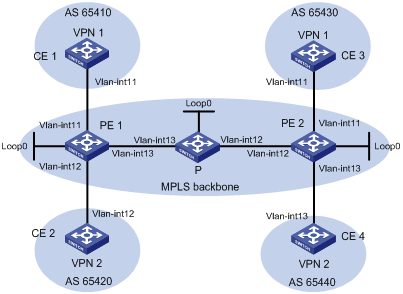
Table 1 Interface and IP address assignment
|
Device |
Interface |
IP address |
Device |
Interface |
IP address |
|
CE 1 |
Vlan-int11 |
10.1.1.1/24 |
P |
Loop0 |
2.2.2.9/32 |
|
PE 1 |
Loop0 |
1.1.1.9/32 |
|
Vlan-int12 |
172.2.1.1/24 |
|
|
Vlan-int11 |
10.1.1.2/24 |
|
Vlan-int13 |
172.1.1.2/24 |
|
|
Vlan-int13 |
172.1.1.1/24 |
PE 2 |
Loop0 |
3.3.3.9/32 |
|
|
Vlan-int12 |
10.2.1.2/24 |
|
Vlan-int12 |
172.2.1.2/24 |
|
CE 2 |
Vlan-int12 |
10.2.1.1/24 |
|
Vlan-int11 |
10.3.1.2/24 |
|
CE 3 |
Vlan-int11 |
10.3.1.1/24 |
|
Vlan-int13 |
10.4.1.2/24 |
|
CE 4 |
Vlan-int13 |
10.4.1.1/24 |
|
|
|
Configuration procedure
1. Configure an IGP on the MPLS backbone to ensure IP connectivity within the backbone:
# Configure PE 1.
<PE1> system-view
[PE1] interface loopback 0
[PE1-LoopBack0] ip address 1.1.1.9 32
[PE1-LoopBack0] quit
[PE1] interface vlan-interface 13
[PE1-Vlan-interface13] ip address 172.1.1.1 24
[PE1-Vlan-interface13] quit
[PE1] ospf
[PE1-ospf-1] area 0
[PE1-ospf-1-area-0.0.0.0] network 172.1.1.0 0.0.0.255
[PE1-ospf-1-area-0.0.0.0] network 1.1.1.9 0.0.0.0
[PE1-ospf-1-area-0.0.0.0] quit
[PE1-ospf-1] quit
# Configure the P device.
<P> system-view
[P] interface loopback 0
[P-LoopBack0] ip address 2.2.2.9 32
[P-LoopBack0] quit
[P] interface vlan-interface 13
[P-Vlan-interface13] ip address 172.1.1.2 24
[P-Vlan-interface13] quit
[P] interface vlan-interface 12
[P-Vlan-interface12] ip address 172.2.1.1 24
[P-Vlan-interface12] quit
[P] ospf
[P-ospf-1] area 0
[P-ospf-1-area-0.0.0.0] network 172.1.1.0 0.0.0.255
[P-ospf-1-area-0.0.0.0] network 172.2.1.0 0.0.0.255
[P-ospf-1-area-0.0.0.0] network 2.2.2.9 0.0.0.0
[P-ospf-1-area-0.0.0.0] quit
[P-ospf-1] quit
# Configure PE 2.
<PE2> system-view
[PE2] interface loopback 0
[PE2-LoopBack0] ip address 3.3.3.9 32
[PE2-LoopBack0] quit
[PE2] interface vlan-interface 12
[PE2-Vlan-interface12] ip address 172.2.1.2 24
[PE2-Vlan-interface12] quit
[PE2] ospf
[PE2-ospf-1] area 0
[PE2-ospf-1-area-0.0.0.0] network 172.2.1.0 0.0.0.255
[PE2-ospf-1-area-0.0.0.0] network 3.3.3.9 0.0.0.0
[PE2-ospf-1-area-0.0.0.0] quit
[PE2-ospf-1] quit
# Execute the display ospf peer command to verify that OSPF adjacencies in Full state have been established between PE 1, P, and PE 2. Execute the display ip routing-table command to verify that the PEs have learned the routes to the loopback interfaces of each other. (Details not shown.)
2. Configure basic MPLS and MPLS LDP on the MPLS backbone to establish LDP LSPs:
# Configure PE 1.
[PE1] mpls lsr-id 1.1.1.9
[PE1] mpls ldp
[PE1-ldp] quit
[PE1] interface vlan-interface 13
[PE1-Vlan-interface13] mpls enable
[PE1-Vlan-interface13] mpls ldp enable
[PE1-Vlan-interface13] quit
# Configure the P device.
[P] mpls lsr-id 2.2.2.9
[P] mpls ldp
[P-ldp] quit
[P] interface vlan-interface 13
[P-Vlan-interface13] mpls enable
[P-Vlan-interface13] mpls ldp enable
[P-Vlan-interface13] quit
[P] interface vlan-interface 12
[P-Vlan-interface12] mpls enable
[P-Vlan-interface12] mpls ldp enable
[P-Vlan-interface12] quit
# Configure PE 2.
[PE2] mpls lsr-id 3.3.3.9
[PE2] mpls ldp
[PE2-ldp] quit
[PE2] interface vlan-interface 12
[PE2-Vlan-interface12] mpls enable
[PE2-Vlan-interface12] mpls ldp enable
[PE2-Vlan-interface12] quit
# Execute the display mpls ldp peer command to verify that LDP sessions in Operational state have been established between PE 1, P, and PE 2. Execute the display mpls ldp lsp command to verify that the LSPs have been established by LDP. (Details not shown.)
3. Configure VPN instances on PEs:
# Configure PE 1.
[PE1] ip vpn-instance vpn1
[PE1-vpn-instance-vpn1] route-distinguisher 100:1
[PE1-vpn-instance-vpn1] vpn-target 111:1
[PE1-vpn-instance-vpn1] quit
[PE1] ip vpn-instance vpn2
[PE1-vpn-instance-vpn2] route-distinguisher 100:2
[PE1-vpn-instance-vpn2] vpn-target 222:2
[PE1-vpn-instance-vpn2] quit
[PE1] interface vlan-interface 11
[PE1-Vlan-interface11] ip binding vpn-instance vpn1
[PE1-Vlan-interface11] ip address 10.1.1.2 24
[PE1-Vlan-interface11] quit
[PE1] interface vlan-interface 12
[PE1-Vlan-interface12] ip binding vpn-instance vpn2
[PE1-Vlan-interface12] ip address 10.2.1.2 24
[PE1-Vlan-interface12] quit
# Configure PE 2.
[PE2] ip vpn-instance vpn1
[PE2-vpn-instance-vpn1] route-distinguisher 200:1
[PE2-vpn-instance-vpn1] vpn-target 111:1
[PE2-vpn-instance-vpn1] quit
[PE2] ip vpn-instance vpn2
[PE2-vpn-instance-vpn2] route-distinguisher 200:2
[PE2-vpn-instance-vpn2] vpn-target 222:2
[PE2-vpn-instance-vpn2] quit
[PE2] interface vlan-interface 11
[PE2-Vlan-interface11] ip binding vpn-instance vpn1
[PE2-Vlan-interface11] ip address 10.3.1.2 24
[PE2-Vlan-interface11] quit
[PE2] interface vlan-interface 13
[PE2-Vlan-interface13] ip binding vpn-instance vpn2
[PE2-Vlan-interface13] ip address 10.4.1.2 24
[PE2-Vlan-interface13] quit
# Configure IP addresses for the CEs according to Figure 19. (Details not shown.)
# Execute the display ip vpn-instance command on the PEs to display the configuration of the VPN instance, for example, on PE 1.
[PE1] display ip vpn-instance
Total VPN-Instances configured : 2
VPN-Instance Name RD Create time
vpn1 100:1 2012/02/13 12:49:08
vpn2 100:2 2012/02/13 12:49:20
# Use the ping command on the PEs to verify that the PEs can ping their attached CEs, for example, on PE 1.
[PE1] ping -vpn-instance vpn1 10.1.1.1
Ping 10.1.1.1 (10.1.1.1): 56 data bytes, press CTRL_C to break
56 bytes from 10.1.1.1: icmp_seq=0 ttl=255 time=1.000 ms
56 bytes from 10.1.1.1: icmp_seq=1 ttl=255 time=2.000 ms
56 bytes from 10.1.1.1: icmp_seq=2 ttl=255 time=0.000 ms
56 bytes from 10.1.1.1: icmp_seq=3 ttl=255 time=1.000 ms
56 bytes from 10.1.1.1: icmp_seq=4 ttl=255 time=0.000 ms
--- Ping statistics for 10.1.1.1 ---
5 packet(s) transmitted, 5 packet(s) received, 0.0% packet loss
round-trip min/avg/max/std-dev = 0.000/0.800/2.000/0.748 ms
4. Establish EBGP peer relationships between PEs and CEs, and redistribute VPN routes into BGP:
# Configure CE 1.
<CE1> system-view
[CE1] bgp 65410
[CE1-bgp-default] peer 10.1.1.2 as-number 100
[CE1-bgp-default] address-family ipv4 unicast
[CE1-bgp-default-ipv4] peer 10.1.1.2 enable
[CE1-bgp-default-ipv4] import-route direct
[CE1-bgp-default-ipv4] quit
[CE1-bgp-default] quit
# Configure the other three CEs in the same way that CE 1 is configured. (Details not shown.)
# Configure PE 1.
[PE1] bgp 100
[PE1-bgp-default] ip vpn-instance vpn1
[PE1-bgp-default-vpn1] peer 10.1.1.1 as-number 65410
[PE1-bgp-default-vpn1] address-family ipv4 unicast
[PE1-bgp-default-ipv4-vpn1] peer 10.1.1.1 enable
[PE1-bgp-default-ipv4-vpn1] quit
[PE1-bgp-default-vpn1] quit
[PE1-bgp-default] ip vpn-instance vpn2
[PE1-bgp-default-vpn2] peer 10.2.1.1 as-number 65420
[PE1-bgp-default-vpn2] address-family ipv4 unicast
[PE1-bgp-default-ipv4-vpn1] peer 10.2.1.1 enable
[PE1-bgp-default-ipv4-vpn2] quit
[PE1-bgp-default-vpn1] quit
[PE1-bgp-default] quit
# Configure PE 2 in the same way that PE 1 is configured. (Details not shown.)
# Execute the display bgp peer ipv4 vpn-instance command on the PEs to verify that a BGP peer relationship in Established state has been established between a PE and a CE. (Details not shown.)
5. Establish an MP-IBGP peer relationship between PEs:
# Configure PE 1.
[PE1] bgp 100
[PE1-bgp-default] peer 3.3.3.9 as-number 100
[PE1-bgp-default] peer 3.3.3.9 connect-interface loopback 0
[PE1-bgp-default] address-family vpnv4
[PE1-bgp-default-vpnv4] peer 3.3.3.9 enable
[PE1-bgp-default-vpnv4] quit
[PE1-bgp-default] quit
# Configure PE 2.
[PE2] bgp 100
[PE2-bgp-default] peer 1.1.1.9 as-number 100
[PE2-bgp-default] peer 1.1.1.9 connect-interface loopback 0
[PE2-bgp-default] address-family vpnv4
[PE2-bgp-default-vpnv4] peer 1.1.1.9 enable
[PE2-bgp-default-vpnv4] quit
[PE2-bgp-default] quit
# Execute the display bgp peer vpnv4 command on the PEs to verify that a BGP peer relationship in Established state has been established between the PEs. (Details not shown.)
Verifying the configuration
# Execute the display ip routing-table vpn-instance command on the PEs.
[PE1] display ip routing-table vpn-instance vpn1
Destinations : 13 Routes : 13
Destination/Mask Proto Pre Cost NextHop Interface
0.0.0.0/32 Direct 0 0 127.0.0.1 InLoop0
10.1.1.0/24 Direct 0 0 10.1.1.2 Vlan11
10.1.1.0/32 Direct 0 0 10.1.1.2 Vlan11
10.1.1.2/32 Direct 0 0 127.0.0.1 InLoop0
10.1.1.255/32 Direct 0 0 10.1.1.2 Vlan11
10.3.1.0/24 BGP 255 0 3.3.3.9 Vlan13
127.0.0.0/8 Direct 0 0 127.0.0.1 InLoop0
127.0.0.0/32 Direct 0 0 127.0.0.1 InLoop0
127.0.0.1/32 Direct 0 0 127.0.0.1 InLoop0
127.255.255.255/32 Direct 0 0 127.0.0.1 InLoop0
224.0.0.0/4 Direct 0 0 0.0.0.0 NULL0
224.0.0.0/24 Direct 0 0 0.0.0.0 NULL0
255.255.255.255/32 Direct 0 0 127.0.0.1 InLoop0
The output shows that PE 1 has a route to the remote CE. Output on PE 2 is similar.
# Verify that CEs of the same VPN can ping each other, whereas those of different VPNs cannot. For example, CE 1 can ping CE 3 (10.3.1.1) but cannot ping CE 4 (10.4.1.1). (Details not shown.)
Configuring a hub-spoke network
Network requirements
The Spoke-CEs cannot communicate directly. They can communicate only through Hub-CE.
Configure EBGP between the Spoke-CEs and Spoke-PEs and between Hub-CE and Hub-PE to exchange VPN routing information.
Configure OSPF between the Spoke-PEs and Hub-PE to implement communication between the PEs, and configure MP-IBGP between them to exchange VPN routing information.
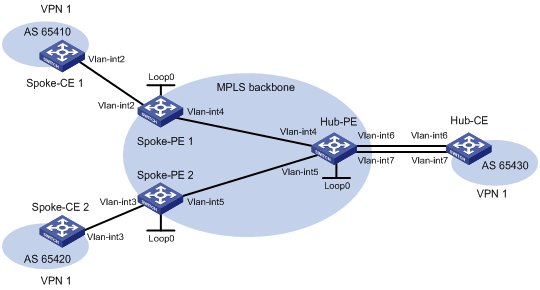
Table 2 Interface and IP address assignment
|
Device |
Interface |
IP address |
Device |
Interface |
IP address |
|
Spoke-CE 1 |
Vlan-int2 |
10.1.1.1/24 |
Hub-CE |
Vlan-int6 |
10.3.1.1/24 |
|
Spoke-PE 1 |
Loop0 |
1.1.1.9/32 |
|
Vlan-int7 |
10.4.1.1/24 |
|
|
Vlan-int2 |
10.1.1.2/24 |
Hub-PE |
Loop0 |
2.2.2.9/32 |
|
|
Vlan-int4 |
172.1.1.1/24 |
|
Vlan-int4 |
172.1.1.2/24 |
|
Spoke-CE 2 |
Vlan-int3 |
10.2.1.1/24 |
|
Vlan-int5 |
172.2.1.2/24 |
|
Spoke-PE 2 |
Loop0 |
3.3.3.9/32 |
|
Vlan-int6 |
10.3.1.2/24 |
|
|
Vlan-int3 |
10.2.1.2/24 |
|
Vlan-int7 |
10.4.1.2/24 |
|
|
Vlan-int5 |
172.2.1.1/24 |
|
|
|
Configuration procedure
1. Configure an IGP on the MPLS backbone to ensure IP connectivity within the backbone:
# Configure Spoke-PE 1.
<Spoke-PE1> system-view
[Spoke-PE1] interface loopback 0
[Spoke-PE1-LoopBack0] ip address 1.1.1.9 32
[Spoke-PE1-LoopBack0] quit
[Spoke-PE1] interface vlan-interface 4
[Spoke-PE1-Vlan-interface4] ip address 172.1.1.1 24
[Spoke-PE1-Vlan-interface4] quit
[Spoke-PE1] ospf
[Spoke-PE1-ospf-1] area 0
[Spoke-PE1-ospf-1-area-0.0.0.0] network 172.1.1.0 0.0.0.255
[Spoke-PE1-ospf-1-area-0.0.0.0] network 1.1.1.9 0.0.0.0
[Spoke-PE1-ospf-1-area-0.0.0.0] quit
[Spoke-PE1-ospf-1] quit
# Configure Spoke-PE 2.
<Spoke-PE2> system-view
[Spoke-PE2] interface loopback 0
[Spoke-PE2-LoopBack0] ip address 3.3.3.9 32
[Spoke-PE2-LoopBack0] quit
[Spoke-PE2] interface vlan-interface 5
[Spoke-PE2-Vlan-interface5] ip address 172.2.1.1 24
[Spoke-PE2-Vlan-interface5] quit
[Spoke-PE2] ospf
[Spoke-PE2-ospf-1] area 0
[Spoke-PE2-ospf-1-area-0.0.0.0] network 172.2.1.0 0.0.0.255
[Spoke-PE2-ospf-1-area-0.0.0.0] network 3.3.3.9 0.0.0.0
[Spoke-PE2-ospf-1-area-0.0.0.0] quit
[Spoke-PE2-ospf-1] quit
# Configure Hub-PE.
<Hub-PE> system-view
[Hub-PE] interface loopback 0
[Hub-PE-LoopBack0] ip address 2.2.2.9 32
[Hub-PE-LoopBack0] quit
[Hub-PE] interface vlan-interface 4
[Hub-PE-Vlan-interface4] ip address 172.1.1.2 24
[Hub-PE-Vlan-interface4] quit
[Hub-PE] interface vlan-interface 5
[Hub-PE-Vlan-interface5] ip address 172.2.1.2 24
[Hub-PE-Vlan-interface5] quit
[Hub-PE] ospf
[Hub-PE-ospf-1] area 0
[Hub-PE-ospf-1-area-0.0.0.0] network 172.1.1.0 0.0.0.255
[Hub-PE-ospf-1-area-0.0.0.0] network 172.2.1.0 0.0.0.255
[Hub-PE-ospf-1-area-0.0.0.0] network 2.2.2.9 0.0.0.0
[Hub-PE-ospf-1-area-0.0.0.0] quit
[Hub-PE-ospf-1] quit
# Execute the display ospf peer command on the devices to verify that OSPF adjacencies in Full state have been established between Spoke-PE 1, Spoke-PE 2, and Hub-PE. Execute the display ip routing-table command on the devices to verify that the PEs have learned the routes to the loopback interfaces of each other. (Details not shown.)
2. Configure basic MPLS and MPLS LDP on the MPLS backbone to establish LDP LSPs:
# Configure Spoke-PE 1.
[Spoke-PE1] mpls lsr-id 1.1.1.9
[Spoke-PE1] mpls ldp
[Spoke-PE1-ldp] quit
[Spoke-PE1] interface vlan-interface 4
[Spoke-PE1-Vlan-interface4] mpls enable
[Spoke-PE1-Vlan-interface4] mpls ldp enable
[Spoke-PE1-Vlan-interface4] quit
# Configure Spoke-PE 2.
[Spoke-PE2] mpls lsr-id 3.3.3.9
[Spoke-PE2] mpls ldp
[Spoke-PE2-ldp] quit
[Spoke-PE2] interface vlan-interface 5
[Spoke-PE2-Vlan-interface5] mpls enable
[Spoke-PE2-Vlan-interface5] mpls ldp enable
[Spoke-PE2-Vlan-interface5] quit
# Configure Hub-PE.
[Hub-PE] mpls lsr-id 2.2.2.9
[Hub-PE] mpls ldp
[Hub-PE-ldp] quit
[Hub-PE] interface vlan-interface 4
[Hub-PE-Vlan-interface4] mpls enable
[Hub-PE-Vlan-interface4] mpls ldp enable
[Hub-PE-Vlan-interface4] quit
[Hub-PE] interface vlan-interface 5
[Hub-PE-Vlan-interface5] mpls enable
[Hub-PE-Vlan-interface5] mpls ldp enable
[Hub-PE-Vlan-interface5] quit
# Execute the display mpls ldp peer command on the devices to verify that LDP sessions in Operational state have been established between Spoke-PE 1, Spoke-PE 2, and Hub-PE. Execute the display mpls ldp lsp command on the devices to verify that the LSPs have been established by LDP. (Details not shown.)
3. Configure VPN instances on the Spoke-PEs and Hub-PE:
# Configure Spoke-PE 1.
[Spoke-PE1] ip vpn-instance vpn1
[Spoke-PE1-vpn-instance-vpn1] route-distinguisher 100:1
[Spoke-PE1-vpn-instance-vpn1] vpn-target 111:1 import-extcommunity
[Spoke-PE1-vpn-instance-vpn1] vpn-target 222:2 export-extcommunity
[Spoke-PE1-vpn-instance-vpn1] quit
[Spoke-PE1] interface vlan-interface 2
[Spoke-PE1-Vlan-interface2] ip binding vpn-instance vpn1
[Spoke-PE1-Vlan-interface2] ip address 10.1.1.2 24
[Spoke-PE1-Vlan-interface2] quit
# Configure Spoke-PE 2.
[Spoke-PE2] ip vpn-instance vpn1
[Spoke-PE2-vpn-instance-vpn1] route-distinguisher 100:2
[Spoke-PE2-vpn-instance-vpn1] vpn-target 111:1 import-extcommunity
[Spoke-PE2-vpn-instance-vpn1] vpn-target 222:2 export-extcommunity
[Spoke-PE2-vpn-instance-vpn1] quit
[Spoke-PE2] interface vlan-interface 3
[Spoke-PE2-Vlan-interface3] ip binding vpn-instance vpn1
[Spoke-PE2-Vlan-interface3] ip address 10.2.1.2 24
[Spoke-PE2-Vlan-interface3] quit
# Configure Hub-PE.
[Hub-PE] ip vpn-instance vpn1-in
[Hub-PE-vpn-instance-vpn1-in] route-distinguisher 100:3
[Hub-PE-vpn-instance-vpn1-in] vpn-target 222:2 import-extcommunity
[Hub-PE-vpn-instance-vpn1-in] quit
[Hub-PE] ip vpn-instance vpn1-out
[Hub-PE-vpn-instance-vpn1-out] route-distinguisher 100:4
[Hub-PE-vpn-instance-vpn1-out] vpn-target 111:1 export-extcommunity
[Hub-PE-vpn-instance-vpn1-out] quit
[Hub-PE] interface vlan-interface 6
[Hub-PE-Vlan-interface6] ip binding vpn-instance vpn1-in
[Hub-PE-Vlan-interface6] ip address 10.3.1.2 24
[Hub-PE-Vlan-interface6] quit
[Hub-PE] interface vlan-interface 7
[Hub-PE-Vlan-interface7] ip binding vpn-instance vpn1-out
[Hub-PE-Vlan-interface7] ip address 10.4.1.2 24
[Hub-PE-Vlan-interface7] quit
# Configure IP addresses for the CEs according to Table 2. (Details not shown.)
# Execute the display ip vpn-instance command on the PEs to display the configuration of the VPN instance, for example, on Spoke-PE 1.
[Spoke-PE1] display ip vpn-instance
Total VPN-Instances configured : 1
VPN-Instance Name RD Create time
vpn1 100:1 2009/04/08 10:55:07
# Use the ping command on the PEs to verify that the PEs can ping their attached CEs, for example, on Spoke-PE 1.
[Spoke-PE1] ping -vpn-instance vpn1 10.1.1.1
Ping 10.1.1.1 (10.1.1.1): 56 data bytes, press CTRL_C to break
56 bytes from 10.1.1.1: icmp_seq=0 ttl=128 time=1.913 ms
56 bytes from 10.1.1.1: icmp_seq=1 ttl=128 time=2.381 ms
56 bytes from 10.1.1.1: icmp_seq=2 ttl=128 time=1.707 ms
56 bytes from 10.1.1.1: icmp_seq=3 ttl=128 time=1.666 ms
56 bytes from 10.1.1.1: icmp_seq=4 ttl=128 time=2.710 ms
--- Ping statistics for 10.1.1.1 ---
5 packet(s) transmitted, 5 packet(s) received, 0.0% packet loss
round-trip min/avg/max/std-dev = 1.666/2.075/2.710/0.406 ms
4. Establish EBGP peer relationships between the PEs and CEs, and redistribute VPN routes into BGP:
# Configure Spoke-CE 1.
<Spoke-CE1> system-view
[Spoke-CE1] bgp 65410
[Spoke-CE1-bgp-default] peer 10.1.1.2 as-number 100
[Spoke-CE1-bgp-default] address-family ipv4
[Spoke-CE1-bgp-default-ipv4] peer 10.1.1.2 enable
[Spoke-CE1-bgp-default-ipv4] import-route direct
[Spoke-CE1-bgp-default-ipv4] quit
[Spoke-CE1-bgp-default] quit
# Configure Spoke-CE 2.
<Spoke-CE2> system-view
[Spoke-CE2] bgp 65420
[Spoke-CE2-bgp-default] peer 10.2.1.2 as-number 100
[Spoke-CE2-bgp-default] address-family ipv4
[Spoke-CE2-bgp-default-ipv4] peer 10.2.1.2 enable
[Spoke-CE2-bgp-default-ipv4] import-route direct
[Spoke-CE2-bgp-default-ipv4] quit
[Spoke-CE2-bgp-default] quit
# Configure Hub-CE.
<Hub-CE> system-view
[Hub-CE] bgp 65430
[Hub-CE-bgp-default] peer 10.3.1.2 as-number 100
[Hub-CE-bgp-default] peer 10.4.1.2 as-number 100
[Hub-CE-bgp-default] address-family ipv4
[Hub-CE-bgp-default-ipv4] peer 10.3.1.2 enable
[Hub-CE-bgp-default-ipv4] peer 10.4.1.2 enable
[Hub-CE-bgp-default-ipv4] import-route direct
[Hub-CE-bgp-default-ipv4] quit
[Hub-CE-bgp-default] quit
# Configure Spoke-PE 1.
[Spoke-PE1] bgp 100
[Spoke-PE1-bgp-default] ip vpn-instance vpn1
[Spoke-PE1-bgp-default-vpn1] peer 10.1.1.1 as-number 65410
[Spoke-PE1-bgp-default-vpn1] address-family ipv4
[Spoke-PE1-bgp-default-ipv4-vpn1] peer 10.1.1.1 enable
[Spoke-PE1-bgp-default-ipv4-vpn1] quit
[Spoke-PE1-bgp-default-vpn1] quit
[Spoke-PE1-bgp-default] quit
# Configure Spoke-PE 2.
[Spoke-PE2] bgp 100
[Spoke-PE2-bgp-default] ip vpn-instance vpn1
[Spoke-PE2-bgp-default-vpn1] peer 10.2.1.1 as-number 65420
[Spoke-PE2-bgp-default-vpn1] address-family ipv4
[Spoke-PE2-bgp-default-ipv4-vpn1] peer 10.2.1.1 enable
[Spoke-PE2-bgp-default-ipv4-vpn1] quit
[Spoke-PE2-bgp-default-vpn1] quit
[Spoke-PE2-bgp-default] quit
# Configure Hub-PE.
[Hub-PE] bgp 100
[Hub-PE-bgp-default] ip vpn-instance vpn1-in
[Hub-PE-bgp-default-vpn1-in] peer 10.3.1.1 as-number 65430
[Hub-PE-bgp-default-vpn1-in] address-family ipv4
[Hub-PE-bgp-default-ipv4-vpn1-in] peer 10.3.1.1 enable
[Hub-PE-bgp-default-ipv4-vpn1-in] quit
[Hub-PE-bgp-default-vpn1-in] quit
[Hub-PE-bgp-default] ip vpn-instance vpn1-out
[Hub-PE-bgp-default-vpn1-out] peer 10.4.1.1 as-number 65430
[Hub-PE-bgp-default-vpn1-out] address-family ipv4
[Hub-PE-bgp-default-ipv4-vpn1-out] peer 10.4.1.1 enable
[Hub-PE-bgp-default-ipv4-vpn1-out] peer 10.4.1.1 allow-as-loop 2
[Hub-PE-bgp-default-ipv4-vpn1-out] quit
[Hub-PE-bgp-default-vpn1-out] quit
[Hub-PE-bgp-default] quit
# Execute the display bgp peer ipv4 vpn-instance command on the PEs to verify that a BGP peer relationship in Established state has been established between a PE and a CE. (Details not shown.)
5. Establish an MP-IBGP peer relationship between the Spoke-PEs and Hub-PE:
# Configure Spoke-PE 1.
[Spoke-PE1] bgp 100
[Spoke-PE1-bgp-default] peer 2.2.2.9 as-number 100
[Spoke-PE1-bgp-default] peer 2.2.2.9 connect-interface loopback 0
[Spoke-PE1-bgp-default] address-family vpnv4
[Spoke-PE1-bgp-default-vpnv4] peer 2.2.2.9 enable
[Spoke-PE1-bgp-default-vpnv4] quit
[Spoke-PE1-bgp-default] quit
# Configure Spoke-PE 2.
[Spoke-PE2] bgp 100
[Spoke-PE2-bgp-default] peer 2.2.2.9 as-number 100
[Spoke-PE2-bgp-default] peer 2.2.2.9 connect-interface loopback 0
[Spoke-PE2-bgp-default] address-family vpnv4
[Spoke-PE2-bgp-default-vpnv4] peer 2.2.2.9 enable
[Spoke-PE2-bgp-default-vpnv4] quit
[Spoke-PE2-bgp-default] quit
# Configure Hub-PE.
[Hub-PE] bgp 100
[Hub-PE-bgp-default] peer 1.1.1.9 as-number 100
[Hub-PE-bgp-default] peer 1.1.1.9 connect-interface loopback 0
[Hub-PE-bgp-default] peer 3.3.3.9 as-number 100
[Hub-PE-bgp-default] peer 3.3.3.9 connect-interface loopback 0
[Hub-PE-bgp-default] address-family vpnv4
[Hub-PE-bgp-default-vpnv4] peer 1.1.1.9 enable
[Hub-PE-bgp-default-vpnv4] peer 3.3.3.9 enable
[Hub-PE-bgp-default-vpnv4] quit
[Hub-PE-bgp-default] quit
# Execute the display bgp peer vpnv4 command on the PEs to verify that a BGP peer relationship in Established state has been established between the PEs. (Details not shown.)
Verifying the configuration
# Execute the display ip routing-table vpn-instance command on the PEs to display the routes to the CEs. This example uses Spoke-PE 1 to verify that the next hop of the route from a Spoke-PE to its connected Spoke-CE is Hub-PE.
[Spoke-PE1] display ip routing-table vpn-instance vpn1
Destinations : 15 Routes : 15
Destination/Mask Proto Pre Cost NextHop Interface
0.0.0.0/32 Direct 0 0 127.0.0.1 InLoop0
10.1.1.0/24 Direct 0 0 10.1.1.2 Vlan2
10.1.1.0/32 Direct 0 0 10.1.1.2 Vlan2
10.1.1.2/32 Direct 0 0 127.0.0.1 InLoop0
10.1.1.255/32 Direct 0 0 10.1.1.2 Vlan2
10.2.1.0/24 BGP 255 0 2.2.2.9 Vlan4
10.3.1.0/24 BGP 255 0 2.2.2.9 Vlan4
10.4.1.0/24 BGP 255 0 2.2.2.9 Vlan4
127.0.0.0/8 Direct 0 0 127.0.0.1 InLoop0
127.0.0.0/32 Direct 0 0 127.0.0.1 InLoop0
127.0.0.1/32 Direct 0 0 127.0.0.1 InLoop0
127.255.255.255/32 Direct 0 0 127.0.0.1 InLoop0
224.0.0.0/4 Direct 0 0 0.0.0.0 NULL0
224.0.0.0/24 Direct 0 0 0.0.0.0 NULL0
255.255.255.255/32 Direct 0 0 127.0.0.1 InLoop0
# Verify that Spoke-CE 1 and Spoke-CE 2 can ping each other. The TTL value indicates that traffic from Spoke-CE 1 to Spoke-CE 2 passes six hops (255-250+1) and is forwarded through Hub-CE. This example uses Spoke-CE 1 to verify their connectivity.
[Spoke-CE1] ping 10.2.1.1
Ping 10.2.1.1 (10.2.1.1): 56 data bytes, press CTRL_C to break
56 bytes from 10.2.1.1: icmp_seq=0 ttl=250 time=1.000 ms
56 bytes from 10.2.1.1: icmp_seq=1 ttl=250 time=2.000 ms
56 bytes from 10.2.1.1: icmp_seq=2 ttl=250 time=0.000 ms
56 bytes from 10.2.1.1: icmp_seq=3 ttl=250 time=1.000 ms
56 bytes from 10.2.1.1: icmp_seq=4 ttl=250 time=0.000 ms
--- Ping statistics for 10.2.1.1 ---
5 packet(s) transmitted, 5 packet(s) received, 0.0% packet loss
round-trip min/avg/max/std-dev = 0.000/0.800/2.000/0.748 ms
Configuring MPLS L3VPN inter-AS option A
Network requirements
CE 1 and CE 2 belong to the same VPN. CE 1 accesses the network through PE 1 in AS 100, and CE 2 accesses the network through PE 2 in AS 200.
Configure MPLS L3VPN inter-AS option A, and use the VRF-to-VRF method to manage VPN routes.
Run OSPF on the MPLS backbone in each AS.
Figure 21 Network diagram
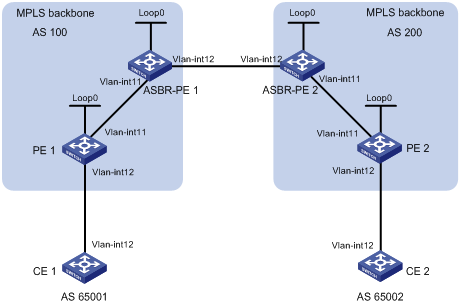
Table 3 Interface and IP address assignment
|
Interface |
IP address |
Device |
Interface |
IP address |
|
|
CE 1 |
Vlan-int12 |
10.1.1.1/24 |
CE 2 |
Vlan-int12 |
10.2.1.1/24 |
|
PE 1 |
Loop0 |
1.1.1.9/32 |
PE 2 |
Loop0 |
4.4.4.9/32 |
|
|
Vlan-int12 |
10.1.1.2/24 |
|
Vlan-int12 |
10.2.1.2/24 |
|
|
Vlan-int11 |
172.1.1.2/24 |
|
Vlan-int11 |
162.1.1.2/24 |
|
ASBR-PE 1 |
Loop0 |
2.2.2.9/32 |
ASBR-PE 2 |
Loop0 |
3.3.3.9/32 |
|
|
Vlan-int11 |
172.1.1.1/24 |
|
Vlan-int11 |
162.1.1.1/24 |
|
|
Vlan-int12 |
192.1.1.1/24 |
|
Vlan-int12 |
192.1.1.2/24 |
Configuration procedure
1. Configure IGP on the MPLS backbone to implement the connectivity in the backbone.
This example uses OSPF. (Details not shown.)
# Execute the display ospf peer command to verify that each ASBR-PE has established an OSPF adjacency in Full state with the PE in the same AS, and that PEs and ASBR-PEs in the same AS have learned the routes to the loopback interfaces of each other. Verify that each ASBR-PE and the PE in the same AS can ping each other. (Details not shown.)
2. Configure basic MPLS and MPLS LDP on the MPLS backbone to establish LDP LSPs:
# Configure basic MPLS on PE 1, and enable MPLS LDP on the interface connected to ASBR-PE 1.
<PE1> system-view
[PE1] mpls lsr-id 1.1.1.9
[PE1] mpls ldp
[PE1-ldp] quit
[PE1] interface vlan-interface 11
[PE1-Vlan-interface11] mpls enable
[PE1-Vlan-interface11] mpls ldp enable
[PE1-Vlan-interface11] quit
# Configure basic MPLS on ASBR-PE 1, and enable MPLS LDP on the interface connected to PE 1.
<ASBR-PE1> system-view
[ASBR-PE1] mpls lsr-id 2.2.2.9
[ASBR-PE1] mpls ldp
[ASBR-PE1-ldp] quit
[ASBR-PE1] interface vlan-interface 11
[ASBR-PE1-Vlan-interface11] mpls enable
[ASBR-PE1-Vlan-interface11] mpls ldp enable
[ASBR-PE1-Vlan-interface11] quit
# Configure basic MPLS on ASBR-PE 2, and enable MPLS LDP on the interface connected to PE 2.
<ASBR-PE2> system-view
[ASBR-PE2] mpls lsr-id 3.3.3.9
[ASBR-PE2] mpls ldp
[ASBR-PE2-ldp] quit
[ASBR-PE2] interface vlan-interface 11
[ASBR-PE2-Vlan-interface11] mpls enable
[ASBR-PE2-Vlan-interface11] mpls ldp enable
[ASBR-PE2-Vlan-interface11] quit
# Configure basic MPLS on PE 2, and enable MPLS LDP on the interface connected to ASBR-PE 2.
<PE2> system-view
[PE2] mpls lsr-id 4.4.4.9
[PE2] mpls ldp
[PE2-ldp] quit
[PE2] interface vlan-interface 11
[PE2-Vlan-interface11] mpls enable
[PE2-Vlan-interface11] mpls ldp enable
[PE2-Vlan-interface11] quit
# Execute the display mpls ldp peer command on the devices to verify that the session status is Operational, and that each PE and the ASBR-PE in the same AS have established a neighbor relationship. (Details not shown.)
3. Configure VPN instances on PEs:
For the same VPN, the route targets for the VPN instance on the PE must match those for the VPN instance on the ASBR-PE in the same AS. This is not required for PEs in different ASs.
# Configure CE 1.
<CE1> system-view
[CE1] interface vlan-interface 12
[CE1-Vlan-interface12] ip address 10.1.1.1 24
[CE1-Vlan-interface12] quit
# Configure PE 1.
[PE1] ip vpn-instance vpn1
[PE1-vpn-instance-vpn1] route-distinguisher 100:1
[PE1-vpn-instance-vpn1] vpn-target 100:1 both
[PE1-vpn-instance-vpn1] quit
[PE1] interface vlan-interface 12
[PE1-Vlan-interface12] ip binding vpn-instance vpn1
[PE1-Vlan-interface12] ip address 10.1.1.2 24
[PE1-Vlan-interface12] quit
# Configure CE 2.
<CE2> system-view
[CE2] interface vlan-interface 12
[CE2-Vlan-interface12] ip address 10.2.1.1 24
[CE2-Vlan-interface12] quit
# Configure PE 2.
[PE2] ip vpn-instance vpn1
[PE2-vpn-instance] route-distinguisher 200:2
[PE2-vpn-instance] vpn-target 200:1 both
[PE2-vpn-instance] quit
[PE2] interface vlan-interface 12
[PE2-Vlan-interface12] ip binding vpn-instance vpn1
[PE2-Vlan-interface12] ip address 10.2.1.2 24
[PE2-Vlan-interface12] quit
# On ASBR-PE 1, create a VPN instance, and bind the instance to the interface connected to ASBR-PE 2. ASBR-PE 1 considers ASBR-PE 2 to be its CE.
[ASBR-PE1] ip vpn-instance vpn1
[ASBR-PE1-vpn-instance-vpn1] route-distinguisher 100:1
[ASBR-PE1-vpn-instance-vpn1] vpn-target 100:1 both
[ASBR-PE1-vpn-instance-vpn1] quit
[ASBR-PE1] interface vlan-interface 12
[ASBR-PE1-Vlan-interface12] ip binding vpn-instance vpn1
[ASBR-PE1-Vlan-interface12] ip address 192.1.1.1 24
[ASBR-PE1-Vlan-interface12] quit
# On ASBR-PE 2, create a VPN instance, and bind the instance to the interface connected to ASBR-PE 1. ASBR-PE 2 considers ASBR-PE 1 to be its CE.
[ASBR-PE2] ip vpn-instance vpn1
[ASBR-PE2-vpn-vpn-vpn1] route-distinguisher 200:1
[ASBR-PE2-vpn-vpn-vpn1] vpn-target 200:1 both
[ASBR-PE2-vpn-vpn-vpn1] quit
[ASBR-PE2] interface vlan-interface 12
[ASBR-PE2-Vlan-interface12] ip binding vpn-instance vpn1
[ASBR-PE2-Vlan-interface12] ip address 192.1.1.2 24
[ASBR-PE2-Vlan-interface12] quit
# Execute the display ip vpn-instance command to display VPN instance configurations. Verify that the PEs can ping the CEs, and the ASBR-PEs can ping each other. (Details not shown.)
4. Establish EBGP peer relationships between PEs and CEs, and redistribute VPN routes into BGP:
# Configure CE 1.
[CE1] bgp 65001
[CE1-bgp-default] peer 10.1.1.2 as-number 100
[CE1-bgp-default] address-family ipv4 unicast
[CE1-bgp-default-ipv4] peer 10.1.1.2 enable
[CE1-bgp-default-ipv4] import-route direct
[CE1-bgp-default-ipv4] quit
[CE1-bgp-default] quit
# Configure PE 1.
[PE1] bgp 100
[PE1-bgp-default] ip vpn-instance vpn1
[PE1-bgp-default-vpn1] peer 10.1.1.1 as-number 65001
[PE1-bgp-default-vpn1] address-family ipv4 unicast
[PE1-bgp-default-ipv4-vpn1] peer 10.1.1.1 enable
[PE1-bgp-default-ipv4-vpn1] quit
[PE1-bgp-default-vpn1] quit
[PE1-bgp-default] quit
# Configure CE 2.
[CE2] bgp 65002
[CE2-bgp-default] peer 10.2.1.2 as-number 200
[CE2-bgp-default] address-family ipv4 unicast
[CE2-bgp-default-ipv4] peer 10.2.1.2 enable
[CE2-bgp-default-ipv4] import-route direct
[CE2-bgp-default-ipv4] quit
[CE2-bgp-default] quit
# Configure PE 2.
[PE2] bgp 200
[PE2-bgp-default] ip vpn-instance vpn1
[PE2-bgp-default-vpn1] peer 10.2.1.1 as-number 65002
[PE2-bgp-default-vpn1] address-family ipv4 unicast
[PE2-bgp-default-ipv4-vpn1] peer 10.2.1.1 enable
[PE2-bgp-default-ipv4-vpn1] quit
[PE2-bgp-default-vpn1] quit
[PE2-bgp-default] quit
5. Establish an MP-IBGP peer relationship between each PE and the ASBR-PE in the same AS, and an EBGP peer relationship between the ASBR-PEs:
# Configure PE 1.
[PE1] bgp 100
[PE1-bgp-default] peer 2.2.2.9 as-number 100
[PE1-bgp-default] peer 2.2.2.9 connect-interface loopback 0
[PE1-bgp-default] address-family vpnv4
[PE1-bgp-default-vpnv4] peer 2.2.2.9 enable
[PE1-bgp-default-vpnv4] peer 2.2.2.9 next-hop-local
[PE1-bgp-default-vpnv4] quit
[PE1-bgp-default] quit
# Configure ASBR-PE 1.
[ASBR-PE1] bgp 100
[ASBR-PE1-bgp-default] ip vpn-instance vpn1
[ASBR-PE1-bgp-default-vpn1] peer 192.1.1.2 as-number 200
[ASBR-PE1-bgp-default-vpn1] address-family ipv4 unicast
[ASBR-PE1-bgp-default-ipv4-vpn1] peer 192.1.1.2 enable
[ASBR-PE1-bgp-default-ipv4-vpn1] quit
[ASBR-PE1-bgp-default-vpn1] quit
[ASBR-PE1-bgp-default] peer 1.1.1.9 as-number 100
[ASBR-PE1-bgp-default] peer 1.1.1.9 connect-interface loopback 0
[ASBR-PE1-bgp-default] address-family vpnv4
[ASBR-PE1-bgp-default-vpnv4] peer 1.1.1.9 enable
[ASBR-PE1-bgp-default-vpnv4] peer 1.1.1.9 next-hop-local
[ASBR-PE1-bgp-default-vpnv4] quit
[ASBR-PE1-bgp-default] quit
# Configure ASBR-PE 2.
[ASBR-PE2] bgp 200
[ASBR-PE2-bgp-default] ip vpn-instance vpn1
[ASBR-PE2-bgp-default-vpn1] peer 192.1.1.1 as-number 100
[ASBR-PE2-bgp-default-vpn1] address-family ipv4 unicast
[ASBR-PE2-bgp-default-ipv4-vpn1] peer 192.1.1.1 enable
[ASBR-PE2-bgp-default-ipv4-vpn1] quit
[ASBR-PE2-bgp-default-vpn1] quit
[ASBR-PE2-bgp-default] peer 4.4.4.9 as-number 200
[ASBR-PE2-bgp-default] peer 4.4.4.9 connect-interface loopback 0
[ASBR-PE2-bgp-default] address-family vpnv4
[ASBR-PE2-bgp-default-vpnv4] peer 4.4.4.9 enable
[ASBR-PE2-bgp-default-vpnv4] peer 4.4.4.9 next-hop-local
[ASBR-PE2-bgp-default-vpnv4] quit
[ASBR-PE2-bgp-default] quit
# Configure PE 2.
[PE2] bgp 200
[PE2-bgp-default] peer 3.3.3.9 as-number 200
[PE2-bgp-default] peer 3.3.3.9 connect-interface loopback 0
[PE2-bgp-default] address-family vpnv4
[PE2-bgp-default-vpnv4] peer 3.3.3.9 enable
[PE2-bgp-default-vpnv4] peer 3.3.3.9 next-hop-local
[PE2-bgp-default-vpnv4] quit
[PE2-bgp-default] quit
Verifying the configuration
# Verify that the CEs can learn the interface routes from each other and ping each other. (Details not shown.)
Configuring MPLS L3VPN inter-AS option B
Network requirements
Site 1 and Site 2 belong to the same VPN. CE 1 of Site 1 accesses the network through PE 1 in AS 100. CE 2 of Site 2 accesses the network through PE 2 in AS 600. PEs in the same AS run IS-IS.
PE 1 and ASBR-PE 1 exchange VPNv4 routes through MP-IBGP. PE 2 and ASBR-PE 2 exchange VPNv4 routes through MP-IBGP. ASBR-PE 1 and ASBR-PE 2 exchange VPNv4 routes through MP-EBGP.
ASBRs do not perform route target filtering of received VPN-IPv4 routes.
Figure 22 Network diagram
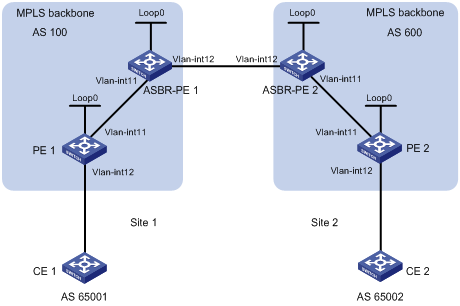
Table 4 Interface and IP address assignment
|
Interface |
IP address |
Device |
Interface |
IP address |
|
|
PE 1 |
Loop0 |
2.2.2.9/32 |
PE 2 |
Loop0 |
5.5.5.9/32 |
|
|
Vlan-int12 |
30.0.0.1/8 |
|
Vlan-int12 |
20.0.0.1/8 |
|
|
Vlan-int11 |
1.1.1.2/8 |
|
Vlan-int11 |
9.1.1.2/8 |
|
ASBR-PE 1 |
Loop0 |
3.3.3.9/32 |
ASBR-PE 2 |
Loop0 |
4.4.4.9/32 |
|
|
Vlan-int11 |
1.1.1.1/8 |
|
Vlan-int11 |
9.1.1.1/8 |
|
|
Vlan-int12 |
11.0.0.2/8 |
|
Vlan-int12 |
11.0.0.1/8 |
Configuration procedure
1. Configure PE 1:
# Configure IS-IS on PE 1.
<PE1> system-view
[PE1] isis 1
[PE1-isis-1] network-entity 10.111.111.111.111.00
[PE1-isis-1] quit
# Configure the LSR ID, and enable MPLS and LDP.
[PE1] mpls lsr-id 2.2.2.9
[PE1] mpls ldp
[PE1-ldp] quit
# Configure VLAN-interface 11, and enable IS-IS, MPLS, and LDP on the interface.
[PE1] interface vlan-interface 11
[PE1-Vlan-interface11] ip address 1.1.1.2 255.0.0.0
[PE1-Vlan-interface11] isis enable 1
[PE1-Vlan-interface11] mpls enable
[PE1-Vlan-interface11] mpls ldp enable
[PE1-Vlan-interface11] quit
# Configure Loopback 0, and enable IS-IS on it.
[PE1] interface loopback 0
[PE1-LoopBack0] ip address 2.2.2.9 32
[PE1-LoopBack0] isis enable 1
[PE1-LoopBack0] quit
# Create VPN instance vpn1, and configure the RD and route target attributes.
[PE1] ip vpn-instance vpn1
[PE1-vpn-instance-vpn1] route-distinguisher 11:11
[PE1-vpn-instance-vpn1] vpn-target 1:1 2:2 3:3 import-extcommunity
[PE1-vpn-instance-vpn1] vpn-target 3:3 export-extcommunity
[PE1-vpn-instance-vpn1] quit
# Bind the interface connected to CE 1 to the created VPN instance.
[PE1] interface vlan-interface 12
[PE1-Vlan-interface12] ip binding vpn-instance vpn1
[PE1-Vlan-interface12] ip address 30.0.0.1 8
[PE1-Vlan-interface12] quit
# Enable BGP on PE 1.
[PE1] bgp 100
# Configure IBGP peer 3.3.3.9 as a VPNv4 peer.
[PE1-bgp-default] peer 3.3.3.9 as-number 100
[PE1-bgp-default] peer 3.3.3.9 connect-interface loopback 0
[PE1-bgp-default] address-family vpnv4
[PE1-bgp-default-vpnv4] peer 3.3.3.9 enable
[PE1-bgp-default-vpnv4] quit
# Redistribute direct routes to the VPN routing table of vpn1.
[PE1-bgp-default] ip vpn-instance vpn1
[PE1-bgp-default-vpn1] address-family ipv4 unicast
[PE1-bgp-default-ipv4-vpn1] import-route direct
[PE1-bgp-default-ipv4-vpn1] quit
[PE1-bgp-default-vpn1] quit
[PE1-bgp-default] quit
2. Configure ASBR-PE 1:
# Enable IS-IS on ASBR-PE 1.
<ASBR-PE1> system-view
[ASBR-PE1] isis 1
[ASBR-PE1-isis-1] network-entity 10.222.222.222.222.00
[ASBR-PE1-isis-1] quit
# Configure the LSR ID, and enable MPLS and LDP.
[ASBR-PE1] mpls lsr-id 3.3.3.9
[ASBR-PE1] mpls ldp
[ASBR-PE1-ldp] quit
# Configure VLAN-interface 11, and enable IS-IS, MPLS, and LDP on the interface.
[ASBR-PE1] interface vlan-interface11
[ASBR-PE1-Vlan-interface11] ip address 1.1.1.1 255.0.0.0
[ASBR-PE1-Vlan-interface11] isis enable 1
[ASBR-PE1-Vlan-interface11] mpls enable
[ASBR-PE1-Vlan-interface11] mpls ldp enable
[ASBR-PE1-Vlan-interface11] quit
# Configure VLAN-interface 12, and enable MPLS on it.
[ASBR-PE1] interface vlan-interface 12
[ASBR-PE1-Vlan-interface12] ip address 11.0.0.2 255.0.0.0
[ASBR-PE1-Vlan-interface12] mpls enable
[ASBR-PE1-Vlan-interface12] quit
# Configure Loopback 0, and enable IS-IS on it.
[ASBR-PE1] interface loopback 0
[ASBR-PE1-LoopBack0] ip address 3.3.3.9 32
[ASBR-PE1-LoopBack0] isis enable 1
[ASBR-PE1-LoopBack0] quit
# Enable BGP on ASBR-PE 1.
[ASBR-PE1] bgp 100
[ASBR-PE1-bgp-default] peer 2.2.2.9 as-number 100
[ASBR-PE1-bgp-default] peer 2.2.2.9 connect-interface loopback 0
[ASBR-PE1-bgp-default] peer 11.0.0.1 as-number 600
[ASBR-PE1-bgp-default] peer 11.0.0.1 connect-interface vlan-interface 12
# Disable route target based filtering of received VPNv4 routes.
[ASBR-PE1-bgp-default] address-family vpnv4
[ASBR-PE1-bgp-default-vpnv4] undo policy vpn-target
# Configure both IBGP peer 2.2.2.0 and EBGP peer 11.0.0.1 as VPNv4 peers.
[ASBR-PE1-bgp-default-vpnv4] peer 11.0.0.1 enable
[ASBR-PE1-bgp-default-vpnv4] peer 2.2.2.9 enable
[ASBR-PE1-bgp-default-vpnv4] quit
3. Configure ASBR-PE 2:
# Enable IS-IS on ASBR-PE 2.
<ASBR-PE2> system-view
[ASBR-PE2] isis 1
[ASBR-PE2-isis-1] network-entity 10.222.222.222.222.00
[ASBR-PE2-isis-1] quit
# Configure the LSR ID, and enable MPLS and LDP.
[ASBR-PE2] mpls lsr-id 4.4.4.9
[ASBR-PE2] mpls ldp
[ASBR-PE2-ldp] quit
# Configure VLAN-interface 11, and enable IS-IS, MPLS, and LDP on the interface.
[ASBR-PE2] interface vlan-interface 11
[ASBR-PE2-Vlan-interface11] ip address 9.1.1.1 255.0.0.0
[ASBR-PE2-Vlan-interface11] isis enable 1
[ASBR-PE2-Vlan-interface11] mpls enable
[ASBR-PE2-Vlan-interface11] mpls ldp enable
[ASBR-PE2-Vlan-interface11] quit
# Configure VLAN-interface 12, and enable MPLS on it.
[ASBR-PE2] interface vlan-interface 12
[ASBR-PE2-Vlan-interface12] ip address 11.0.0.1 255.0.0.0
[ASBR-PE2-Vlan-interface12] mpls enable
[ASBR-PE2-Vlan-interface12] quit
# Configure Loopback 0, and enable IS-IS on it.
[ASBR-PE2] interface loopback 0
[ASBR-PE2-LoopBack0] ip address 4.4.4.9 32
[ASBR-PE2-LoopBack0] isis enable 1
[ASBR-PE2-LoopBack0] quit
# Enable BGP on ASBR-PE 2.
[ASBR-PE2] bgp 600
[ASBR-PE2-bgp-default] peer 11.0.0.2 as-number 100
[ASBR-PE2-bgp-default] peer 11.0.0.2 connect-interface vlan-interface 12
[ASBR-PE2-bgp-default] peer 5.5.5.9 as-number 600
[ASBR-PE2-bgp-default] peer 5.5.5.9 connect-interface loopback 0
# Disable route target based filtering of received VPNv4 routes.
[ASBR-PE2-bgp-default] address-family vpnv4
[ASBR-PE2-bgp-default-vpnv4] undo policy vpn-target
# Configure both IBGP peer 5.5.5.9 and EBGP peer 11.0.0.2 as VPNv4 peers.
[ASBR-PE2-bgp-default-vpnv4] peer 11.0.0.2 enable
[ASBR-PE2-bgp-default-vpnv4] peer 5.5.5.9 enable
[ASBR-PE2-bgp-default-vpnv4] quit
[ASBR-PE2-bgp-default] quit
4. Configure PE 2:
# Enable IS-IS on PE 2.
<PE2> system-view
[PE2] isis 1
[PE2-isis-1] network-entity 10.111.111.111.111.00
[PE2-isis-1] quit
# Configure the LSR ID, and enable MPLS and LDP.
[PE2] mpls lsr-id 5.5.5.9
[PE2] mpls ldp
[PE2-ldp] quit
# Configure VLAN-interface 11, and enable IS-IS, MPLS, and LDP on the interface.
[PE2] interface vlan-interface 11
[PE2-Vlan-interface11] ip address 9.1.1.2 255.0.0.0
[PE2-Vlan-interface11] isis enable 1
[PE2-Vlan-interface11] mpls enable
[PE2-Vlan-interface11] mpls ldp enable
[PE2-Vlan-interface11] quit
# Configure Loopback 0, and enable IS-IS on it.
[PE2] interface loopback 0
[PE2-LoopBack0] ip address 5.5.5.9 32
[PE2-LoopBack0] isis enable 1
[PE2-LoopBack0] quit
# Create VPN instance vpn1, and configure the RD and route target attributes.
[PE2] ip vpn-instance vpn1
[PE2-vpn-instance-vpn1] route-distinguisher 12:12
[PE2-vpn-instance-vpn1] vpn-target 1:1 2:2 3:3 import-extcommunity
[PE2-vpn-instance-vpn1] vpn-target 3:3 export-extcommunity
[PE2-vpn-instance-vpn1] quit
# Bind the interface connected to CE 2 to the created VPN instance.
[PE2] interface vlan-interface12
[PE2-Vlan-interface12] ip binding vpn-instance vpn1
[PE2-Vlan-interface12] ip address 20.0.0.1 8
[PE2-Vlan-interface12] quit
# Enable BGP on PE 2.
[PE2] bgp 600
# Configure IBGP peer 4.4.4.9 as a VPNv4 peer.
[PE2-bgp-default] peer 4.4.4.9 as-number 600
[PE2-bgp-default] peer 4.4.4.9 connect-interface loopback 0
[PE2-bgp-default] address-family vpnv4
[PE2-bgp-default-vpnv4] peer 4.4.4.9 enable
[PE2-bgp-default-vpnv4] quit
# Redistribute direct routes to the VPN routing table of vpn1.
[PE2-bgp-default] ip vpn-instance vpn1
[PE2-bgp-default-vpn1] address-family ipv4 unicast
[PE2-bgp-default-ipv4-vpn1] import-route direct
[PE2-bgp-default-ipv4-vpn1] quit
[PE2-bgp-default-vpn1] quit
[PE2-bgp-default] quit
Verifying the configuration
# Use the following command on PE 1 to verify its connectivity to PE 2.
[PE1] ping -a 30.0.0.1 -vpn-instance vpn1 20.0.0.1
Ping 20.0.0.1 (20.0.0.1) from 30.0.0.1: 56 data bytes, press CTRL_C to break
56 bytes from 20.0.0.1: icmp_seq=0 ttl=255 time=1.208 ms
56 bytes from 20.0.0.1: icmp_seq=1 ttl=255 time=0.867 ms
56 bytes from 20.0.0.1: icmp_seq=2 ttl=255 time=0.551 ms
56 bytes from 20.0.0.1: icmp_seq=3 ttl=255 time=0.566 ms
56 bytes from 20.0.0.1: icmp_seq=4 ttl=255 time=0.570 ms
--- Ping statistics for 20.0.0.1 ---
5 packet(s) transmitted, 5 packet(s) received, 0.0% packet loss
round-trip min/avg/max/std-dev = 0.551/0.752/1.208/0.257 ms
Configuring MPLS L3VPN inter-AS option C
Network requirements
Site 1 and Site 2 belong to the same VPN. Site 1 accesses the network through PE 1 in AS 100. Site 2 accesses the network through PE 2 in AS 600. PEs in the same AS run IS-IS.
PE 1 and ASBR-PE 1 exchange labeled IPv4 routes through IBGP. PE 2 and ASBR-PE 2 exchange labeled IPv4 routes through IBGP. PE 1 and PE 2 exchange VPNv4 routes through MP-EBGP.
ASBR-PE 1 and ASBR-PE 2 use their respective routing policies and label routes received from each other.
ASBR-PE 1 and ASBR-PE 2 use EBGP to exchange labeled IPv4 routes.
Figure 23 Network diagram
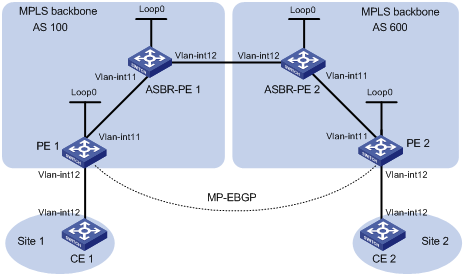
Table 5 Interface and IP address assignment
|
Interface |
IP address |
Device |
Interface |
IP address |
|
|
PE 1 |
Loop0 |
2.2.2.9/32 |
PE 2 |
Loop0 |
5.5.5.9/32 |
|
|
Vlan-int11 |
1.1.1.2/8 |
|
Vlan-int11 |
9.1.1.2/8 |
|
|
Vlan-int12 |
30.0.0.1/24 |
|
Vlan-int12 |
20.0.0.1/24 |
|
ASBR-PE 1 |
Loop0 |
3.3.3.9/32 |
ASBR-PE 2 |
Loop0 |
4.4.4.9/32 |
|
|
Vlan-int11 |
1.1.1.1/8 |
|
Vlan-int11 |
9.1.1.1/8 |
|
|
Vlan-int12 |
11.0.0.2/8 |
|
Vlan-int12 |
11.0.0.1/8 |
|
CE 1 |
Vlan-int12 |
30.0.0.2/24 |
CE 2 |
Vlan-int12 |
20.0.0.2/24 |
Configuration procedure
1. Configure CE 1:
# Configure an IP address for VLAN-interface 12.
<CE1> system-view
[CE1] interface vlan-interface 12
[CE1-Vlan-interface12] ip address 30.0.0.2 24
[CE1-Vlan-interface12] quit
# Establish an EBGP peer relationship with PE 1, and redistribute VPN routes.
[CE1] bgp 65001
[CE1-bgp-default] peer 30.0.0.1 as-number 100
[CE1-bgp-default] address-family ipv4 unicast
[CE1-bgp-default-ipv4] peer 30.0.0.1 enable
[CE1-bgp-default-ipv4] import-route direct
[CE1-bgp-default-ipv4] quit
[CE1-bgp-default] quit
2. Configure PE 1:
# Configure IS-IS on PE 1.
<PE1> system-view
[PE1] isis 1
[PE1-isis-1] network-entity 10.111.111.111.111.00
[PE1-isis-1] quit
# Configure the LSR ID, and enable MPLS and LDP.
[PE1] mpls lsr-id 2.2.2.9
[PE1] mpls ldp
[PE1-ldp] quit
# Configure VLAN-interface 11, and enable IS-IS, MPLS, and LDP on the interface.
[PE1] interface vlan-interface 11
[PE1-Vlan-interface11] ip address 1.1.1.2 255.0.0.0
[PE1-Vlan-interface11] isis enable 1
[PE1-Vlan-interface11] mpls enable
[PE1-Vlan-interface11] mpls ldp enable
[PE1-Vlan-interface11] quit
# Configure Loopback 0, and enable IS-IS on it.
[PE1] interface loopback 0
[PE1-LoopBack0] ip address 2.2.2.9 32
[PE1-LoopBack0] isis enable 1
[PE1-LoopBack0] quit
# Create VPN instance vpn1, and configure the RD and route target attributes.
[PE1] ip vpn-instance vpn1
[PE1-vpn-instance-vpn1] route-distinguisher 11:11
[PE1-vpn-instance-vpn1] vpn-target 1:1 2:2 3:3 import-extcommunity
[PE1-vpn-instance-vpn1] vpn-target 3:3 export-extcommunity
[PE1-vpn-instance-vpn1] quit
# Associate VLAN-interface 12 with VPN instance vpn1, and specify the IP address for the interface.
[PE1] interface vlan-interface 12
[PE1-Vlan-interface12] ip binding vpn-instance vpn1
[PE1-Vlan-interface12] ip address 30.0.0.1 24
[PE1-Vlan-interface12] quit
# Enable BGP on PE 1.
[PE1] bgp 100
# Enable the capability to advertise labeled routes to IBGP peer 3.3.3.9 and to receive labeled routes from the peer.
[PE1-bgp-default] peer 3.3.3.9 as-number 100
[PE1-bgp-default] peer 3.3.3.9 connect-interface loopback 0
[PE1-bgp-default] address-family ipv4 unicast
[PE1-bgp-default-ipv4] peer 3.3.3.9 enable
[PE1-bgp-default-ipv4] peer 3.3.3.9 label-route-capability
[PE1-bgp-default-ipv4] quit
# Configure the maximum hop count from PE 1 to EBGP peer 5.5.5.9 as 10.
[PE1-bgp-default] peer 5.5.5.9 as-number 600
[PE1-bgp-default] peer 5.5.5.9 connect-interface loopback 0
[PE1-bgp-default] peer 5.5.5.9 ebgp-max-hop 10
# Configure peer 5.5.5.9 as a VPNv4 peer.
[PE1-bgp-default] address-family vpnv4
[PE1-bgp-default-vpnv4] peer 5.5.5.9 enable
[PE1-bgp-default-vpnv4] quit
# Establish an EBGP peer relationship with CE 1, and add the learned BGP routes to the routing table of VPN instance vpn1.
[PE1-bgp-default] ip vpn-instance vpn1
[PE1-bgp-default-vpn1] peer 30.0.0.2 as-number 65001
[PE1-bgp-default-vpn1] address-family ipv4 unicast
[PE1-bgp-default-ipv4-vpn1] peer 30.0.0.2 enable
[PE1-bgp-default-ipv4-vpn1] quit
[PE1-bgp-default-vpn1] quit
[PE1-bgp-default] quit
3. Configure ASBR-PE 1:
# Enable IS-IS on ASBR-PE 1.
<ASBR-PE1> system-view
[ASBR-PE1] isis 1
[ASBR-PE1-isis-1] network-entity 10.222.222.222.222.00
[ASBR-PE1-isis-1] quit
# Configure the LSR ID, and enable MPLS and LDP.
[ASBR-PE1] mpls lsr-id 3.3.3.9
[ASBR-PE1] mpls ldp
[ASBR-PE1-ldp] quit
# Configure VLAN-interface 11, and enable IS-IS, MPLS, and LDP on the interface.
[ASBR-PE1] interface vlan-interface 11
[ASBR-PE1-Vlan-interface11] ip address 1.1.1.1 255.0.0.0
[ASBR-PE1-Vlan-interface11] isis enable 1
[ASBR-PE1-Vlan-interface11] mpls enable
[ASBR-PE1-Vlan-interface11] mpls ldp enable
[ASBR-PE1-Vlan-interface11] quit
# Configure VLAN-interface 12, and enable MPLS on it.
[ASBR-PE1] interface vlan-interface 12
[ASBR-PE1-Vlan-interface12] ip address 11.0.0.2 255.0.0.0
[ASBR-PE1-Vlan-interface12] mpls enable
[ASBR-PE1-Vlan-interface12] quit
# Configure Loopback 0, and enable IS-IS on it.
[ASBR-PE1] interface loopback 0
[ASBR-PE1-LoopBack0] ip address 3.3.3.9 32
[ASBR-PE1-LoopBack0] isis enable 1
[ASBR-PE1-LoopBack0] quit
# Create routing policies.
[ASBR-PE1] route-policy policy1 permit node 1
[ASBR-PE1-route-policy-policy1-1] apply mpls-label
[ASBR-PE1-route-policy-policy1-1] quit
[ASBR-PE1] route-policy policy2 permit node 1
[ASBR-PE1-route-policy-policy2-1] if-match mpls-label
[ASBR-PE1-route-policy-policy2-1] apply mpls-label
[ASBR-PE1-route-policy-policy2-1] quit
# Enable BGP on ASBR-PE 1, and apply the routing policy policy2 to routes advertised to IBGP peer 2.2.2.9.
[ASBR-PE1] bgp 100
[ASBR-PE1-bgp-default] peer 2.2.2.9 as-number 100
[ASBR-PE1-bgp-default] peer 2.2.2.9 connect-interface loopback 0
[ASBR-PE1-bgp-default] address-family ipv4 unicast
[ASBR-PE1-bgp-default-ipv4] peer 2.2.2.9 enable
[ASBR-PE1-bgp-default-ipv4] peer 2.2.2.9 route-policy policy2 export
# Enable the capability to advertise labeled routes to IBGP peer 2.2.2.9 and to receive labeled routes from the peer.
[ASBR-PE1-bgp-default-ipv4] peer 2.2.2.9 label-route-capability
# Redistribute routes from IS-IS process 1 to BGP.
[ASBR-PE1-bgp-default-ipv4] import-route isis 1
[ASBR-PE1-bgp-default-ipv4] quit
# Apply the routing policy policy1 to routes advertised to EBGP peer 11.0.0.1.
[ASBR-PE1-bgp-default] peer 11.0.0.1 as-number 600
[ASBR-PE1-bgp-default] address-family ipv4 unicast
[ASBR-PE1-bgp-default-ipv4] peer 11.0.0.1 enable
[ASBR-PE1-bgp-default-ipv4] peer 11.0.0.1 route-policy policy1 export
# Enable the capability to advertise labeled routes to EBGP peer 11.0.0.1 and to receive labeled routes from the peer.
[ASBR-PE1-bgp-default-ipv4] peer 11.0.0.1 label-route-capability
[ASBR-PE1-bgp-default-ipv4] quit
[ASBR-PE1-bgp-default] quit
4. Configure ASBR-PE 2:
# Enable IS-IS on ASBR-PE 2.
<ASBR-PE2> system-view
[ASBR-PE2] isis 1
[ASBR-PE2-isis-1] network-entity 10.222.222.222.222.00
[ASBR-PE2-isis-1] quit
# Configure the LSR ID, and enable MPLS and LDP.
[ASBR-PE2] mpls lsr-id 4.4.4.9
[ASBR-PE2] mpls ldp
[ASBR-PE2-ldp] quit
# Configure VLAN-interface 11, and enable IS-IS, MPLS, and LDP on the interface.
[ASBR-PE2] interface vlan-interface 11
[ASBR-PE2-Vlan-interface11] ip address 9.1.1.1 255.0.0.0
[ASBR-PE2-Vlan-interface11] isis enable 1
[ASBR-PE2-Vlan-interface11] mpls enable
[ASBR-PE2-Vlan-interface11] mpls ldp enable
[ASBR-PE2-Vlan-interface11] quit
# Configure Loopback 0, and enable IS-IS on it.
[ASBR-PE2] interface loopback 0
[ASBR-PE2-LoopBack0] ip address 4.4.4.9 32
[ASBR-PE2-LoopBack0] isis enable 1
[ASBR-PE2-LoopBack0] quit
# Configure VLAN-interface 12, and enable MPLS on it.
[ASBR-PE2] interface vlan-interface 12
[ASBR-PE2-Vlan-interface12] ip address 11.0.0.1 255.0.0.0
[ASBR-PE2-Vlan-interface12] mpls enable
[ASBR-PE2-Vlan-interface12] quit
# Create routing policies.
[ASBR-PE2] route-policy policy1 permit node 1
[ASBR-PE2-route-policy-policy1-1] apply mpls-label
[ASBR-PE2-route-policy-policy1-1] quit
[ASBR-PE2] route-policy policy2 permit node 1
[ASBR-PE2-route-policy-policy2-1] if-match mpls-label
[ASBR-PE2-route-policy-policy2-1] apply mpls-label
[ASBR-PE2-route-policy-policy2-1] quit
# Enable BGP on ASBR-PE 2, and enable the capability to advertise labeled routes to IBGP peer 5.5.5.9 and to receive labeled routes from the peer.
[ASBR-PE2] bgp 600
[ASBR-PE2-bgp-default] peer 5.5.5.9 as-number 600
[ASBR-PE2-bgp-default] peer 5.5.5.9 connect-interface loopback 0
[ASBR-PE2-bgp-default] address-family ipv4 unicast
[ASBR-PE2-bgp-default-ipv4] peer 5.5.5.9 enable
[ASBR-PE2-bgp-default-ipv4] peer 5.5.5.9 label-route-capability
# Apply routing policy policy2 to routes advertised to IBGP peer 5.5.5.9.
[ASBR-PE2-bgp-default-ipv4] peer 5.5.5.9 route-policy policy2 export
# Redistribute routes from IS-IS process 1 into BGP.
[ASBR-PE2-bgp-default-ipv4] import-route isis 1
[ASBR-PE2-bgp-default-ipv4] quit
# Apply routing policy policy1 to routes advertised to EBGP peer 11.0.0.2.
[ASBR-PE2-bgp-default] peer 11.0.0.2 as-number 100
[ASBR-PE2-bgp-default] address-family ipv4 unicast
[ASBR-PE2-bgp-default-ipv4] peer 11.0.0.2 enable
[ASBR-PE2-bgp-default-ipv4] peer 11.0.0.2 route-policy policy1 export
# Enable the capability to advertise labeled routes to EBGP peer 11.0.0.2 and to receive labeled routes from the peer.
[ASBR-PE2-bgp-default-ipv4] peer 11.0.0.2 label-route-capability
[ASBR-PE2-bgp-default-ipv4] quit
[ASBR-PE2-bgp-default] quit
5. Configure PE 2:
# Enable IS-IS on PE 2.
<PE2> system-view
[PE2] isis 1
[PE2-isis-1] network-entity 10.111.111.111.111.00
[PE2-isis-1] quit
# Configure the LSR ID, and enable MPLS and LDP.
[PE2] mpls lsr-id 5.5.5.9
[PE2] mpls ldp
[PE2-ldp] quit
# Configure VLAN-interface 11, and enable IS-IS, MPLS, and LDP on the interface.
[PE2] interface vlan-interface 11
[PE2-Vlan-interface11] ip address 9.1.1.2 255.0.0.0
[PE2-Vlan-interface11] isis enable 1
[PE2-Vlan-interface11] mpls enable
[PE2-Vlan-interface11] mpls ldp enable
[PE2-Vlan-interface11] quit
# Configure Loopback 0, and enable IS-IS on it.
[PE2] interface loopback 0
[PE2-LoopBack0] ip address 5.5.5.9 32
[PE2-LoopBack0] isis enable 1
[PE2-LoopBack0] quit
# Create VPN instance vpn1, and configure the RD and route target attributes.
[PE2] ip vpn-instance vpn1
[PE2-vpn-instance-vpn1] route-distinguisher 11:11
[PE2-vpn-instance-vpn1] vpn-target 1:1 2:2 3:3 import-extcommunity
[PE2-vpn-instance-vpn1] vpn-target 3:3 export-extcommunity
[PE2-vpn-instance-vpn1] quit
# Associate VLAN-interface 12 with VPN instance vpn1, and specify the IP address for the interface.
[PE2] interface vlan-interface 12
[PE2-Vlan-interface12] ip binding vpn-instance vpn1
[PE2-Vlan-interface12] ip address 20.0.0.1 24
[PE2-Vlan-interface12] quit
# Enable BGP on PE 2.
[PE2] bgp 600
# Enable the capability to advertise labeled routes to IBGP peer 4.4.4.9 and to receive labeled routes from the peer.
[PE2-bgp-default] peer 4.4.4.9 as-number 600
[PE2-bgp-default] peer 4.4.4.9 connect-interface loopback 0
[PE2-bgp-default] address-family ipv4 unicast
[PE2-bgp-default-ipv4] peer 4.4.4.9 enable
[PE2-bgp-default-ipv4] peer 4.4.4.9 label-route-capability
[PE2-bgp-default-ipv4] quit
# Configure the maximum hop count from PE 2 to EBGP peer 2.2.2.9 as 10.
[PE2-bgp-default] peer 2.2.2.9 as-number 100
[PE2-bgp-default] peer 2.2.2.9 connect-interface loopback 0
[PE2-bgp-default] peer 2.2.2.9 ebgp-max-hop 10
# Configure peer 2.2.2.9 as a VPNv4 peer.
[PE2-bgp-default] address-family vpnv4
[PE2-bgp-default-vpnv4] peer 2.2.2.9 enable
[PE2-bgp-default-vpnv4] quit
# Establish an EBGP peer relationship with CE 2, and add the learned BGP routes to the routing table of VPN instance vpn1.
[PE2-bgp-default] ip vpn-instance vpn1
[PE2-bgp-default-vpn1] peer 20.0.0.2 as-number 65002
[PE2-bgp-default-vpn1] address-family ipv4 unicast
[PE2-bgp-default-ipv4-vpn1] peer 20.0.0.2 enable
[PE2-bgp-default-ipv4-vpn1] quit
[PE2-bgp-default-vpn1] quit
[PE2-bgp-default] quit
6. Configure CE 2:
# Configure an IP address for VLAN-interface 12.
<CE2> system-view
[CE2] interface vlan-interface 12
[CE2-Vlan-interface12] ip address 20.0.0.2 24
[CE2-Vlan-interface12] quit
# Establish an EBGP peer relationship with PE 2, and redistribute VPN routes.
[CE2] bgp 65002
[CE2-bgp-default] peer 20.0.0.1 as-number 600
[CE2-bgp-default] address-family ipv4 unicast
[CE2-bgp-default-ipv4] peer 20.0.0.1 enable
[CE2-bgp-default-ipv4] import-route direct
[CE2-bgp-default-ipv4] quit
[CE2-bgp-default] quit
Verifying the configuration
# Execute the display ip routing table command on CE 1 and CE 2 to verify that CE 1 and CE 2 have a route to each other. Verify that CE 1 and CE 2 can ping each other. (Details not shown.)
Configuring an OSPF sham link
Network requirements
As shown in Figure 24, CE 1 and CE 2 belong to VPN 1. Configure an OSPF sham link between PE 1 and PE 2 so traffic between the CEs is forwarded through the MPLS backbone instead of the backdoor link.
Table 6 Interface and IP address assignment
|
Device |
Interface |
IP address |
Device |
Interface |
IP address |
|
CE 1 |
Vlan-int11 |
100.1.1.1/24 |
CE 2 |
Vlan-int11 |
120.1.1.1/24 |
|
|
Vlan-int13 |
20.1.1.1/24 |
|
Vlan-int12 |
30.1.1.2/24 |
|
PE 1 |
Loop0 |
1.1.1.9/32 |
PE 2 |
Loop0 |
2.2.2.9/32 |
|
|
Loop1 |
3.3.3.3/32 |
|
Loop1 |
5.5.5.5/32 |
|
|
Vlan-int11 |
100.1.1.2/24 |
|
Vlan-int11 |
120.1.1.2/24 |
|
|
Vlan-int12 |
10.1.1.1/24 |
|
Vlan-int12 |
10.1.1.2/24 |
|
Switch A |
Vlan-int11 |
20.1.1.2/24 |
|
|
|
|
|
Vlan-int12 |
30.1.1.1/24 |
|
|
|
Configuration procedure
1. Configure OSPF on the customer networks:
# Configure conventional OSPF on CE 1, Switch A, and CE 2 to advertise subnet addresses of the interfaces (see Table 6). (Details not shown.)
# Set the cost value to 2 for both the link between CE 1 and Switch A, and the link between CE 2 and Switch A. (Details not shown.)
# Execute the display ip routing-table command to verify that CE 1 and CE 2 have learned the route to each other. (Details not shown.)
2. Configure MPLS L3VPN on the backbone:
# Configure basic MPLS and MPLS LDP on PE 1 to establish LDP LSPs.
<PE1> system-view
[PE1] interface loopback 0
[PE1-LoopBack0] ip address 1.1.1.9 32
[PE1-LoopBack0] quit
[PE1] mpls lsr-id 1.1.1.9
[PE1] mpls ldp
[PE1-ldp] quit
[PE1] interface vlan-interface 12
[PE1-Vlan-interface12] ip address 10.1.1.1 24
[PE1-Vlan-interface12] mpls enable
[PE1-Vlan-interface12] mpls ldp enable
[PE1-Vlan-interface12] quit
# Configure PE 1 to take PE 2 as an MP-IBGP peer.
[PE1] bgp 100
[PE1-bgp-default] peer 2.2.2.9 as-number 100
[PE1-bgp-default] peer 2.2.2.9 connect-interface loopback 0
[PE1-bgp-default] address-family vpnv4
[PE1-bgp-default-vpnv4] peer 2.2.2.9 enable
[PE1-bgp-default-vpnv4] quit
[PE1-bgp-default] quit
# Configure OSPF on PE 1.
[PE1]ospf 1
[PE1-ospf-1]area 0
[PE1-ospf-1-area-0.0.0.0]network 1.1.1.9 0.0.0.0
[PE1-ospf-1-area-0.0.0.0]network 10.1.1.0 0.0.0.255
[PE1-ospf-1-area-0.0.0.0]quit
[PE1-ospf-1]quit
# Configure basic MPLS and MPLS LDP on PE 2 to establish LDP LSPs.
<PE2> system-view
[PE2] interface loopback 0
[PE2-LoopBack0] ip address 2.2.2.9 32
[PE2-LoopBack0] quit
[PE2] mpls lsr-id 2.2.2.9
[PE2] mpls ldp
[PE2-ldp] quit
[PE2] interface vlan-interface 12
[PE2-Vlan-interface12] ip address 10.1.1.2 24
[PE2-Vlan-interface12] mpls enable
[PE2-Vlan-interface12] mpls ldp enable
[PE2-Vlan-interface12] quit
# Configure PE 2 to take PE 1 as an MP-IBGP peer.
[PE2] bgp 100
[PE2-bgp-default] peer 1.1.1.9 as-number 100
[PE2-bgp-default] peer 1.1.1.9 connect-interface loopback 0
[PE2-bgp-default] address-family vpnv4
[PE2-bgp-default-vpnv4] peer 1.1.1.9 enable
[PE2-bgp-default-vpnv4] quit
[PE2-bgp-default] quit
# Configure OSPF on PE 2.
[PE2]ospf 1
[PE2-ospf-1]area 0
[PE2-ospf-1-area-0.0.0.0]network 2.2.2.9 0.0.0.0
[PE2-ospf-1-area-0.0.0.0]network 10.1.1.0 0.0.0.255
[PE2-ospf-1-area-0.0.0.0]quit
[PE2-ospf-1]quit
3. Configure PEs to allow CE access:
# Configure PE 1.
[PE1] ip vpn-instance vpn1
[PE1-vpn-instance-vpn1] route-distinguisher 100:1
[PE1-vpn-instance-vpn1] vpn-target 1:1
[PE1-vpn-instance-vpn1] quit
[PE1] interface vlan-interface 11
[PE1-Vlan-interface11] ip binding vpn-instance vpn1
[PE1-Vlan-interface11] ip address 100.1.1.2 24
[PE1-Vlan-interface11] quit
[PE1] ospf 100 vpn-instance vpn1
[PE1-ospf-100] domain-id 10
[PE1-ospf-100] area 1
[PE1-ospf-100-area-0.0.0.1] network 100.1.1.0 0.0.0.255
[PE1-ospf-100-area-0.0.0.1] quit
[PE1-ospf-100] quit
[PE2] bgp 100
[PE1-bgp-default] ip vpn-instance vpn1
[PE1-bgp-default-vpn1] address-family ipv4 unicast
[PE1-bgp-default-ipv4-vpn1] import-route ospf 100
[PE1-bgp-default-ipv4-vpn1] import-route direct
[PE1-bgp-default-ipv4-vpn1] quit
[PE1-bgp-default-vpn1] quit
[PE1-bgp-default] quit
# Configure PE 2.
[PE2] ip vpn-instance vpn1
[PE2-vpn-instance-vpn1] route-distinguisher 100:2
[PE2-vpn-instance-vpn1] vpn-target 1:1
[PE2-vpn-instance-vpn1] quit
[PE2] interface vlan-interface 11
[PE2-Vlan-interface11] ip binding vpn-instance vpn1
[PE2-Vlan-interface11] ip address 120.1.1.2 24
[PE2-Vlan-interface11] quit
[PE2] ospf 100 vpn-instance vpn1
[PE2-ospf-100] domain-id 10
[PE2-ospf-100] area 1
[PE2-ospf-100-area-0.0.0.1] network 120.1.1.0 0.0.0.255
[PE2-ospf-100-area-0.0.0.1] quit
[PE2-ospf-100] quit
[PE2] bgp 100
[PE2-bgp-default] ip vpn-instance vpn1
[PE2-bgp-default-vpn1] address-family ipv4 unicast
[PE2-bgp-default-ipv4-vpn1] import-route ospf 100
[PE2-bgp-default-ipv4-vpn1] import-route direct
[PE2-bgp-default-ipv4-vpn1] quit
[PE2-bgp-default-vpn1] quit
[PE2-bgp-default] quit
# Execute the display ip routing-table vpn-instance command on the PEs. Verify that the path to the peer CE is along the OSPF route across the customer networks, instead of the BGP route across the backbone. (Details not shown.)
4. Configure a sham link:
# Configure PE 1.
[PE1] interface loopback 1
[PE1-LoopBack1] ip binding vpn-instance vpn1
[PE1-LoopBack1] ip address 3.3.3.3 32
[PE1-LoopBack1] quit
[PE1] ospf 100
[PE1-ospf-100] area 1
[PE1-ospf-100-area-0.0.0.1] sham-link 3.3.3.3 5.5.5.5
[PE1-ospf-100-area-0.0.0.1] quit
[PE1-ospf-100] quit
# Configure PE 2.
[PE2] interface loopback 1
[PE2-LoopBack1] ip binding vpn-instance vpn1
[PE2-LoopBack1] ip address 5.5.5.5 32
[PE2-LoopBack1] quit
[PE2] ospf 100
[PE2-ospf-100] area 1
[PE2-ospf-100-area-0.0.0.1] sham-link 5.5.5.5 3.3.3.3
[PE2-ospf-100-area-0.0.0.1] quit
[PE2-ospf-100] quit
Verifying the configuration
# Execute the display ip routing-table vpn-instance command on the PEs to verify the following results (details not shown):
· The path to the peer CE is now along the BGP route across the backbone.
· A route to the sham link destination address exists.
# Execute the display ip routing-table command on the CEs. Verify that the next hop of the OSPF route to the peer CE is the interface connected to the PE (VLAN interface 11). This means that the VPN traffic to the peer CE is forwarded over the backbone. (Details not shown.)
# Verify that a sham link has been established on PEs, for example, on PE 1.
[PE1] display ospf sham-link
OSPF Process 100 with Router ID 100.1.1.2
Sham link
Area Neighbor ID Source IP Destination IP State Cost
0.0.0.1 120.1.1.2 3.3.3.3 5.5.5.5 P-2-P 1
# Verify that the peer state is Full on PE 1.
[PE1] display ospf sham-link area 1
OSPF Process 100 with Router ID 100.1.1.2
Sham link: 3.3.3.3 --> 5.5.5.5
Neighbor ID: 120.1.1.2 State: Full
Area: 0.0.0.1
Cost: 1 State: P-2-P Type: Sham
Timers: Hello 10, Dead 40, Retransmit 5, Transmit Delay 1
Request list: 0 Retransmit list: 0
Configuring BGP AS number substitution
Network requirements
As shown in Figure 25, CE 1 and CE 2 belong to VPN 1, and are connected to PE 1 and PE 2, respectively. The two CEs have the same AS number, 600.
Configure BGP AS number substitution on the PEs to enable the CEs to communicate with each other.
Table 7 Interface and IP address assignment
|
Device |
Interface |
IP address |
Device |
Interface |
IP address |
|
CE 1 |
Vlan-int11 |
10.1.1.1/24 |
P |
Loop0 |
2.2.2.9/32 |
|
|
Vlan-int12 |
100.1.1.1/24 |
|
Vlan-int11 |
30.1.1.1/24 |
|
PE 1 |
Loop0 |
1.1.1.9/32 |
|
Vlan-int12 |
20.1.1.2/24 |
|
|
Vlan-int11 |
10.1.1.2/24 |
PE 2 |
Loop0 |
3.3.3.9/32 |
|
|
Vlan-int12 |
20.1.1.1/24 |
|
Vlan-int11 |
30.1.1.2/24 |
|
CE 2 |
Vlan-int12 |
10.2.1.1/24 |
|
Vlan-int12 |
10.2.1.2/24 |
|
|
Vlan-int13 |
200.1.1.1/24 |
|
|
|
Configuration procedure
1. Configuring basic MPLS L3VPN:
¡ Configure OSPF on the MPLS backbone to allow the PEs and P device to learn the routes of the loopback interfaces from each other.
¡ Configure basic MPLS and MPLS LDP on the MPLS backbone to establish LDP LSPs.
¡ Establish an MP-IBGP peer relationship between the PEs to advertise VPNv4 routes.
¡ Configure the VPN instance of VPN 1 on PE 2 to allow CE 2 to access the network.
¡ Configure the VPN instance of VPN 1 on PE 1 to allow CE 1 to access the network.
¡ Configure BGP as the PE-CE routing protocol, and redistribute routes of the CEs into the PEs.
For more information about basic MPLS L3VPN configurations, see "Configuring basic MPLS L3VPN."
# Execute the display ip routing-table command on CE 2. The output shows that CE 2 has learned the route to network 10.1.1.0/24, where the interface used by CE 1 to access PE 1 resides. However, it has not learned the route to the VPN (100.1.1.0/24) behind CE 1.
<CE2> display ip routing-table
Destinations : 17 Routes : 17
Destination/Mask Proto Pre Cost NextHop Interface
0.0.0.0/32 Direct 0 0 127.0.0.1 InLoop0
10.1.1.0/24 BGP 255 0 10.2.1.2 Vlan12
10.2.1.0/24 Direct 0 0 10.2.1.1 Vlan12
10.2.1.0/32 Direct 0 0 10.2.1.1 Vlan12
10.2.1.1/32 Direct 0 0 127.0.0.1 InLoop0
10.2.1.255/32 Direct 0 0 10.2.1.1 Vlan12
127.0.0.0/8 Direct 0 0 127.0.0.1 InLoop0
127.0.0.0/32 Direct 0 0 127.0.0.1 InLoop0
127.0.0.1/32 Direct 0 0 127.0.0.1 InLoop0
127.255.255.255/32 Direct 0 0 127.0.0.1 InLoop0
200.1.1.0/24 Direct 0 0 200.1.1.1 Vlan13
200.1.1.0/32 Direct 0 0 200.1.1.1 Vlan13
200.1.1.1/32 Direct 0 0 127.0.0.1 InLoop0
200.1.1.255/24 Direct 0 0 200.1.1.1 Vlan13
224.0.0.0/4 Direct 0 0 0.0.0.0 NULL0
224.0.0.0/24 Direct 0 0 0.0.0.0 NULL0
255.255.255.255/32 Direct 0 0 127.0.0.1 InLoop0
# Execute the display ip routing-table command on CE 1 to verify that CE 1 has not learned the route to the VPN behind CE 2. (Details not shown.)
# Execute the display ip routing-table vpn-instance command on the PEs. The output shows the route to the VPN behind the peer CE. This example uses PE 2.
<PE2> display ip routing-table vpn-instance vpn1
Destinations : 15 Routes : 15
Destination/Mask Proto Pre Cost NextHop Interface
0.0.0.0/32 Direct 0 0 127.0.0.1 InLoop0
10.1.1.0/24 BGP 255 0 1.1.1.9 Vlan11
10.2.1.0/24 Direct 0 0 10.2.1.2 Vlan12
10.2.1.0/32 Direct 0 0 10.2.1.2 Vlan12
10.2.1.2/32 Direct 0 0 127.0.0.1 InLoop0
10.2.1.255/32 Direct 0 0 10.2.1.2 Vlan12
100.1.1.0/24 BGP 255 0 1.1.1.9 Vlan11
127.0.0.0/8 Direct 0 0 127.0.0.1 InLoop0
127.0.0.0/32 Direct 0 0 127.0.0.1 InLoop0
127.0.0.1/32 Direct 0 0 127.0.0.1 InLoop0
127.255.255.255/32 Direct 0 0 127.0.0.1 InLoop0
200.1.1.0/24 BGP 255 0 10.2.1.1 Vlan12
224.0.0.0/4 Direct 0 0 0.0.0.0 NULL0
224.0.0.0/24 Direct 0 0 0.0.0.0 NULL0
255.255.255.255/32 Direct 0 0 127.0.0.1 InLoop0
# Enable BGP update packet debugging on PE 2. The output shows that PE 2 has advertised the route for 100.1.1.1/32, and the AS_PATH is 100 600.
<PE2> terminal monitor
<PE2> terminal logging level 7
<PE2> debugging bgp update vpn-instance vpn1 10.2.1.1 ipv4
<PE2> refresh bgp all export ipv4 vpn-instance vpn1
*Jun 13 16:12:52:096 2012 PE2 BGP/7/DEBUG: -MDC=1;
BGP.vpn1: Send UPDATE to peer 10.2.1.1 for following destinations:
Origin : Incomplete
AS Path : 100 600
Next Hop : 10.2.1.2
100.1.1.0/24,
# Execute the display bgp routing-table ipv4 peer received-routes command on CE 2 to verify that CE 2 has not received the route to 100.1.1.0/24.
<CE2> display bgp routing-table ipv4 peer 10.2.1.2 received-routes
Total number of routes: 2
BGP local router ID is 200.1.1.1
Status codes: * - valid, > - best, d - dampened, h - history,
s - suppressed, S - stale, i - internal, e - external
a - additional-path
Origin: i - IGP, e - EGP, ? - incomplete
Network NextHop MED LocPrf PrefVal Path/Ogn
* >e 10.1.1.0/24 10.2.1.2 0 100?
* e 10.2.1.0/24 10.2.1.2 0 0 100?
2. Configure BGP AS number substitution on PE 2.
<PE2> system-view
[PE2] bgp 100
[PE2-bgp-default] ip vpn-instance vpn1
[PE2-bgp-default-vpn1] peer 10.2.1.1 substitute-as
[PE2-bgp-default-vpn1] address-family ipv4 unicast
[PE2-bgp-default-ipv4-vpn1] peer 10.2.1.1 enable
[PE2-bgp-default-ipv4-vpn1] quit
[PE2-bgp-default-vpn1] quit
[PE2-bgp-default] quit
Verifying the configuration
# The output shows that among the routes advertised by PE 2 to CE 2, the AS_PATH of 100.1.1.0/24 has changed from 100 600 to 100 100.
*Jun 13 16:15:59:456 2012 PE2 BGP/7/DEBUG: -MDC=1;
BGP.vpn1: Send UPDATE to peer 10.2.1.1 for following destinations:
Origin : Incomplete
AS Path : 100 100
Next Hop : 10.2.1.2
100.1.1.0/24,
# Display again the routing information that CE 2 has received, and the routing table.
<CE2> display bgp routing-table ipv4 peer 10.2.1.2 received-routes
Total number of routes: 3
BGP local router ID is 200.1.1.1
Status codes: * - valid, > - best, d - dampened, h - history,
s - suppressed, S - stale, i - internal, e - external
a - additional-path
Origin: i - IGP, e - EGP, ? - incomplete
Network NextHop MED LocPrf PrefVal Path/Ogn
* >e 10.1.1.0/24 10.2.1.2 0 100?
* e 10.2.1.0/24 10.2.1.2 0 0 100?
* >e 100.1.1.0/24 10.2.1.2 0 100 100?
<CE2> display ip routing-table
Destinations : 18 Routes : 18
Destination/Mask Proto Pre Cost NextHop Interface
0.0.0.0/32 Direct 0 0 127.0.0.1 InLoop0
10.1.1.0/24 BGP 255 0 10.2.1.2 Vlan12
10.2.1.0/24 Direct 0 0 10.2.1.1 Vlan12
10.2.1.0/32 Direct 0 0 10.2.1.1 Vlan12
10.2.1.1/32 Direct 0 0 127.0.0.1 InLoop0
10.2.1.255/32 Direct 0 0 10.2.1.1 Vlan12
100.1.1.0/24 BGP 255 0 10.2.1.2 Vlan12
127.0.0.0/8 Direct 0 0 127.0.0.1 InLoop0
127.0.0.0/32 Direct 0 0 127.0.0.1 InLoop0
127.0.0.1/32 Direct 0 0 127.0.0.1 InLoop0
127.255.255.255/32 Direct 0 0 127.0.0.1 InLoop0
200.1.1.0/24 Direct 0 0 200.1.1.1 Vlan13
200.1.1.0/32 Direct 0 0 200.1.1.1 Vlan13
200.1.1.1/32 Direct 0 0 127.0.0.1 InLoop0
200.1.1.255/32 Direct 0 0 200.1.1.1 Vlan13
224.0.0.0/4 Direct 0 0 0.0.0.0 NULL0
224.0.0.0/24 Direct 0 0 0.0.0.0 NULL0
255.255.255.255/32 Direct 0 0 127.0.0.1 InLoop0
# Verify that the VLAN interfaces of CE 1 and CE 2 can ping each other. (Details not shown.)
Configuring BGP AS number substitution and SoO attribute
Network requirements
CE 1, CE 2, and CE 3 belong to VPN 1, and are connected to PE1, PE 2, and PE 3, respectively.
CE 1 and CE 2 reside in the same site. CE1, CE2, and CE 3 all use AS number 600.
· To avoid route loss, configure BGP AS number substitution on PEs.
· To avoid routing loops, configure the same SoO attribute on PE 1 and PE 2 for CE 1 and CE 2.
Figure 26 Network diagram
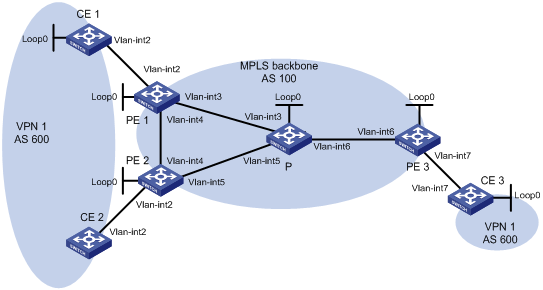
Table 8 Interface and IP address assignment
|
Device |
Interface |
IP address |
Device |
Interface |
IP address |
|
CE 1 |
Loop0 |
100.1.1.1/32 |
CE 3 |
Loop0 |
200.1.1.1/32 |
|
|
Vlan-int2 |
10.1.1.1/24 |
|
Vlan-int7 |
10.3.1.1/24 |
|
CE 2 |
Vlan-int2 |
10.2.1.1/24 |
PE 2 |
Loop0 |
2.2.2.9/32 |
|
PE 1 |
Loop0 |
1.1.1.9/32 |
|
Vlan-int2 |
10.2.1.2/24 |
|
|
Vlan-int2 |
10.1.1.2/24 |
|
Vlan-int4 |
40.1.1.2/24 |
|
|
Vlan-int3 |
30.1.1.1/24 |
|
Vlan-int5 |
50.1.1.1/24 |
|
|
Vlan-int4 |
40.1.1.1/24 |
P |
Loop0 |
3.3.3.9/32 |
|
PE 3 |
Loop0 |
4.4.4.9/32 |
|
Vlan-int3 |
30.1.1.2/24 |
|
|
Vlan-int6 |
60.1.1.2/24 |
|
Vlan-int5 |
50.1.1.2/24 |
|
|
Vlan-int7 |
10.3.1.2/24 |
|
Vlan-int6 |
60.1.1.1/24 |
Configuration procedure
1. Configure basic MPLS L3VPN:
¡ Configure OSPF on the MPLS backbone to allow the PEs and P device to learn the routes of the loopback interfaces from each other.
¡ Configure basic MPLS and MPLS LDP on the MPLS backbone to establish LDP LSPs.
¡ Establish an MP-IBGP peer relationship between the PEs to advertise VPN IPv4 routes.
¡ Configure the VPN instance of VPN 1 on PE 1 to allow CE 1 to access the network.
¡ Configure the VPN instance of VPN 1 on PE 2 to allow CE 2 to access the network.
¡ Configure the VPN instance of VPN 1 on PE 3 to allow CE 3 to access the network.
¡ Configure BGP as the PE-CE routing protocol, and redistribute routes of the CEs into the PEs.
For more information about basic MPLS L3VPN configurations, see "Configuring basic MPLS L3VPN."
2. Configure BGP AS number substitution:
# Configure BGP AS number substitution on PE 1, PE 2, and PE 3. For more information about the configuration, see "Configuring BGP AS number substitution."
# Display routing information on CE 2. The output shows that CE 2 has learned the route for 100.1.1.1/32 from CE 1. A routing loop has occurred because CE1 and CE 2 reside in the same site.
<CE2> display bgp routing-table ipv4 peer 10.2.1.2 received-routes
Total number of routes: 6
BGP local router ID is 1.1.1.9
Status codes: * - valid, > - best, d - dampened, h - history,
s - suppressed, S - stale, i - internal, e - external
a - additional-path
Origin: i - IGP, e - EGP, ? - incomplete
Network NextHop MED LocPrf PrefVal Path/Ogn
* >e 10.1.1.0/24 10.2.1.2 0 100?
* 10.2.1.0/24 10.2.1.2 0 0 100?
* 10.2.1.1/32 10.2.1.2 0 0 100?
* >e 10.3.1.0/24 10.2.1.2 0 100?
* >e 100.1.1.1/32 10.2.1.2 0 100 100?
* >e 200.1.1.1/32 10.2.1.2 0 100 100?
3. Configure BGP SoO attribute:
# On PE 1, configure the SoO attribute as 1:100 for CE 1.
<PE1> system-view
[PE1] bgp 100
[PE1-bgp-default] ip vpn-instance vpn1
[PE1-bgp-default-vpn1] address-family ipv4
[PE1-bgp-default-ipv4-vpn1] peer 10.1.1.1 soo 1:100
# On PE 2, configure the SoO attribute as 1:100 for CE 2.
<PE2> system-view
[PE2] bgp 100
[PE2-bgp-default] ip vpn-instance vpn1
[PE2-bgp-default-vpn1] address-family ipv4
[PE2-bgp-default-ipv4-vpn1] peer 10.2.1.1 soo 1:100
Verifying the configuration
# PE 2 does not advertise routes received from CE 1 to CE 2 because the same SoO attribute has been configured for the CEs. Display the routing table of CE 2. The output shows that the route 100.1.1.1/32 has been removed.
<CE2> display ip routing-table
Destinations : 14 Routes : 14
Destination/Mask Proto Pre Cost NextHop Interface
0.0.0.0/32 Direct 0 0 127.0.0.1 InLoop0
10.2.1.0/24 Direct 0 0 10.2.1.1 Vlan2
10.2.1.0/32 Direct 0 0 10.2.1.1 Vlan2
10.2.1.1/32 Direct 0 0 127.0.0.1 Inloop0
10.2.1.255/32 Direct 0 0 10.2.1.1 Vlan2
10.3.1.0/24 BGP 255 0 10.2.1.2 Vlan2
127.0.0.0/8 Direct 0 0 127.0.0.1 InLoop0
127.0.0.0/32 Direct 0 0 127.0.0.1 InLoop0
127.0.0.1/32 Direct 0 0 127.0.0.1 InLoop0
127.255.255.255/32 Direct 0 0 127.0.0.1 InLoop0
200.1.1.1/32 BGP 255 0 10.2.1.2 Vlan2
224.0.0.0/4 Direct 0 0 0.0.0.0 NULL0
224.0.0.0/24 Direct 0 0 0.0.0.0 NULL0
255.255.255.255/32 Direct 0 0 127.0.0.1 InLoop0
Configuring MPLS L3VPN FRR through VPNv4 route backup for a VPNv4 route
Network requirements
CE 1 and CE 2 belong to VPN 1.
Configure EBGP between CEs and PEs to exchange VPN routes.
Configure OSPF to ensure connectivity between PEs, and configure MP-IBGP to exchange VPNv4 routing information between PEs.
Configure MPLS L3VPN FRR on PE 1 to achieve the following purposes:
· When the link PE 1—PE 2 operates correctly, traffic from CE 1 to CE 2 goes through the path CE 1—PE 1—PE 2—CE 2.
· When BFD detects that the LSP between PE 1 and PE 2 fails, traffic from CE 1 to CE 2 goes through the path CE 1—PE 1—PE 3—CE 2.
Figure 27 Network diagram
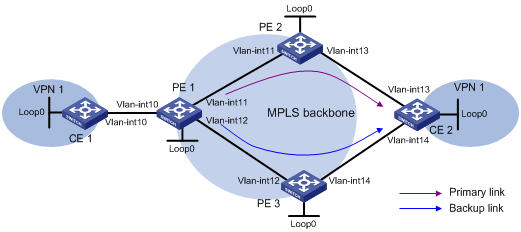
Table 9 Interface and IP address assignment
|
Device |
Interface |
IP address |
Device |
Interface |
IP address |
|
CE 1 |
Loop0 |
5.5.5.5/32 |
PE 1 |
Loop0 |
1.1.1.1/32 |
|
Vlan-int10 |
10.2.1.1/24 |
Vlan-int10 |
10.2.1.2/24 |
||
|
PE 2 |
Loop0 |
2.2.2.2/32 |
Vlan-int11 |
172.1.1.1/24 |
|
|
Vlan-int11 |
172.1.1.2/24 |
Vlan-int12 |
172.2.1.1/24 |
||
|
Vlan-int13 |
10.1.1.2/24 |
CE 2 |
Loop0 |
4.4.4.4/32 |
|
|
PE 3 |
Loop0 |
3.3.3.3/32 |
Vlan-int13 |
10.1.1.1/24 |
|
|
Vlan-int12 |
172.2.1.3/24 |
Vlan-int14 |
10.3.1.1/24 |
||
|
Vlan-int14 |
10.3.1.2/24 |
Configuration procedure
1. Configure IP addresses and masks for interfaces as shown in Table 9, and configure BGP and MPLS L3VPN. (Details not shown.)
For more information about configuring basic MPLS L3VPN, see "Configuring basic MPLS L3VPN."
2. Configure MPLS L3VPN FRR on PE 1:
# Create routing policy frr, and specify the backup next hop as 3.3.3.3 for the route to 4.4.4.4/32.
[PE1] ip prefix-list abc index 10 permit 4.4.4.4 32
[PE1] route-policy frr permit node 10
[PE1-route-policy] if-match ip address prefix-list abc
[PE1-route-policy] apply fast-reroute backup-nexthop 3.3.3.3
[PE1-route-policy] quit
# Configure FRR for VPN instance vpn1 to use routing policy frr.
[PE1] bgp 100
[PE1-bgp-default] ip vpn-instance vpn1
[PE1-bgp-default-vpn1] address-family ipv4 unicast
[PE1-bgp-default-ipv4-vpn1] fast-reroute route-policy frr
[PE1-bgp-default-ipv4-vpn1] quit
[PE1-bgp-default-vpn1] quit
# Specify the preferred value as 100 for BGP VPNv4 routes received from PE 2. This value is greater than the preferred value (0) for routes from PE 3, so PE 1 prefers the routes from PE 2.
[PE1-bgp-default] address-family vpnv4
[PE1-bgp-default-vpnv4] peer 2.2.2.2 preferred-value 100
[PE1-bgp-default-vpnv4] quit
[PE1-bgp-default] quit
Verifying the configuration
# Display detailed information about the route to 4.4.4.4/32 on PE 1. The output shows the backup next hop for the route.
[PE1] display ip routing-table vpn-instance vpn1 4.4.4.4 32 verbose
Summary Count : 1
Destination: 4.4.4.4/32
Protocol: BGP Process ID: 0
SubProtID: 0x1 Age: 00h00m03s
Cost: 0 Preference: 255
IpPre: N/A QosLocalID: N/A
Tag: 0 State: Active Adv
OrigTblID: 0x0 OrigVrf: default-vrf
TableID: 0x102 OrigAs: 300
NibID: 0x15000002 LastAs: 300
AttrID: 0x2 Neighbor: 2.2.2.2
Flags: 0x110060 OrigNextHop: 2.2.2.2
Label: 1146 RealNextHop: 172.1.1.2
BkLabel: 1275 BkNextHop: 172.2.1.3
Tunnel ID: Invalid Interface: Vlan-int11
BkTunnel ID: Invalid BkInterface: Vlan-int12
FtnIndex: 0x0 TrafficIndex: N/A
Connector: N/A PathID: 0x0
Configuring MPLS L3VPN FRR through VPNv4 route backup for an IPv4 route
Network requirements
CE 1 and CE 2 belong to VPN 1.
Configure EBGP between CEs and PEs to exchange VPN routes.
Configure OSPF to ensure connectivity between PEs, and configure MP-IBGP to exchange VPNv4 routing information between PEs.
Configure MPLS L3VPN FRR on PE 2 to achieve the following purposes:
· When the link PE 2—CE 2 operates correctly, traffic from CE 1 to CE 2 goes through the path CE 1—PE 1—PE 2—CE 2.
· When BFD detects that the link between PE 2 and CE 2 fails, traffic from CE 1 to CE 2 goes through the path CE 1—PE 1—PE 2—PE 3—CE 2.
Figure 28 Network diagram
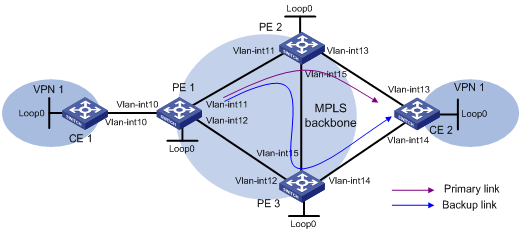
Table 10 Interface and IP address assignment
|
Device |
Interface |
IP address |
Device |
Interface |
IP address |
|
CE 1 |
Loop0 |
5.5.5.5/32 |
PE 2 |
Loop0 |
2.2.2.2/32 |
|
Vlan-int10 |
10.2.1.1/24 |
Vlan-int11 |
172.1.1.2/24 |
||
|
PE 1 |
Loop0 |
1.1.1.1/32 |
Vlan-int13 |
10.1.1.2/24 |
|
|
Vlan-int10 |
10.2.1.2/24 |
Vlan-int15 |
172.3.1.2/24 |
||
|
Vlan-int11 |
172.1.1.1/24 |
PE 3 |
Loop0 |
3.3.3.3/32 |
|
|
Vlan-int12 |
172.2.1.1/24 |
Vlan-int12 |
172.2.1.3/24 |
||
|
CE 2 |
Loop0 |
4.4.4.4/32 |
Vlan-int14 |
10.3.1.2/24 |
|
|
Vlan-int13 |
10.1.1.1/24 |
Vlan-int15 |
172.3.1.3/24 |
||
|
Vlan-int14 |
10.3.1.1/24 |
Configuration procedure
1. Configure IP addresses and masks for interfaces as shown in Table 9, and configure BGP and MPLS L3VPN. (Details not shown.)
For more information about configuring basic MPLS L3VPN, see "Configuring basic MPLS L3VPN."
2. Configure MPLS L3VPN FRR on PE 2:
# Configure the source IP address of BFD echo packets as 12.1.1.1.
<PE2> system-view
[PE2] bfd echo-source-ip 12.1.1.1
# Create routing policy frr, and specify the backup next hop as 3.3.3.3 for the route to 4.4.4.4/32.
[PE2] ip prefix-list abc index 10 permit 4.4.4.4 32
[PE2] route-policy frr permit node 10
[PE2-route-policy] if-match ip address prefix-list abc
[PE2-route-policy] apply fast-reroute backup-nexthop 3.3.3.3
[PE2-route-policy] quit
# Use echo-mode BFD to detect the primary route connectivity.
[PE2] bgp 100
[PE2-bgp-default] primary-path-detect bfd echo
# Configure FRR for VPN instance vpn1 to use routing policy frr.
[PE2-bgp-default] ip vpn-instance vpn1
[PE2-bgp-default-vpn1] address-family ipv4 unicast
[PE2-bgp-default-ipv4-vpn1] fast-reroute route-policy frr
# Specify the preferred value as 200 for BGP routes received from CE 2. This value is greater than the preferred value (0) for routes from PE 3, so PE 2 prefers the routes from CE 2.
[PE2-bgp-default-ipv4-vpn1] peer 10.1.1.1 preferred-value 200
[PE2-bgp-default-vpn1] quit
[PE2-bgp-default] quit
Verifying the configuration
# Display detailed information about the route to 4.4.4.4/32 on PE 2. The output shows the backup next hop for the route.
[PE2] display ip routing-table vpn-instance vpn1 4.4.4.4 32 verbose
Summary Count : 1
Destination: 4.4.4.4/32
Protocol: BGP Process ID: 0
SubProtID: 0x2 Age: 01h54m24s
Cost: 0 Preference: 10
IpPre: N/A QosLocalID: N/A
Tag: 0 State: Active Adv
OrigTblID: 0x0 OrigVrf: vpn1
TableID: 0x102 OrigAs: 300
NibID: 0x15000002 LastAs: 300
AttrID: 0x0 Neighbor: 10.1.1.1
Flags: 0x10060 OrigNextHop: 10.1.1.1
Label: NULL RealNextHop: 10.1.1.1
BkLabel: 1275 BkNextHop: 172.3.1.3
Tunnel ID: Invalid Interface: Vlan-int13
BkTunnel ID: 0x409 BkInterface: Vlan-int15
FtnIndex: 0x0 TrafficIndex: N/A
Connector: N/A PathID: 0x0
Configuring MPLS L3VPN FRR through IPv4 route backup for a VPNv4 route
Network requirements
CE 1 and CE 2 belong to VPN 1.
Configure EBGP between CEs and PEs to exchange VPN routes.
Configure OSPF to ensure connectivity between PEs, and configure MP-IBGP to exchange VPNv4 routing information between PEs.
Configure MPLS L3VPN FRR on PE 2 to achieve the following purposes:
· When the link PE 2—PE 3 operates correctly, traffic from CE 1 to CE 2 goes through the path CE 1—PE 1—PE 2—PE 3—CE 2.
· When BFD detects that the link between PE 2 and PE 3 fails, traffic from CE 1 to CE 2 goes through the path CE 1—PE 1—PE 2—CE 2.
Figure 29 Network diagram
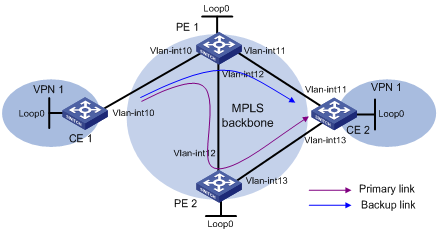
Table 11 Interface and IP address assignment
|
Device |
Interface |
IP address |
Device |
Interface |
IP address |
|
CE 1 |
Loop0 |
5.5.5.5/32 |
PE 2 |
Loop0 |
2.2.2.2/32 |
|
Vlan-int10 |
10.2.1.1/24 |
Vlan-int11 |
172.1.1.2/24 |
||
|
PE 1 |
Loop0 |
1.1.1.1/32 |
Vlan-int13 |
10.1.1.2/24 |
|
|
Vlan-int10 |
10.2.1.2/24 |
Vlan-int15 |
172.3.1.2/24 |
||
|
Vlan-int11 |
172.1.1.1/24 |
PE 3 |
Loop0 |
3.3.3.3/32 |
|
|
Vlan-int12 |
172.2.1.1/24 |
Vlan-int12 |
172.2.1.3/24 |
||
|
CE 2 |
Loop0 |
4.4.4.4/32 |
Vlan-int14 |
10.3.1.2/24 |
|
|
Vlan-int13 |
10.1.1.1/24 |
Vlan-int15 |
172.3.1.3/24 |
||
|
Vlan-int14 |
10.3.1.1/24 |
Configuration procedure
1. Configure IP addresses and masks for interfaces as shown in Table 9, and configure BGP and MPLS L3VPN. (Details not shown.)
For more information about configuring basic MPLS L3VPN, see "Configuring basic MPLS L3VPN."
2. Configure MPLS L3VPN FRR on PE 1:
# Create routing policy frr, and specify the backup next hop as 10.1.1.1 for the route to 4.4.4.4/32.
[PE1] ip prefix-list abc index 10 permit 4.4.4.4 32
[PE1] route-policy frr permit node 10
[PE1-route-policy] if-match ip address prefix-list abc
[PE1-route-policy] apply fast-reroute backup-nexthop 10.1.1.1
[PE1-route-policy] quit
# Configure FRR for VPN instance vpn1 to use routing policy frr.
[PE1] bgp 100
[PE1-bgp-default] ip vpn-instance vpn1
[PE1-bgp-default-vpn1] address-family ipv4 unicast
[PE1-bgp-default-ipv4-vpn1] fast-reroute route-policy frr
[PE1-bgp-default-ipv4-vpn1] quit
[PE1-bgp-default-vpn1] quit
# Specify the preferred value as 200 for BGP VPNv4 routes received from PE 2. This value is greater than the preferred value (0) for IPv4 unicast routes from CE 2, so PE 1 prefers the routes from PE 2.
[PE1-bgp-default] address-family vpnv4
[PE1-bgp-default-vpnv4] peer 3.3.3.3 preferred-value 200
[PE1-bgp-default-vpnv4] quit
[PE1-bgp-default] quit
Verifying the configuration
# Display detailed information about the route to 4.4.4.4/32 on PE 1. The output shows the backup next hop for the route.
[PE1] display ip routing-table vpn-instance vpn1 4.4.4.4 32 verbose
Summary Count : 1
Destination: 4.4.4.4/32
Protocol: BGP Process ID: 0
SubProtID: 0x1 Age: 00h00m04s
Cost: 0 Preference: 255
IpPre: N/A QosLocalID: N/A
Tag: 0 State: Active Adv
OrigTblID: 0x0 OrigVrf: default-vrf
TableID: 0x102 OrigAs: 300
NibID: 0x15000004 LastAs: 300
AttrID: 0x1 Neighbor: 3.3.3.3
Flags: 0x110060 OrigNextHop: 3.3.3.3
Label: 1275 RealNextHop: 172.3.1.3
BkLabel: NULL BkNextHop: 10.1.1.1
Tunnel ID: 0x409 Interface: Vlan-int15
BkTunnel ID: Invalid BkInterface: Vlan-int13
FtnIndex: 0x0 TrafficIndex: N/A

